GE MDS DS-MERCMIMO5A WiMax Industrial Radio User Manual 05 6302A01B Mercury MIMO Front w 5800
GE MDS LLC WiMax Industrial Radio 05 6302A01B Mercury MIMO Front w 5800
GE MDS >
User Manual
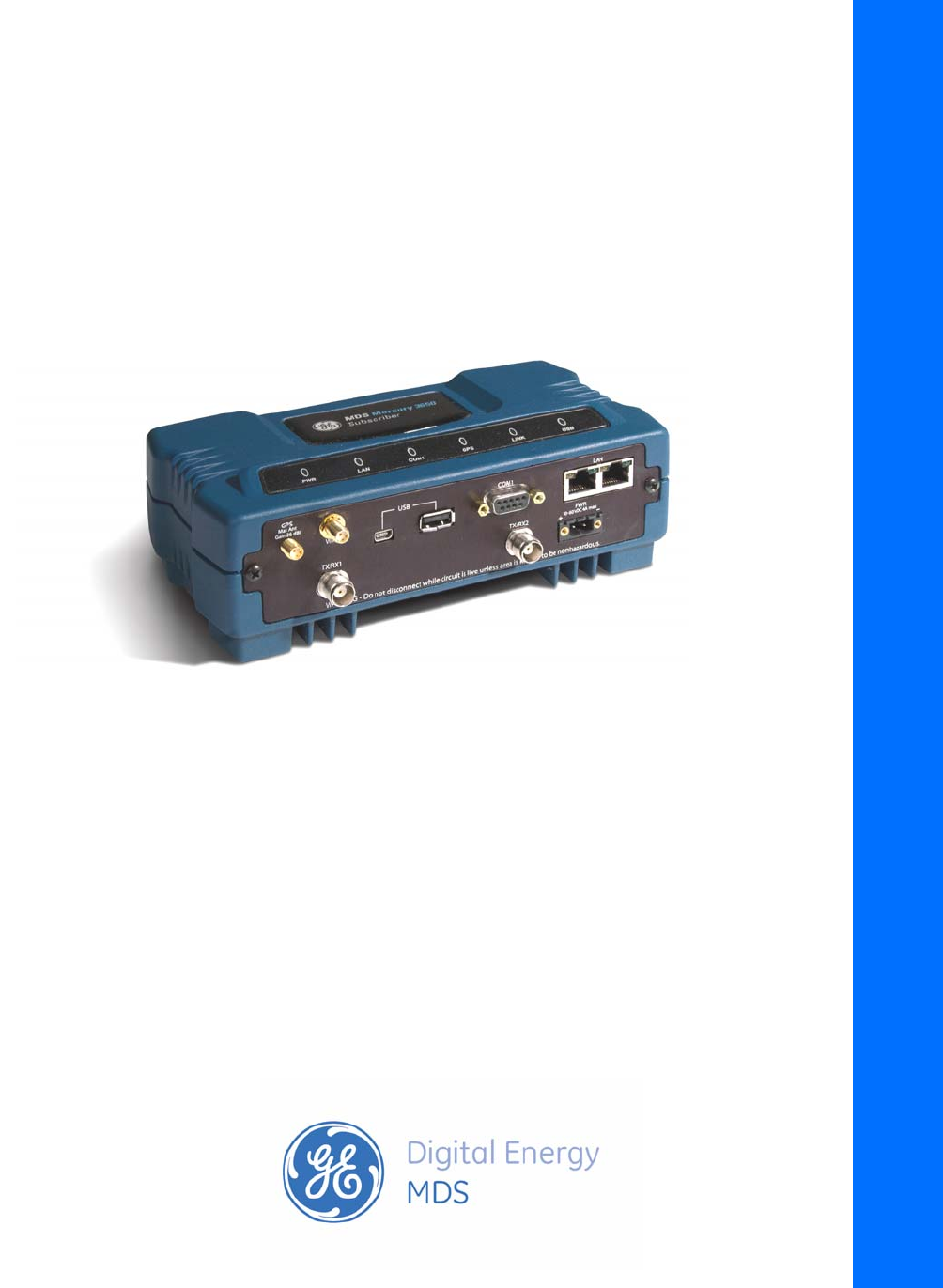
Installation and Operation Guide
Technical Manual
MDS 05-6302A01, Rev. B
FEBRUARY 2012
Covering Subscriber, Base, and Outdoor Subscriber Units
of the Mercury 16E Series
MDS Mercury Series
Secure, Long Range IP/Ethernet & Serial
Quick-Start instructions for this product are contained in publication 05-6301A01.
All GE MDS user guides are available online at www.gemds.com

MDS 05-6302A01, Rev. B MDS Mercury 16E Technical Manual i
TABLE OF CONTENTS
1.0 PRODUCT DESCRIPTION................................................................................................... 1
1.1 Product Models .............................................................................................................................2
1.2 Key Features .................................................................................................................................3
1.3 Key Specifications .........................................................................................................................3
Accessory Items...............................................................................................................................4
2.0 QUICK-START INSTRUCTIONS .......................................................................................... 5
2.1 Connecting to the Device Manager ............................................................................................... 5
2.2 Configure IP Address and Identity ................................................................................................. 6
2.3 Basic Connectivity .........................................................................................................................7
Setup for Maximum Throughput ......................................................................................................9
3.0 FEATURE DESCRIPTIONS ................................................................................................. 9
3.1 Security Features ..........................................................................................................................9
Overview ..........................................................................................................................................9
Authentication ................................................................................................................................10
User Authentication........................................................................................................................10
PKMv2 Device Authentication........................................................................................................10
Test Auth Mode (for Bench Test/Evaluation).................................................................................. 11
X.509 Certificates........................................................................................................................... 11
3.2 Multiple In / Multiple Out (MIMO) Operation ................................................................................ 11
3.3 ARQ and Hybrid ARQ .................................................................................................................12
ARQ Setup.....................................................................................................................................12
HARQ Setup ..................................................................................................................................13
4.0 PERFORMING COMMON TASKS ..................................................................................... 14
4.1 Basic Device Management ..........................................................................................................14
USB Console ................................................................................................................................. 14
Using Configuration Scripts ...........................................................................................................15
Perform Firmware Upgrade ...........................................................................................................16
Instructions for Completing the Firmware Upgrade Process .........................................................17
Configuring Networking Features for VLAN...................................................................................17
Configure Serial Data Interface for TCP, UDP, MODBUS..............................................................21
Configure QOS .............................................................................................................................. 25
Flow Parameters............................................................................................................................26
Quality of Service (QoS) Screen.................................................................................................... 27
Creating a Service Flow................................................................................................................. 28
QOS Example: Low Latency..........................................................................................................28
QOS Example: Controlling Bandwidth in Video Applications......................................................... 28
QOS Example: Prioritizing a Data Flow .........................................................................................29
QoS Traffic Shaping.......................................................................................................................31

ii MDS Mercury 16E Technical Manual MDS 05-6302A01, Rev. B
4.2 802.11 Wi-Fi Interface (Optional Feature) ...................................................................................31
802.11 Configuration Options ........................................................................................................32
802.11 Status .................................................................................................................................36
4.3 Radio Test Mode Menu ...............................................................................................................38
4.4 Configure Security Features & Integration with a RADIUS Server ..............................................39
Device Management Interface Configuration.................................................................................39
User Accounts................................................................................................................................40
4.5 RADIUS Server Configuration ..................................................................................................... 41
Creation of X.509 Certificates ........................................................................................................41
Load X.509 Certificates..................................................................................................................41
Configure SNMPV3........................................................................................................................ 42
4.6 Use of the Antenna Alignment Tool .............................................................................................45
5.0 TROUBLESHOOTING........................................................................................................ 46
5.1 LED INDICATORS .......................................................................................................................46
5.2 WiMAX Statistics .........................................................................................................................46
5.3 Common Troubleshooting Scenarios ..........................................................................................47
6.0 SITE INSTALLATION GUIDE ............................................................................................. 48
6.1 General Requirements ................................................................................................................ 48
Mounting Considerations ............................................................................................................... 49
6.2 Site Selection ..............................................................................................................................50
6.3 Equipment Grounding .................................................................................................................50
6.4 LAN Port ...................................................................................................................................... 51
6.5 COM1 Port .................................................................................................................................. 51
6.6 Antenna & Feedline Selection .....................................................................................................52
Antennas........................................................................................................................................52
Feedlines ....................................................................................................................................... 53
GPS Cabling & Antenna ................................................................................................................54
6.7 Conducting a Site Survey ............................................................................................................54
6.8 A Word About Radio Interference ................................................................................................ 54
6.9 Radio (RF) Measurements ..........................................................................................................55
Transmitter Power Output and Antenna System SWR ..................................................................55
Antenna Heading Optimization ......................................................................................................56
7.0 PERFORMANCE NOTES................................................................................................... 57
7.1 Wireless Bridge ...........................................................................................................................57
7.2 Distance-Throughput Relationship ..............................................................................................58
7.3 Data Latency—TCP versus UDP Mode ......................................................................................58
7.4 Packets-per-Second (PPS) .........................................................................................................58
7.5 Subscriber-to-Subscriber Traffic ..................................................................................................58
7.6 Interference has a Direct Correlation to Throughput ...................................................................59
7.7 Placing the Radio Behind a Firewall ............................................................................................ 59
8.0 INDEX OF CONFIGURATION PARAMETERS................................................................... 60

MDS 05-6302A01, Rev. B MDS Mercury 16E Technical Manual iii
9.0 dBm-WATTS-VOLTS CONVERSION CHART .................................................................... 76
Band History .................................................................................................................................. 77
Technical Details ............................................................................................................................77
Exclusion Zones.............................................................................................................................77
APPENDIX A—3650 MHz Band Information .............................................................................. 77
APPENDIX B—Glossary of Terms & Abbreviations.................................................................... 79
Copyright and Trademark
This manual and all software described herein is protected by Copyright: 2012 GE MDS, LLC. All
rights reserved. GE MDS, LLC reserves its right to correct any errors and omissions in this
publication. Modbus® is a registered trademark of Schneider Electric Corporation. All other
trademarks and product names are the property of their respective owners.
FCC Part 15 Notice
The transceiver series complies with Part 15 of the FCC Rules for a Class A digital device.
Operation is subject to the following two conditions: (1) this device may not cause harmful
interference, and (2) this device must accept any interference received, including interference that
may cause undesired operation. Any unauthorized modification or changes to this device without
the express approval of GE MDS may void the user’s authority to operate this device. Furthermore,
the Mercury Series is intended to be used only when installed in accordance with the instructions
outlined in this guide. Failure to comply with these instructions may void the user’s authority to
operate the device.
Industry Canada Notices (English and French)
Industry Canada rules (SRSP 301.7) require that the power to the antenna on an 1800-1830 MHz
installation shall not exceed 2 watts in any 1 MHz channel bandwidth.
Industrie Canada (PNRH 301.7) exigent que le pouvoir de l'antenne sur une installation de 1800 à
1830 MHz ne doit pas dépasser 2 watts en tout bande passante de 1 MHz canal.
For ODU installations: Under Industry Canada regulations, this radio transmitter may only
operate using an antenna of a type and maximum (or lesser) gain approved for the transmitter by
Industry Canada. To reduce potential radio interference to other users, the antenna type and its gain
should be so chosen that the equivalent isotropically radiated power (e.i.r.p.) is not more than that
necessary for successful communication.
This device complies with Industry Canada licence-exempt RSS standard(s). Operation is subject
to the following two conditions: (1) this device may not cause interference, and (2) this device must
accept any interference, including interference that may cause undesired operation of the device.

iv MDS Mercury 16E Technical Manual MDS 05-6302A01, Rev. B
Pour les installations ODU: Dans l'industrie des règlements du Canada, cet émetteur radio peut
fonctionner uniquement à l'aide d'une antenne d'un type et un maximum (ou moins) de gain
approuvé pour l'émetteur par Industrie Canada. Pour réduire le risque d'interférence aux autres
utilisateurs, le type d'antenne et son gain doivent être choisis afin que la puissance isotrope
rayonnée équivalente (PIRE) ne dépasse pas ce qui est nécessaire pour une communication réussie.
Cet appareil est conforme la norme d'Industrie Canada exempts de licence RSS (s). Son
fonctionnement est soumis aux deux conditions suivantes: (1) cet appareil ne peut pas causer
d'interférences, et (2) cet appareil doit accepter toute interférence, y compris les interférences qui
peuvent causer un mauvais fonctionnement de l'appareil.
For IDU Installations: This radio transmitter (identify the device by certification number) has
been approved by Industry Canada to operate with the antenna types listed below with the
maximum permissible gain and required antenna impedance for each antenna type indicated.
Antenna types not included in this list, having a gain greater than the maximum gain indicated for
that type, are strictly prohibited for use with this device.
Pour les installations UDI: Cet émetteur radio (identifier le périphérique par numéro de
certification) a été approuvé par Industrie Canada pour fonctionner avec les types d'antennes
énumérées ci-dessous avec le gain maximal admissible et l'impédance d'antenne requise pour
chaque type d'antenne indiqué. Types d'antennes ne figurent pas dans cette liste, ayant un gain
supérieur au gain maximum indiqué pour ce type, sont strictement interdites pour une utilisation
avec cet appareil.
RF Exposure Notices (English and French)
1800 MHz Models
Professional installation required. The radio equipment described in this guide emits radio
frequency energy. Although the power level is low, the concentrated energy from a directional
antenna may pose a health hazard. Do not allow people to come closer than 0.4 meters (15 inches)
to the antenna when the transmitter is operating in indoor or outdoor environments. More
information on RF exposure is available on the Internet at
www.fcc.gov/oet/info/documents/bulletins.
L'énergie concentrée en provenance d'une antenne directionnelle peut présenter un danger pour la
santé. Ne pas permettre aux gens de s'approcher à moins de 0.4 metres à l'avant de l'antenne lorsque
l'émetteur est en opération. On doit augmenter la distance proportionnellement si on utilise des
antennes ayant un gain plus élevé. Ce guide est destiné à être utilisé par un installateur
professionnel. Plus d'informations sur l'exposition aux rayons RF peut être consulté en ligne à
l'adresse suivante: www.fcc.gov/oet/info/documents/bulletins
3650 MHz Models
Professional installation required. The transceiver described here emits radio frequency energy.
Although the power level is low, the concentrated energy from a directional antenna may pose a
health hazard. Do not allow people to come closer than 25 cm (9.8 inches) to the antenna when the
transmitter is operating. This calculation is based on an 18 dBi panel antenna. Additional
information on RF exposure is available on the Internet at
www.fcc.gov/oet/info/documents/bulletins.

MDS 05-6302A01, Rev. B MDS Mercury 16E Technical Manual v
L'énergie concentrée en provenance d'une antenne directionnelle peut présenter un danger pour la
santé. Ne pas permettre aux gens de s'approcher à moins de 25 cm à l'avant de l'antenne lorsque
l'émetteur est en opération. On doit augmenter la distance proportionnellement si on utilise des
antennes ayant un gain plus élevé. Ce guide est destiné à être utilisé par un installateur
professionnel. Plus d'informations sur l'exposition aux rayons RF peut être consulté en ligne à
l'adresse suivante: www.fcc.gov/oet/info/documents/bulletins.
5800 MHz Models
Professional installation required. The radio equipment described in this guide emits radio
frequency energy. Although the power level is low, the concentrated energy from a directional
antenna may pose a health hazard. Do not allow people to come closer than 0.2 meters (8 inches)
to the antenna when the transmitter is operating in indoor or outdoor environments. More
information on RF exposure is available on the Internet at
www.fcc.gov/oet/info/documents/bulletins.
L'énergie concentrée en provenance d'une antenne directionnelle peut présenter un danger pour
lasanté. Ne pas permettre aux gens de s'approcher à moins de 0.2 metres à l'avant de l'antenne
lorsque l'émetteur est en opération. On doit augmenter la distance proportionnellement si on utilise
des antennes ayant un gain plus élevé. Ce guide est destiné à être utilisé par un installateur
professionnel. Plus d'informations sur l'exposition aux rayons RF peut être consulté en ligne à
l'adresse suivante: www.fcc.gov/oet/info/documents/bulletins
FCC Co-location Requirements: To meet FCC co-location requirements for transmitting
antennas, a 20 cm (7.87 inch) separation distance is required between the unit’s Wi-Fi and funda-
mental antennas.
Servicing Precautions
When servicing energized equipment, be sure to wear appropriate Personal Protective Equipment
(PPE). During internal service, situations could arise where objects accidentally contact or short
circuit components and the appropriate PPE would alleviate or decrease the severity of potential
injury. When servicing radios, all workplace regulations and other applicable standards for live
electrical work should be followed to ensure personal safety.
Ethernet and Serial Cables
The use of shielded Ethernet and serial cables are required to ensure EMC compliance when
operating this equipment.
Manual Revision and Accuracy
This manual was prepared to cover a specific version of firmware code. Accordingly, some screens
and features may differ from the actual unit you are working with. While every reasonable effort
has been made to ensure the accuracy of this publication, product improvements may also result in
minor differences between the manual and the product shipped to you. If you have additional
questions or need an exact specification for a product, please contact GE MDS using the
information at the back of this guide. In addition, manual updates can often be found on our web
site at www.gemds.com.

vi MDS Mercury 16E Technical Manual MDS 05-6302A01, Rev. B
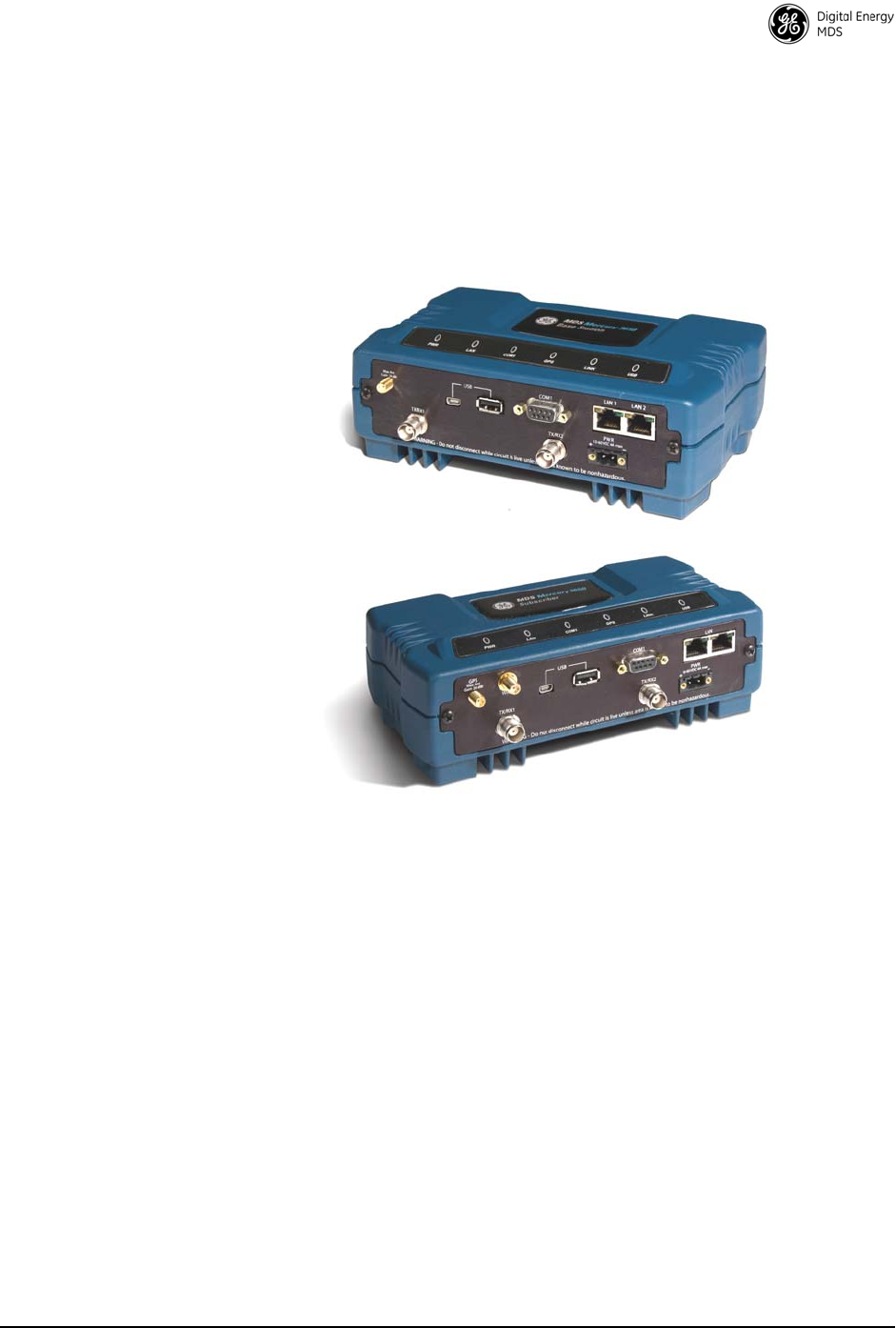
MDS 05-6302A01, Rev. B MDS Mercury 16E Technical Manual 1
1.0 PRODUCT DESCRIPTION
The GE MDS Mercury SeriesTM transceiver is an easy-to-install
WiMAX solution offering extended range, secure operation, and
multi-megabit performance in a compact and rugged package. Mercury
is ideally suited for wireless data applications in Smart Grid Electric, Oil
and Gas, Water/Wastewater, and other industrial uses in fixed locations
where range, reliability, throughput, and security are paramount.
Figure 1. Mercury MIMO Series Transceiver
(Top: Base Station, Bottom: Subscriber Unit)
The transceivers are commonly used to convey SCADA traffic,
automated metering, distribution automation, command and control
traffic, text documents, graphics, e-mail, video, Voice over IP (VoIP),
and a variety of other application data between field devices and
WAN/LAN-based entities.
Based on multi-carrier Orthogonal Frequency Division Multiplexing
(OFDM), the transceiver features high speed/low latency, Quality of
Service (QoS), Ethernet and serial encapsulation, and MIMO
(multiple-input and multiple output)-enhanced performance. It also
provides enhanced security including 128-bit AES encryption and
EAP-TLS IEEE 802.1x Device Authentication. These features make the
Mercury system the best combination of security, range, and speed of
any industrial wireless solution on the market today.
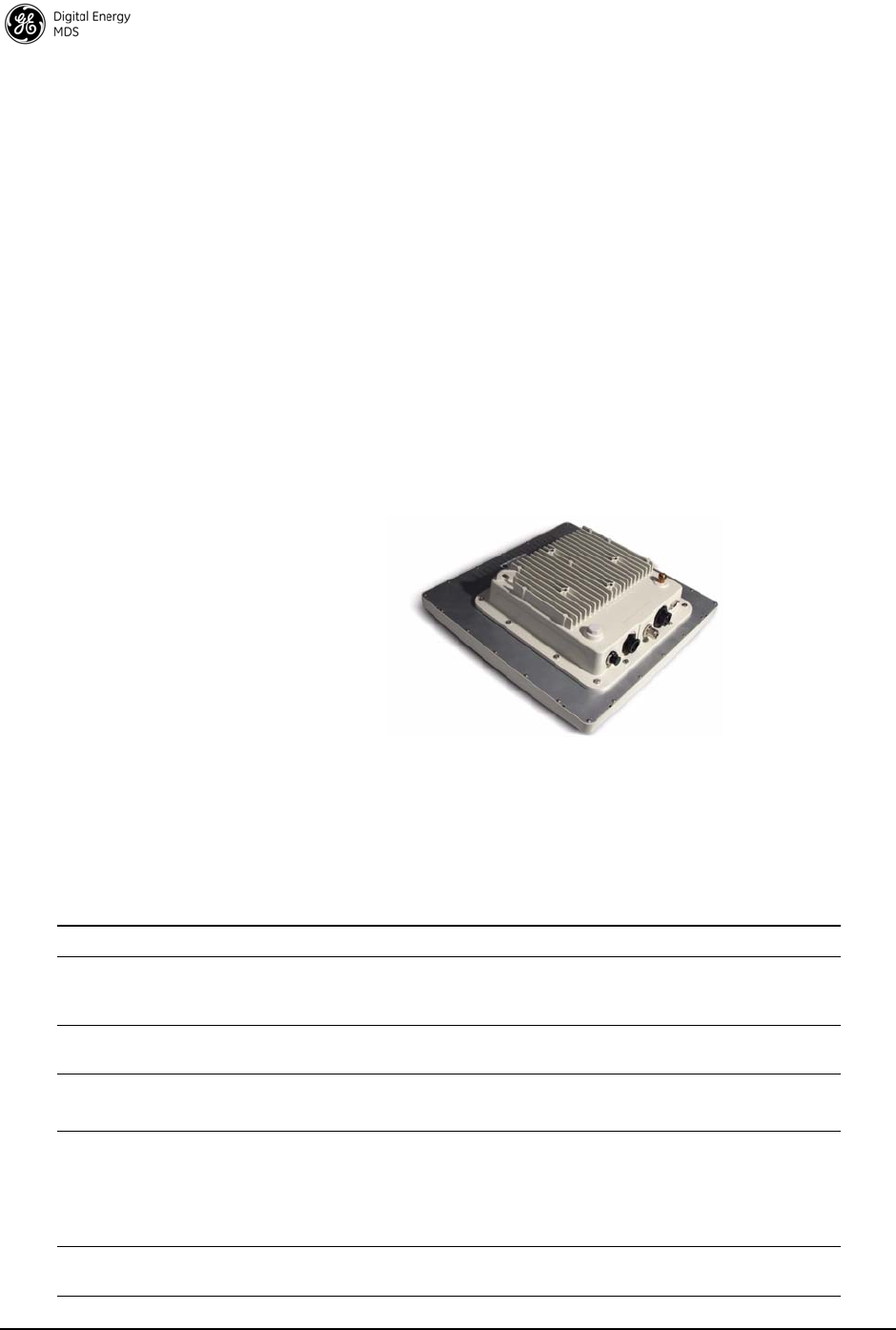
2 MDS Mercury 16E Technical Manual MDS 05-6302A01, Rev. B
For installation and setup instructions for these products, please refer to
GE MDS publication 05-6301A01.
1.1 Product Models
The Mercury transceiver is available in several different product
models:
• The indoor Base Station (BS) acts as the center of each
point-to-multipoint network. It has two RJ-45 Ethernet ports
and a DB-9 RS-232 serial port for data connections.
• The indoor Subscriber Unit (SU) acts as one of the multipoints
in the network. It also has two RJ-45 Ethernet ports and a DB-9
RS-232 serial port for data connections.
• The Outdoor Subscriber Unit (ODU) is a weatherproof ver-
sion of the standard Subscriber Unit. The ODU has one RJ-45
Ethernet port and a DB-9 serial port for data connections.
Invisible place holder
Figure 2. Outdoor Subscriber Unit (ODU)
(Back of unit, showing interface connectors)
The key features and options for the various models are listed in Table 1
below.
Table 1. Mercury Models and Interfaces
Interfaces Base Station Indoor Subscriber Outdoor Subscriber
Ethernet
ports
2 RJ-45 Ethernet
with built-in Layer 2
switch
2 RJ-45 Ethernet with built-in
Layer 2 switch
1 RJ-45 Ethernet. May be
ordered as Power over Ethernet
or AC model
Serial
port
1 DB-9 RS-232 1 DB-9 RS-232 1 DB-9 RS-232
USB 1 USB host port
1 USB device port
1 USB host port
1 USB device port
1 USB host port
WiMAX Dual TNC for MIMO
(1800 and 3650
models)
Dual SMA for MIMO
(5800 model)
Dual TNC for MIMO
(1800 and 3650 models)
Dual SMA for MIMO (5800
model)
Internal RF connections
GPS Internal receiver
with SMA connector
Optional internal receiver with
SMA connector
None

MDS 05-6302A01, Rev. B MDS Mercury 16E Technical Manual 3
1.2 Key Features
The Mercury transceiver supports:
• WiMAX IEEE 802.16e-2005 interoperability
• Scalable OFDM using 512 or 1024 subcarriers
• 2x2 MIMO on all models supporting Matrix A and Matrix B
Space Time Coding, Spatial Multiplexing, Maximum Ratio
Combining, and Maximum Likelihood Detection
• PKMv2 security including AES-CCMP 128-bit encryption,
EAP-TLS, and X.509 digital certificates
• Hybrid ARQ up to Category 4
• Adaptive modulation from QPSK with 1/2-rate FEC coding to
64-QAM with 5/6-rate coding
• Quality of Service (QoS) including:
• Unsolicited Grant Service (UGS), Real-time polling service
(RTPS), Non-real-time polling service (nRTPS), Enhanced
real-time polling service (eRTPS), Best Effort (BE)
• Wi-Fi service available as an option for ODU and Subscriber
units
• SNMP MIB support: MIB-II, GE MDS Proprietary, WiMAX*
* Expected availablity 2012
1.3 Key Specifications
Table 2 lists key operational specifications for the Mercury Transceiver.
Antenna External External 15 dBi panel ant. for 1800 model
18 dBi panel ant. for 3650 model
18 dBi panel ant for 5800 model
Wi-Fi -- Optional reverse SMA
connector
Optional reverse SMA connector
Table 1. Mercury Models and Interfaces (Continued)
Table 2. Key Specifications
Primary Wireless IEEE 802.16E-2005 WiMAX
Local Interfaces
(indoor models)
Two channel WiMAX, TNC connectors (1800, 3650 models)
Two channel WiMAX, SMA connectors (5800 model)
Dual 10/100 Ethernet, RJ-45, auto-sense, auto-mdix
DB9 Serial Port
USB host and device ports
GPS receiver, SMA connector (Optional on Subscriber)
Wi-Fi, Reverse SMA connector
Local Interfaces
(ODU models)
(1) 10/100 Ethernet, RJ-45, auto-sense, auto-mdix
DB-9 Serial Port
USB Host Port

4 MDS Mercury 16E Technical Manual MDS 05-6302A01, Rev. B
Accessory Items
GE MDS can provide accessory items for use with the Transceiver,
including the items listed below:
• Antennas—Omni and directional types
• USB cable, CAT5, serial DB9s
• RF coaxial cable, connectors
Frequency Bands 1800 to 1830 MHz (Industry Canada)
3650 to 3675 MHz (FCC, Industry Canada)
5725 to 5825 MHz (FCC)
Frequency step size 250 kHz
Bandwidth 3.5, 5, 7, 8.75, and 10 MHz
Wi-Fi (optional) 2.4 GHz, 802.11b/g protocol
RF Power Output 1800 and 3650 models: 30 dBm for all units, except 23 dBm
for 3650 ODU
5800 model: +18.0 dBm for ODU; 17.7 dBm for indoor units
(limited for FCC compliance)
Transmitter Dynamic
Range
60 dB, 1 dB step size
Antenna 1800 Subscriber: 15 dBi panel, dual-polarized
1800 Base Station: 12 dBi sector, dual-polarized, 120o
beamwidth
3650 Subscriber: 18 dBi panel, dual-polarized
3650 Base Station: 14 dBi sector, dual-polarized, 120o
beamwidth
5800 Subscriber: 18 dBi panel, dual-polarized
5800 Base Station: 15.5 dBi sector, dual-polarized, 90o
beamwidth
Input Power Indoor units: 10 to 60 VDC
Outdoor units:
Power over Ethernet
10 to 60 Vdc
110/220 Vac
Power Consumption
(average ratings)
1800 Base: 17 Watts
1800 Subscriber: 10 Watts
1800 ODU: 10 Watts
3650 Base: 13 Watts
3650 Subscriber: 8 Watts
3650 ODU: 8 Watts
5800 Base: 14 Watts
5800 Subscriber: 9 Watts
5800 ODU: 9 Watts
Operating
Temperature
-30 to +70 degrees C
Unit Dimensions
(excluding
connectors)
Indoor Base/Subscriber:
4.5 x 7.75 x 2.75 inches (11.43 x 19.69 x 6.99 cm)
ODU: 14.5 x 14.5 x 4.5 inches (37 x 37 x 11.5 cm)
Table 2. Key Specifications (Continued)
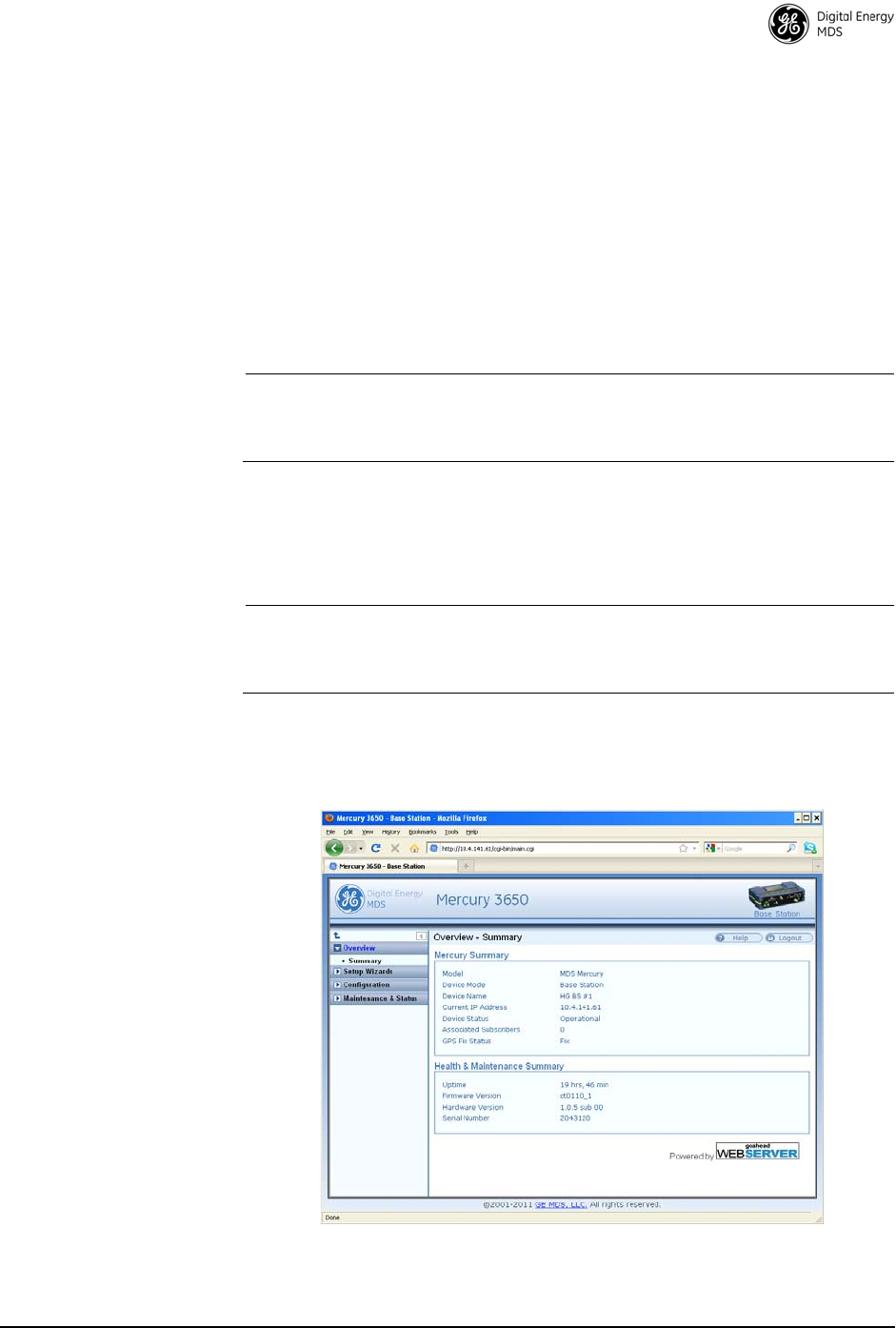
MDS 05-6302A01, Rev. B MDS Mercury 16E Technical Manual 5
2.0 QUICK-START INSTRUCTIONS
2.1 Connecting to the Device Manager
The Mercury transceiver contains a built-in web server, known as the
Device Manager, for configuration and diagnostics. Each transceiver
needs to have some basic configuration parameters set before placing
the unit in service. To start the Device Manager, connect an Ethernet
cable from the Mercury to the PC used for configuration. The radio’s
Ethernet interfaces have auto-sense detection allowing a
straight-through or crossover cable to be used.
NOTE: The PC used for radio management must be in the radio’s
default IP Subnet for communications to take place. It can be
changed once the desired IP address is chosen.
To manage the radio, start a web browser and enter the unit’s IP address.
The transceiver defaults to an IP address 192.168.1.1 and netmask
255.255.255.0. The Mercury will prompt for a username and password.
The default entries for both of these fields are admin.
NOTE: In case of a lost password and an inability to login, see
“Common Troubleshooting Scenarios” on Page 47 for details
on resetting the password and the unit's configuration.
Once connected to the Device Manager, the summary page shown in
Figure 3 is displayed.
Invisible place holder
Figure 3. Mercury Summary Page Example
(Shows connection after IP address has been changed)
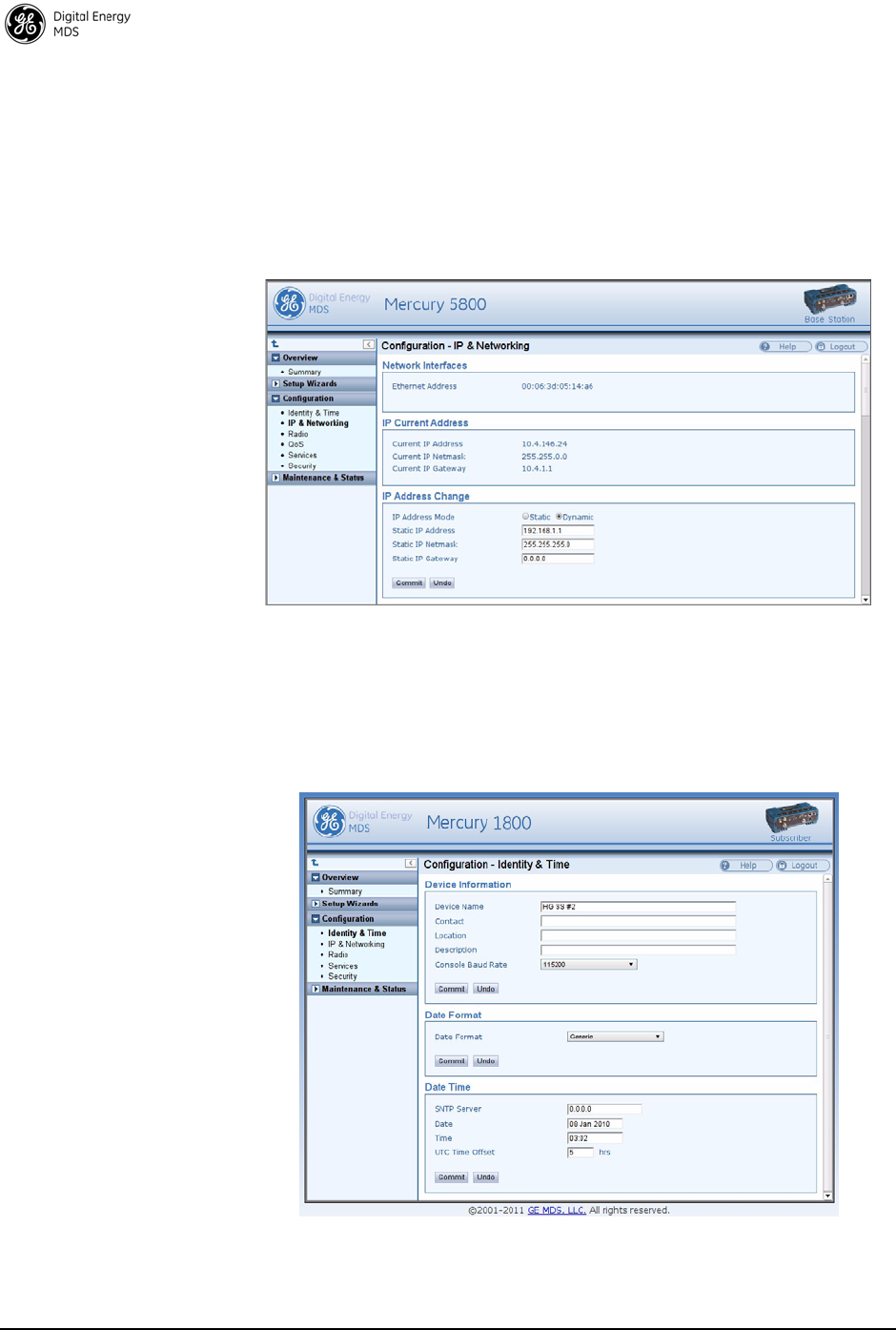
6 MDS Mercury 16E Technical Manual MDS 05-6302A01, Rev. B
2.2 Configure IP Address and Identity
The IP Address of the unit is configured on the Configuration - IP &
Networking page. The IP address and netmask should be set according to
the network configuration defined by the system administrator. Note
that if the IP address is changed, the web browser session will need to
be re-started with the new configuration.
Invisible place holder
Figure 4. Mercury Configuration-IP & Networking
In addition to the IP address, the unit can be configured with an optional
Device Name for ease of administration. The name can be set on the
Configuration - Identity & Time page.
Invisible place holder
Figure 5. Mercury Configuration —Identity & Time
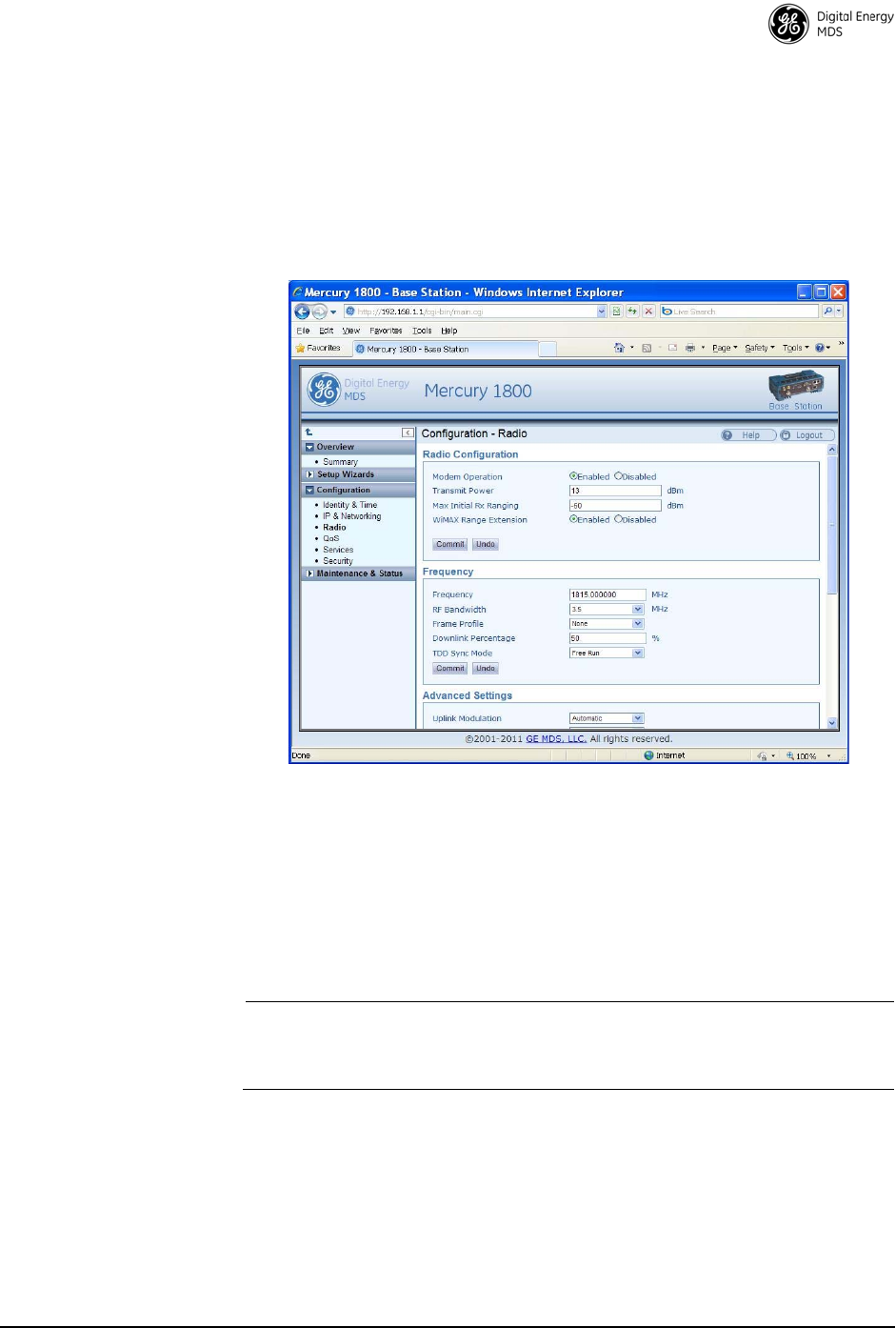
MDS 05-6302A01, Rev. B MDS Mercury 16E Technical Manual 7
2.3 Basic Connectivity
To establish basic connectivity between a Base Station and a Subscriber,
start the configuration with the Base Station. The IP address and Device
Name will be as set from the factory (or by the previous user). With a
factory-fresh unit, the Device Name will blank. The Configuration - Radio
page contains the key parameters for configuring the WiMAX interface.
Invisible place holder
Figure 6. Mercury Configuration—Radio
For 3650 units, the frequency defaults to 3662.5 MHz and the bandwidth
is set to 3.5 MHz. These default values are sufficient to perform
benchtop testing prior to final installation. Set the frequency and
bandwidth to the same values on the Base Station and Subscriber. If
performing the test on a table, cable the units as shown in Figure 7. The
attenuator cables should be connected to the radio’s TX/RX connectors.
NOTE: The frequency default for the 1800 model is 1815 MHz. For
the 5800 model it is 5800 MHz. Not all frequencies can be
configured for each bandwidth. Ranges differ.
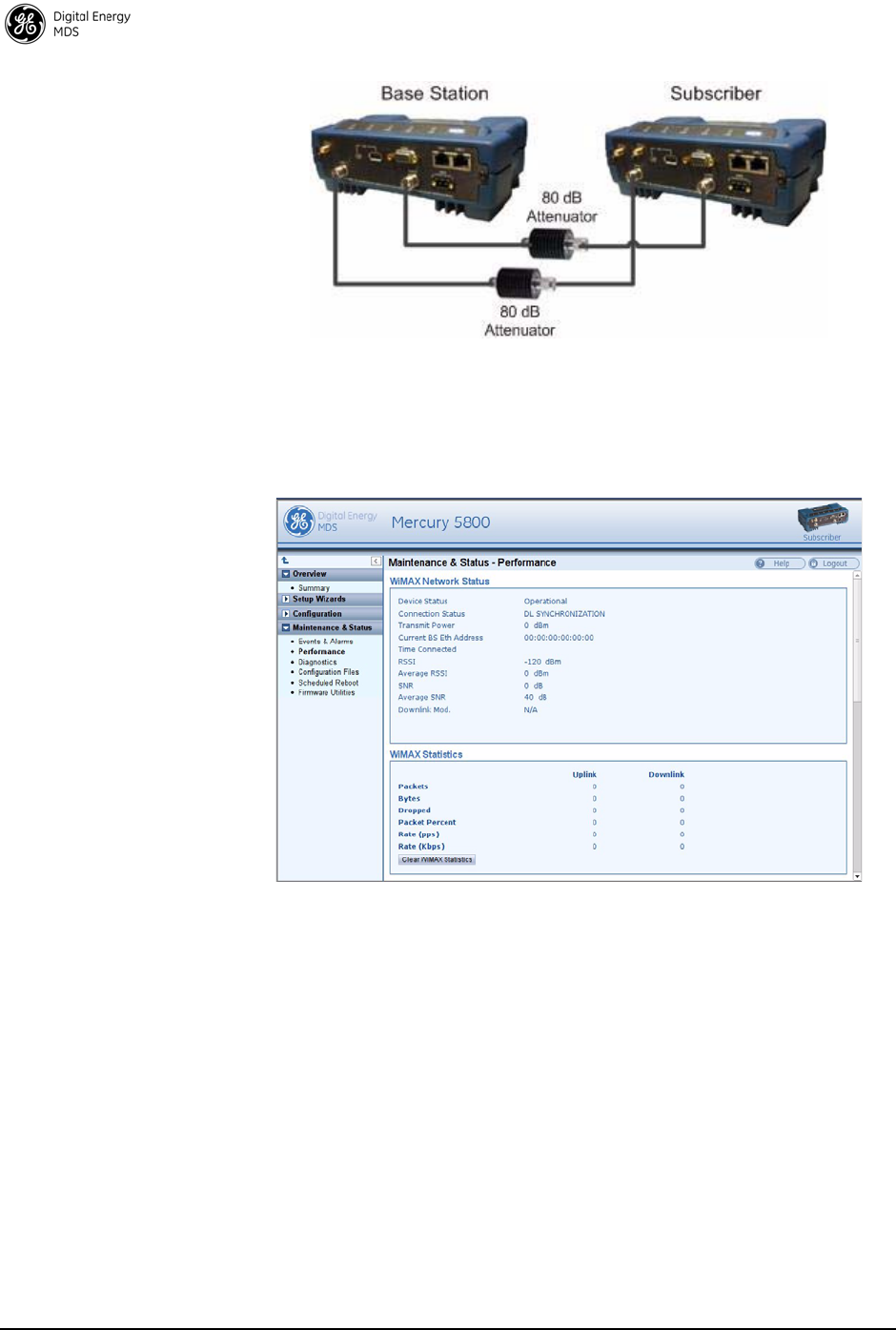
8 MDS Mercury 16E Technical Manual MDS 05-6302A01, Rev. B
Invisible place holder
Figure 7. Benchtop Test Setup
Use the Maintenance & Status - Performance page on the Subscriber to
monitor the establishment of the link.
Invisible place holder
Figure 8. Maintenance and Status Screen
The WiMAX Network Status will display a Connection Status of
OPERATIONAL when the Subscriber is successfully linked to the Base
Station. This pane also displays the signal strength and quality. For a
cabled, benchtop test, an RSSI of -70 dBm is acceptable. For a -70 dBm
signal, a signal-to-noise ratio (SNR) of 28 dB or greater is expected.

MDS 05-6302A01, Rev. B MDS Mercury 16E Technical Manual 9
Setup for Maximum Throughput
To demonstrate maximum throughput, several configuration changes
must be made. In addition, the link needs to be cabled according to
Figure 7, with a strong signal, that is, above -70 dBm. If necessary, the
link attenuation should be adjusted to reach the desired RSSI level. The
transmit power of the Base Station should be reduced to 10 dBm to
ensure that the Subscriber only receives the signal through the cables
and not directly from enclosure to enclosure.
With this strong signal the modulation rate downlink and uplink should
be 64QAM FEC 5/6. There may need to be data flow, such as an ICMP
ping, in order to have the modems shift up to this modulation rate. Both
the Base Station and Subscriber need to be set for MIMO Type Matrix
A/B. The Base Station should have HARQ (4) enabled and ARQ
disabled. These changes are made using the Configuration - Radio page.
This setup and configuration can be used with any RF bandwidth.
Approximate aggregate throughput for each bandwidth is given below.
* 28 Mbps aggregate throughput was attained at 64QAM FEC 5/6, 10 Mhz bandwidth
and rev. 2.0.4 product firmware.
3.0 FEATURE DESCRIPTIONS
3.1 Security Features
Overview
The Mercury transceiver employs many security features to keep the
device, network, and data secure. Some of these features include
WiMAX PKMv2, EAP-TLS, and AES-CCMP encryption on the
WiMAX interface and HTTPS, SNMPv3, and RADIUS authentication
for the configuration interfaces.
Table 3. Throughput Ratings (Nominal)
Bandwidth Aggregate
Throughput
3.5 MHz 7 Mbps
5 MHz 10 Mbps
7 MHz 15 Mbps
8.75 MHz 16 Mbps
10 MHz 28 Mbps*

10 MDS Mercury 16E Technical Manual MDS 05-6302A01, Rev. B
Authentication
Authentication is the process by which one network entity verifies that
another entity is who or what it claims to be and has the right to join the
network and use its services. Authentication in wireless SCADA
networks has two primary forms: User Authentication and Device
Authentication. User authentication allows a device to ensure that a user
may access the device's configuration and services. Device
authentication allows a network server to verify that a hardware device
may access the network.
User Authentication
The Mercury transceiver requires user login with an account and
password in order to access the Device Manager menu. This process can
be managed locally in which the device stores the user account
information in its on-board non-volatile memory, or remotely in which
a RADIUS server is used. The transceiver has two local accounts:
operator and admin. The operator account has read-only access to
configuration parameters and performance data. The admin account has
read-write access to all parameters and data.
NOTE: The Operator account has access through the web, console,
Telnet, or SSH interfaces, but settings may only be viewed, not
changed.
To centralize the management of user accounts, a RADIUS server may
be used. Each Mercury transceiver must be configured with the IP
address, port, shared secret, and authentication protocol of a RADIUS
server. When a user attempts to login, the credentials are forwarded to
the RADIUS server for validation.
PKMv2 Device Authentication
The IEEE 802.16e-2005 WiMAX standard uses PKMv2 for securing
the wireless channel. PKMv2 stands for Privacy Key Management
version 2. The Privacy Key Management protocol is used to exchange
keying material from the Base Station to the Subscriber. This keying
material is used to encrypt data so that it is secure during transport over
the air. The encryption keys are routinely rotated to ensure security.
Initial keying material is obtained during the device authentication
process. This occurs when a Subscriber attempts to join a Base Station.
The Base Station initiates an EAP-TLS negotiation with the Subscriber
to begin the device authentication process. The Subscriber is only
allowed to transmit EAP messages until the authentication has finished
successfully. The Base Station forwards messages to the RADIUS
server where the decision to allow the Subscriber to join is made. If the
Subscriber authenticates successfully and the RADIUS server allows

MDS 05-6302A01, Rev. B MDS Mercury 16E Technical Manual 11
the Subscriber to join the network, then the data encryption keying
material is sent to the Base Station. The Base Station then continues the
PKM protocol to further derive keying material that is used to secure
transmissions between the Base Station and the Subscriber.
The Subscriber must be configured with X.509 certificates that are
appropriate for the Public Key Infrastructure (PKI) in which they are
deployed. These certificates are used to identify and authenticate the
Subscriber to the RADIUS sever.
Test Auth Mode (for Bench Test/Evaluation)
The Device Auth Mode can be set to Test Auth to enable encryption on
the WiMAX link without requiring an AAA server. To use this mode,
both the Base Station and the Subscriber(s) must be set to Test Auth. In
this arrangement, the Base Station acts as a simple AAA server and
authenticates the subscriber without actually evaluating its identity
certificate. This is convenient when doing bench testing in which the
performance with encryption enabled is to be measured but without the
complexity of setting up a AAA server and identity certificates.
X.509 Certificates
A digital certificate, also known as an X.509 certificate, is a file that
contains identification data and asymmetric key material. Each
certificate contains a Common Name that identifies the user or device
that owns the certificate. The primary information in the certificate is the
public key for the user or device and a digital signature proving the
authenticity of the certificate's contents.
The Mercury transceiver uses X.509 certificates in the EAP-TLS
handshake during device authentication as described in the PKMv2
section above.
NOTE: Certificates must start with the serial number of the radio to
work.
3.2 Multiple In / Multiple Out (MIMO) Operation
MIMO stands for Multiple In / Multiple Out. The Mercury transceiver
features 2x2 MIMO on all models. This means that there are two full
transmit and receive channels on each device. The use of 2x2 MIMO
causes the Mercury transceiver to have higher throughput and greater
range and coverage than single channel devices in the same
environment.

12 MDS Mercury 16E Technical Manual MDS 05-6302A01, Rev. B
There are two operating modes that the Mercury supports. The first
mode is Matrix A in which the Mercury uses Space-Time Coding (STC)
on the transmitter to allow it to send the same data on each channel but
coded differently in order to get transmit diversity. On the receive side,
the Mercury transceiver uses Maximum Ratio Combining (MRC) to
more accurately reconstruct the received signal by using both receive
channels.
The second mode is Matrix B in which the Mercury uses Spatial
Multiplexing (SM) to send different data flows on each channel
allowing it to effectively double the amount of data transmitted. The
Mercury offers a Matrix A/B setting in which the transceivers determine
in real time which mode, Matrix A or Matrix B, to use according to the
channel conditions. This determination is made based on the SNR and
Packet Error Rate (PER).
GE MDS sells antennas that are dual-polarized for MIMO applications.
This includes sector antennas for Base Stations and panel antennas for
Subscribers. Each antenna has two feed lines, one for the vertically
polarized element, and one for the horizontally polarized element.
3.3 ARQ and Hybrid ARQ
Automatic Retransmission Request (ARQ) enables retransmission of
erroneous or lost data packets. Hybrid ARQ (HARQ) combines forward
error correction with ARQ retransmissions to improve performance at
lower RF signal levels.
With ARQ, the receiver discards erroneous packets and requests
retransmission. With HARQ, erroneous packets are saved by the
receiver and combined with the retransmitted data. Generally, HARQ
provides better throughput than ARQ. While ARQ and HARQ can be
enabled at the same time, it is not recommended to do so because
throughput will be less than if either ARQ or HARQ was enabled on its
own.
ARQ and HARQ can be enabled or disabled in the ARQ/HARQ Settings
table of the Configuration-Radio page on the Base Station.
ARQ Setup
ARQ utilizes a sliding window approach where a “window” of blocks
can be transmitted without receiving acknowledgement from the
receiver. ARQ blocks that are unacknowledged will be resent. You can
specify the block and window size at the Base Station, as well as Block
Lifetime, Transmitter Delay, and Receiver Delay.
• ARQ Block Size - The size, in bytes, of the block of data to be
considered for retransmission.

MDS 05-6302A01, Rev. B MDS Mercury 16E Technical Manual 13
• ARQ Window Size - The number of blocks of ARQ data that
can be transmitted without receiving an acknowledgment.
• ARQ Block Lifetime - The maximum period, in milliseconds,
that the ARQ block is considered still valid and can be retrans-
mitted.
• ARQ Transmitter Delay - The amount of delay time, in millisec-
onds, at the transmitter.
• ARQ Receiver Delay - The amount of delay time, in millisec-
onds, at the receiver. The Receiver Delay taken together with
the Transmitter Delay determines the total ARQ retry timeout.
Use the Configuration - Radio page to set ARQ parameters on the Base
Station. ARQ/HARQ settings are located at the bottom of the page.
Invisible place holder
Figure 9. Configuration—Radio
(ARQ/HARQ Settings)
HARQ Setup
A HARQ Category may be set on the Subscriber. Higher category
numbers provide a higher number of HARQ channels and more bursts
per frame. Therefore, the greatest throughput will be obtained at HARQ
category 4. For more information on HARQ categories, refer to the
WiMAX Forum Protocol Implementation Conformance Statement
(PICS), or the IEEE-802.16 Standard, OFDMA Parameters.
Use the Configuration - Radio page on the Subscriber to set the HARQ
Category value. This value is located at the bottom of the page.
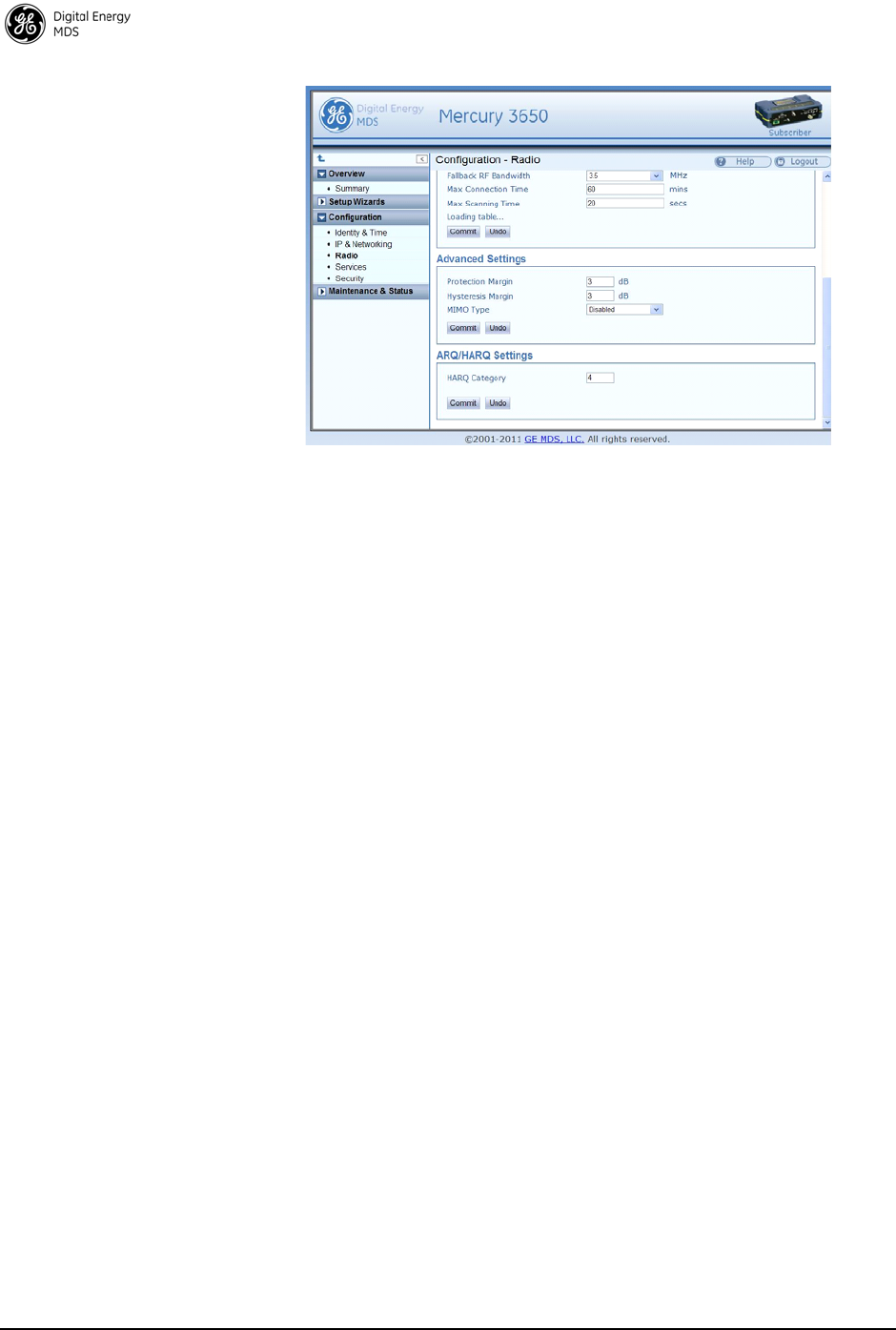
14 MDS Mercury 16E Technical Manual MDS 05-6302A01, Rev. B
Invisible place holder
Figure 10. Configuration—Radio
(HARQ Category Setting)
4.0 PERFORMING COMMON TASKS
4.1 Basic Device Management
There are several ways to configure and monitor the Mercury
transceiver. The most common method is to use a web browser to
connect to the device's HTTP/HTTPS server. This can be done by
opening a web browser and entering the Mercury's IP address.
Another way to connect, especially if the IP address is unknown, is to
use the USB interface. Simply connect a standard-A/mini-B USB cable
between the Mercury transceiver and the PC or laptop. A Windows
device driver needs to be installed if the USB console port is to be used.
This driver is available from GE MDS.
USB Console
Installing the Gadget
Serial Driver: To connect a PC or laptop to the transceiver's USB port, a serial device
driver needs to be installed on the PC or laptop. This can be done by
downloading the gserial.zip file from the GE MDS website and extracting
the contents to a temporary folder. Next, right-click on the gserial.inf file
and click Install. Once this is completed, the PC is ready to be connected
to the Mercury transceiver's USB device (gadget) port.
Connecting the
device to a Windows
PC:
Upon reboot or power-cycle of the transceiver, wait at least 60 seconds
before connecting it to the PC. Connect the USB Mini-B port on the
transceiver to a USB port on the PC (the USB type A connector on the
Mercury will not work). Next, on the PC, run the following:
Start>>Control Panel>>System>>Hardware>>Device Manager
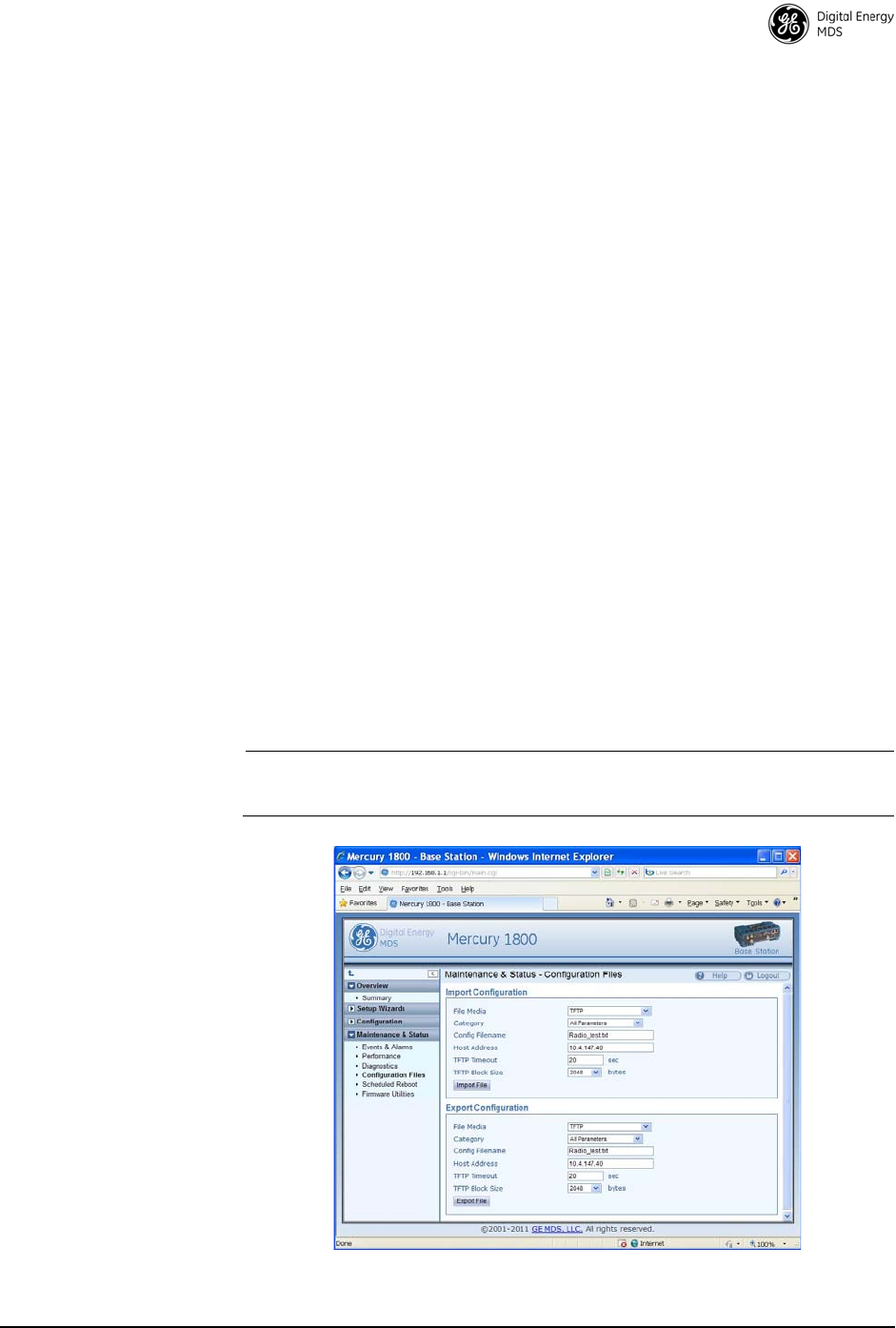
MDS 05-6302A01, Rev. B MDS Mercury 16E Technical Manual 15
Next, expand the group labeled Ports (COM & LPT). A new COM port will
appear as Gadget Serial when the device is connected. Open a new session
for the newly added COM port using a terminal program such as
PuTTY, HyperTerminal, ProComm, etc. Note that the baud rate will be
ignored as this is not an actual serial port.
Using Configuration Scripts
Configuration scripts can be used to save, restore, and copy
configurations from unit to unit. The script is a text file containing a
simple list of parameter names and values. A snippet of a configuration
file follows:
IP Address: 192.168.1.1 ; IP address of the unit
IP Netmask: 255.255.0.0 ; IP netmask of the unit
RF bandwidth: 3.5 ; WiMAX RF bandwidth
Frequency: 3662.5 ; WiMAX operating frequency
To get started with configuration files, it is easiest to have a unit
generate a file. The generated file can then be saved, modified, and/or
downloaded to another unit in identical fashion. The transceiver’s
Maintenance & Status - Configuration Files page (Figure 11) can be used to
generate the file. The file can be transferred to and from the unit via
TFTP, FTP, SFTP, or USB flash drive. Choose the appropriate value for
the File Media parameter. If using TFTP, FTP, or SFTP, configure the
Host Address parameter with the IP address of the host server.
The use of SFTP/FTP requires a username, password, and port for
transfer of data.
NOTE: If using a USB flash drive, it must be formatted for use by
Microsoft Windows (FAT32 format), and be non-encrypted.
Invisible place holder
Figure 11. Maintenance & Status—Configuration Files

16 MDS Mercury 16E Technical Manual MDS 05-6302A01, Rev. B
Perform Firmware Upgrade
New firmware is periodically released by GE MDS to deliver new
features and performance enhancements. The latest firmware can be
downloaded from the GE MDS website at www.gemds.com.
There are several ways to load new firmware on the Mercury
transceiver. The firmware file can be transferred using FTP, SFTP,
TFTP, or a USB flash drive. The selection between FTP, SFTP, or TFTP
must be made according to the user's network and security environment.
The process of loading firmware is essentially the same regardless of
network protocol chosen.
Instructions for
loading firmware
using FTP
1. Download the .mpk firmware file from GE MDS.
2. Place the .mpk firmware file on a server that has an FTP server run-
ning. Ensure that the file is placed in a folder accessible to the FTP
server.
3. Follow the instructions for configuring IP network access for the
Mercury transceiver (see “Basic Connectivity” on Page 7).
4. Navigate to the Maintenance & Status - Firmware Utilities page on the
transceiver’ Device Manager.
5. Set the Host Address to the IP address of the server on the network.
Set the Firmware Filename to the folder and filename as it appears
to the FTP server.
6. If the FTP server does not support an anonymous user, enter the
username and password for an account on the FTP server (and the
port number if it is not 21).
7. Press the Program button and wait for the file transfer to complete.
Instructions for
loading firmware
using a USB flash
drive
1. Download the .mpk firmware file from GE MDS
2. Place the .mpk firmware file on USB flash drive that is formatted for
use by Microsoft Windows (FAT32 format, and non-encrypted).
3. Insert the flash drive into the radio’s USB port. Navigate to the Main-
tenance & Status - Firmware Utilities page.
4. Set the Firmware Filename to the folder and filename as it appears on
the USB flash drive.
5. Press the Program button and wait for the file transfer to complete.
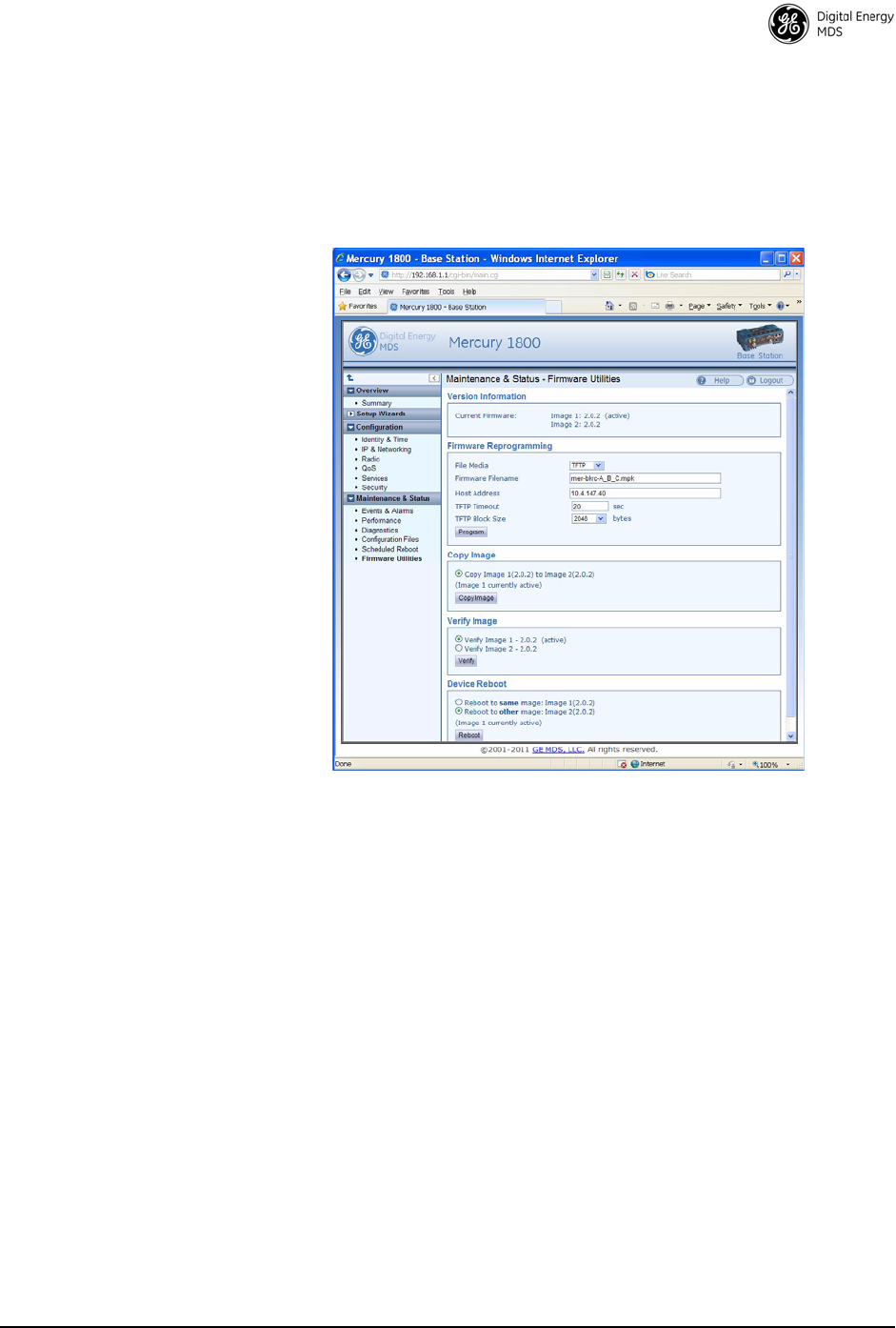
MDS 05-6302A01, Rev. B MDS Mercury 16E Technical Manual 17
Instructions for Completing the Firmware Upgrade Process
(Applies to all loading methods above)
Once the file transfer is complete, select the new image under the Device
Reboot pane (see Figure 12) and press the Reboot button. The transceiver
verifies the integrity of the new firmware image and then reboots to it.
Invisible place holder
Figure 12. Maintenance & Status—Firmware Utilities Screen
Configuring Networking Features for VLAN
The Mercury supports IEEE 802.1Q, or VLAN tagging. VLANs, or
Virtual LANs, are used to create multiple logical networks that share an
existing physical network. There are a number of parameters available
for configuring how the transceivers behave when VLAN is enabled and
they are explained below.
When VLAN is enabled, a Mercury transceiver has two IP addresses:
one for the Management VLAN and one for the Serial VLAN.
Subscribers and ODU units with 802.11 Wi-Fi may also have a Wi-Fi
VLAN with a unique IP address.

18 MDS Mercury 16E Technical Manual MDS 05-6302A01, Rev. B
The Management VLAN IP address allows administrators to manage
the transceiver using the usual networked interfaces, such as Web,
telnet, and SNMP. Those services are only available through the
Management VLAN IP address while VLAN is enabled. The
Management VLAN IP Address settings are configured under the
MGMT VLAN Subnet Configuration Menu or the IP Address section
on the web page.
The Serial VLAN IP address allows SCADA networks to connect to the
Serial Terminal Server on the transceiver. The terminal server provides
access to the transceiver's local COM port so IP networks can utilize
serial devices. The terminal server is only available through the Serial
VLAN IP address while VLAN is enabled. The Serial VLAN IP
Address settings are configured under the Serial VLAN Subnet
Configuration Menu or the Serial VLAN IP Address section on the web
page.
When configuring VLAN, Ids must be assigned to the Management
VLAN, Serial VLAN, LAN 1 Port and LAN 2 Port. The Management
VLAN ID and Serial VLAN ID cannot be the same value.
The Wi-Fi VLAN is available on subscribers and ODU units that have
802.11 Wi-Fi. In order to use the Wi-Fi VLAN, the 802.11 Mode must
be set to Access Point. The Wi-Fi VLAN may share a VLAN ID with the
Serial VLAN. In this case, the Wi-Fi interface is part of the Serial
VLAN and shares the Serial VLAN’s IP address. If the Wi-Fi VLAN is
given a unique VLAN ID, it operates as a third, separate VLAN and can
be configured with its own IP address under the Wi-Fi VLAN Subnet
Configuration menu on the web page.
The VLAN Ethport Mode parameter determines how IP frames are
handled with respect to VLAN tagging. When the mode is set to Access,
a VLAN tag is added to IP frames that are received on that Ethernet port.
In the case of the LAN 1 port, the LAN 1 VLAN ID would be added to
the frame prior to forwarding the frame over-the-air. Likewise, the tag
is removed from the IP frame for traffic that is going to be transmitted
out of the Ethernet port. This is the mode that is most likely to be used
on Subscribers where the LAN connected to the subscriber is
non-VLAN and it would be tagged before it reaches the Base Station.
When the VLAN Ethport Mode is set to Trunk, IP frames received from
the Ethernet port are not automatically tagged. It is assumed that the
LAN that is connected to the Ethport is already tagged with VLAN Ids.
This mode is most likely to be used on Base Stations where the network
connected to the Base Station Ethports are VLAN aware.
The last mode for VLAN Ethport Mode is Auto, where the Subscriber
or Base Station can automatically determine whether or not to tag
frames based on the traffic it receives.

MDS 05-6302A01, Rev. B MDS Mercury 16E Technical Manual 19
Management VLAN Mode determines whether or not VLAN tags will
be applied to Management frames. When the mode is set to Tagged
Mode, management frame s are expected to already have the
management VLAN ID attached to them. If management frames arrive
at the trunk port without a VLAN ID and the mode is Tagged Mode, then
those frames will be ignored. In Native Mode, management frames do
not need the VLAN tag. The frames will automatically be included in
the Native VLAN, which is the management VLAN.
The Default Route IF parameter determines which VLAN will be used
to route traffic that does not yet have an entry in the ARP table. This
parameter should be set to the VLAN that typically has the most routing
to be performed since this should help route traffic quickly through that
VLAN.
The following is an example configuration that has a VLAN enabled
network connected to the Base Station and a non-VLAN enabled
network connected to the Subscriber. This configuration would allow
VLAN enabled devices in the Base Station network to communicate
with non-VLAN devices in the Subscriber network.
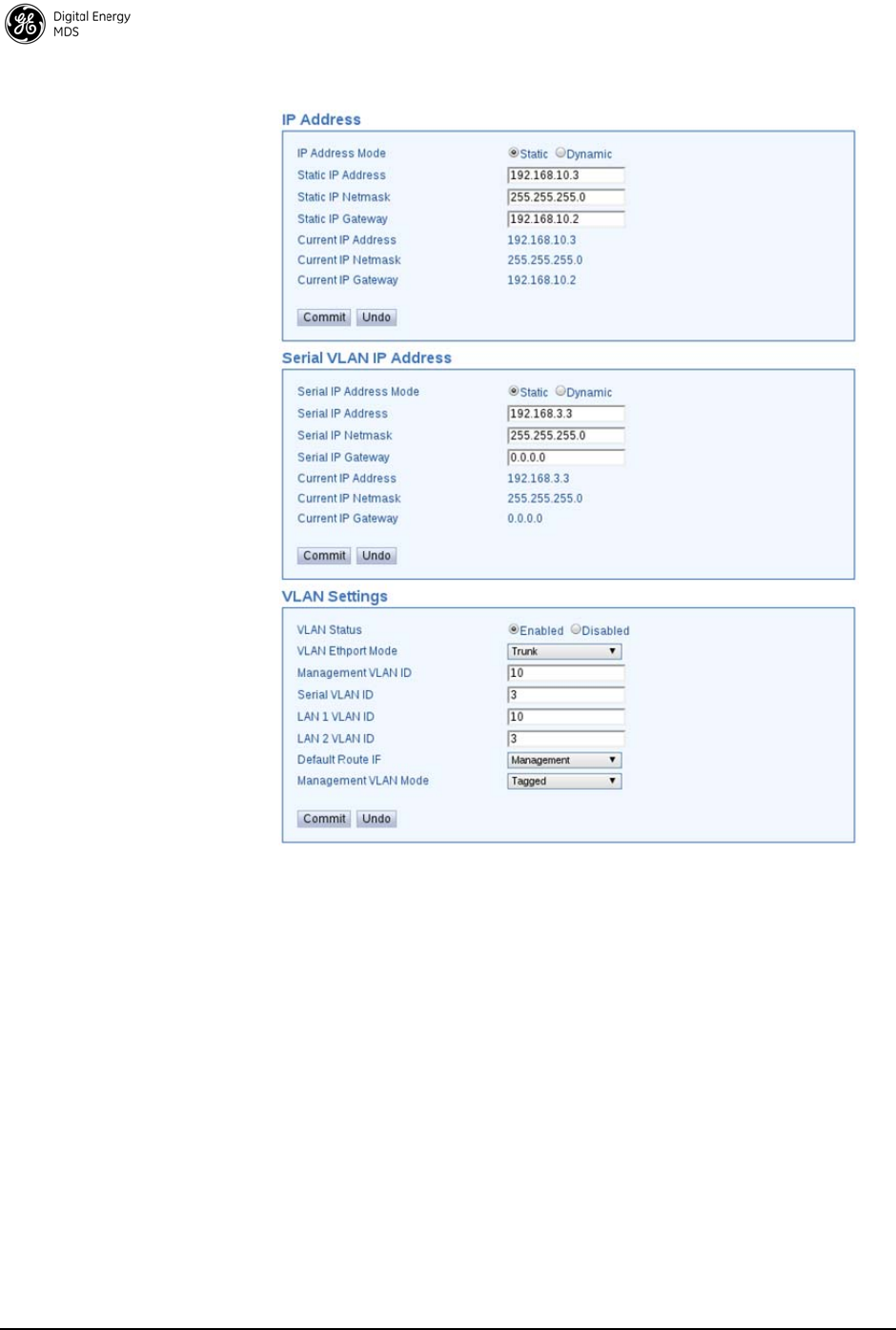
20 MDS Mercury 16E Technical Manual MDS 05-6302A01, Rev. B
The Base Station is configured as follows:
Figure 13. Base Station VLAN Configuration Settings
The Subscriber Unit is configured as follows:
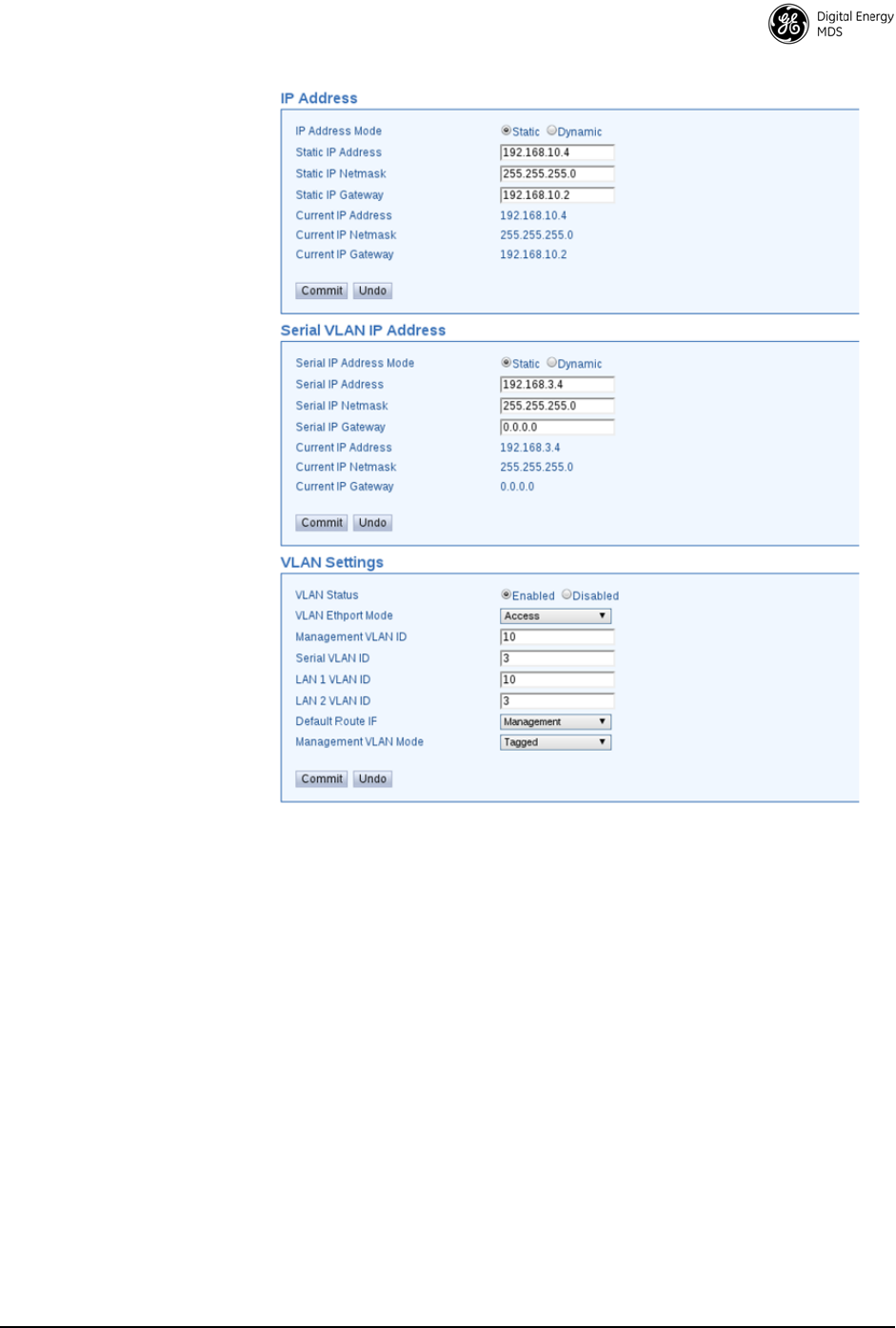
MDS 05-6302A01, Rev. B MDS Mercury 16E Technical Manual 21
Invisible place holder
Figure 14. Subscriber Unit VLAN Configuration Settings
Configure Serial Data Interface for TCP, UDP, MODBUS
Overview The transceiver includes an embedded serial device server that provides
transparent encapsulation of serial data in IP packets. In this capacity, it
acts as a gateway between serial and network-based devices. Two
common scenarios are PC applications using IP to communicate with
remote devices, and serial PC applications communicating with remote
serial device over an IP network.
Note that the transceiver's serial port is configured as Data
Communications Equipment (DCE). A null-modem cable is required if
the serial device to be connected is also DCE.

22 MDS Mercury 16E Technical Manual MDS 05-6302A01, Rev. B
Dual Purpose
Capability The transceiver's COM1 serial port is able to function as a local console
or in data encapsulation mode. When the Com 1 Status parameter is set to
Enabled, the port operates in data encapsulation mode. It can be reverted
back to console mode by entering the escape sequence +++ at the data
mode baud rate (or using the web interface to disable).
TCP and UDP
Encapsulation The serial data can be encapsulated in either TCP or UDP packets. TCP
provides a connection-oriented link with end-to-end acknowledgement
of data, but with some added overhead. UDP provides a connection-less
best-effort delivery service with no acknowledgement.
Most polled protocols will be best served by UDP service since many of
these protocols have built-in error recovery mechanisms. UDP can
provide the needed multi-drop operation by means of multicast
addressing.
On the other hand, TCP services are best suited for applications that do
not have a recovery mechanism or error-correction but need the
guaranteed delivery that TCP provides while affording the extra
overhead required.
Serial Encapsulation Transparent encapsulation, or IP tunneling, provides a mechanism to
encapsulate serial data into an IP envelope. In operation, all of the bytes
received through the serial port are put into the data portion of a TCP or
UDP packet. In the same manner, all data bytes received in a TCP or
UDP packet are output through the serial port.
When data arrives at the serial port, it is buffered until the packet is
received completely. There are two events that signal an end-of-packet
to the transceiver: a period of time since the last byte was received, or a
number of bytes that exceed the buffer size. Both of these triggers are
user-configurable.
One transceiver can be used for IP-to-serial encapsulation in which it
communicates with another IP-based device. On the other hand, two
transceivers can be used to create a serial-to-serial channel using TCP or
UDP between them.
TCP Client and
Server modes A TCP session has a server side and a client side. You can configure the
transceiver to act as a server, a client, or both.
TCP servers listen and wait for requests from TCP clients to establish a
session. A TCP client is an application running on a device somewhere
on the network. TCP clients actively attempt to establish a connection
with a TCP server. In the case of the transceiver, this happens whenever
data is received on the serial port.
The transceiver can also operate in Client/Server mode in which it
operates in either client or server mode, depending on which event
occurs first; either receiving data on the serial port, or receiving a
request to open a TCP connection from a remote client.

MDS 05-6302A01, Rev. B MDS Mercury 16E Technical Manual 23
The transceiver keeps a TCP session open until internal timers that
monitor traffic expire. Once a TCP session is closed, it must be opened
again before traffic can flow. The timeout period, labeled TCP Keepalive,
is user-configurable and should be set to match the application data flow
and balance a trade-off between responsiveness and connection
overhead. TCP connection establishment can introduce a slight delay to
data delivery, as it performs handshaking between the client and server.
On the other hand, leaving a session open can waste bandwidth due to
session management packets.
UDP Multicast IP addressing provides a way to do a limited broadcast to a specific
group of devices. This is known as “multicast addressing.” Many IP
routers and switches support this functionality. Multicast addressing
requires the use of a specific set of IP addresses set apart by the Internet
Assigned Numbers Authority (IANA). UDP multicast is generally used
to transport polling protocols used in SCADA applications where
multiple remote devices will receive and process the same poll message.
As part of the multicast implementation, the radio sends IGMP
membership reports, IGMP queries, and responds to membership
queries. It defaults to V2 membership reports, but responds to both V1
and V2 queries.
The Multicast Mode parameter on the transceiver must be set
appropriately in order for the transceiver to receive multicast traffic.
Setting the Multicast Mode parameter causes the transceiver to join the
multicast group.
Data Buffering The Buffer Size and Inter-packet Delay parameters are user-configurable.
They work together to determine how many bytes are captured in a
single packet. When a number of bytes equal to the Buffer Size are
received from the serial port, those bytes are encapsulated and sent as a
TCP or UDP packet. If a delay equal to the Inter-packet Delay is
experienced after some number of bytes, then the bytes received up to
the delay are encapsulated and sent as a TCP or UDP packet.
Setup Wizard The Serial Wizard handles configuration of the serial port. To access the
Serial Wizard, navigate to the Setup Wizards link on the left sidebar. The
Setup Wizard - Serial Configuration page appears.
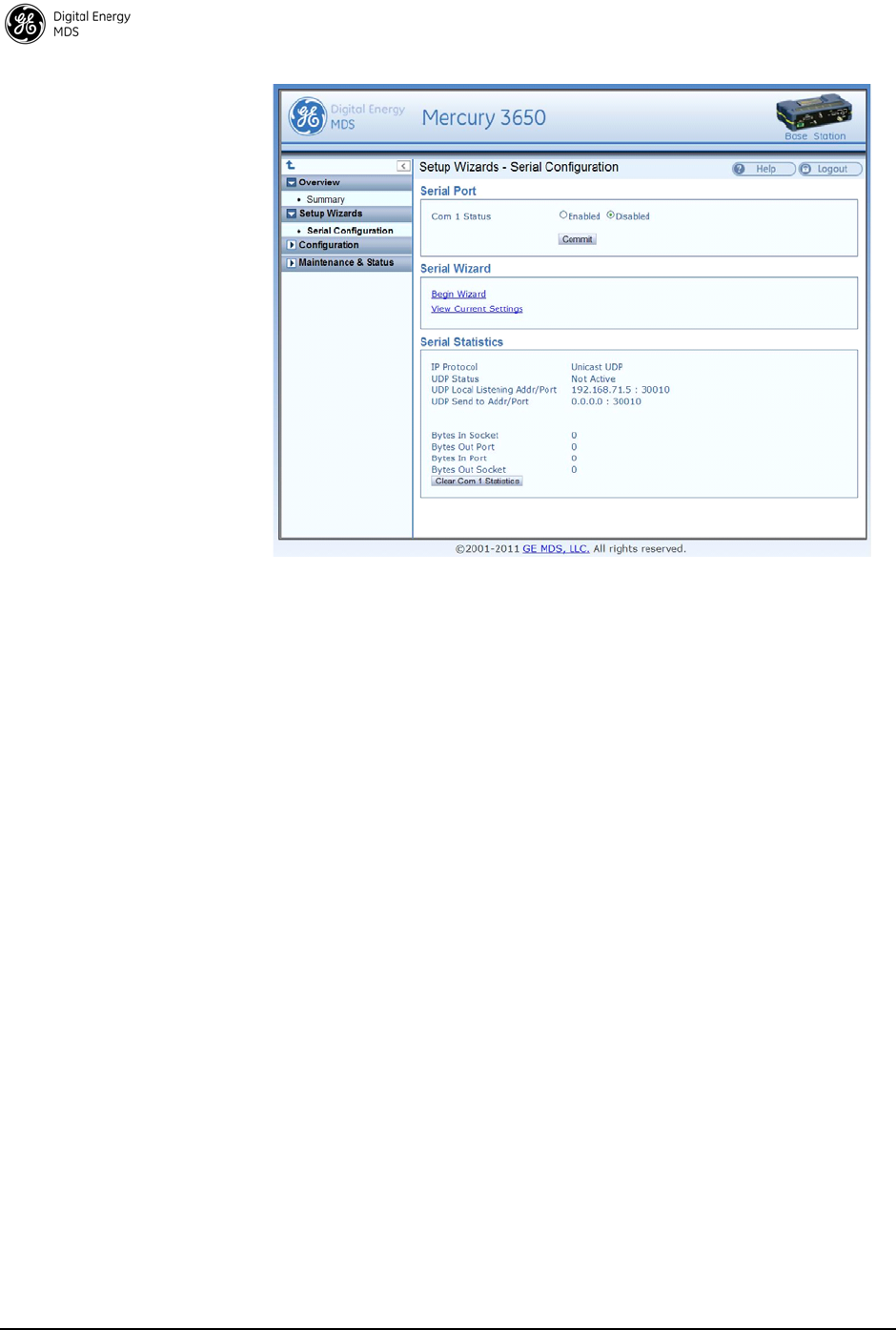
24 MDS Mercury 16E Technical Manual MDS 05-6302A01, Rev. B
Invisible place holder
Figure 15. Setup Wizards—Serial Configuration
To begin the Serial Wizard, click the Begin Wizard link under the Serial
Wizard table.
The wizard prompts for the protocol to configure. The options are TCP,
UDP, or TCP/MODBUS.
Example: TCP Server
The following procedure describes how to setup a TCP Server.
1. Select TCP as the IP protocol.
2. Select the desired TCP mode - client or server or client/server.
3. Next, specify the local port to use for receiving TCP data from the
host. Click Continue Wizard to continue.
4. Specify the buffer size and inter-packet delay, then click Continue
Wizard.
5. Choose whether to enable or disable COM1 for communication. If
Enable is selected, COM1 operates as a TCP Server as soon as the
Serial Wizard is complete. If Disable is selected, the settings are
saved upon completion of the Serial Wizard, and COM1 may be
enabled for data transfer at a later time in the Serial Configuration
main page. Click Continue Wizard to continue.
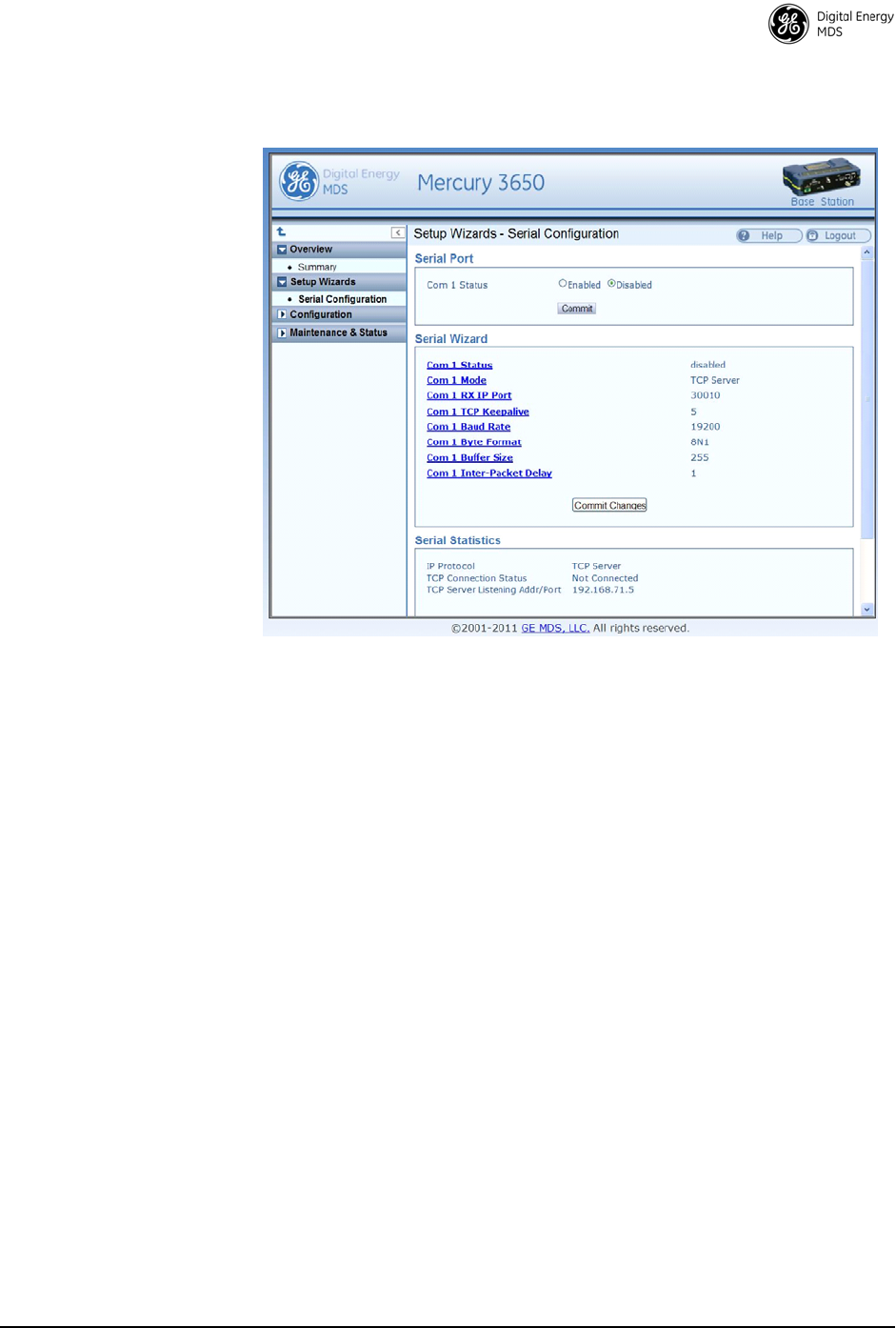
MDS 05-6302A01, Rev. B MDS Mercury 16E Technical Manual 25
6. The current settings are shown. Click Commit Changes to apply all
settings and exit the Serial Wizard.
Invisible place holder
Figure 16. Serial Wizard's Commit Changes Screen
Configure QOS
Quality of Service (QoS) is configured on the Base Station through the
use of service flows. Service flows can be created through the web
interface and through the use of QoS configuration scripts. The web
interface displays the active service flows as well the user-configured
flows.
Depending on the desired effect, service flows are created with different
service types and parameters. For example, service flows can be created
to give priority to a particular traffic flow, to allocate a specific amount
of bandwidth for a traffic flow, to restrict the amount of bandwidth, or
to minimize the latency experienced by a traffic flow.

26 MDS Mercury 16E Technical Manual MDS 05-6302A01, Rev. B
Service Types WiMAX provides five types of service: Unsolicited Grant Service
(UGS), Real-time Polling Service (RTPS), Non-real time polling
Service (nRTPS), Enhanced Real-time Polling Service (eRTPS), and
Best Effort (BE). The characteristics and typical uses for service type
are given in Table 4 below.
Flow Parameters
There are several parameters to be specified when creating a service
flow. Table 5 shows which service flow parameters apply to each type
of service.
Table 4. Service Types and Characteristics
Service Type Characteristics Typical Uses
Unsolicited Grant
Service (UGS)
The BS grants bandwidth to the SU without
it needing to make a request. The
bandwidth is always allocated.
Real time applications generating fixed-size
packets on a periodic basis and requiring low
latency and jitter, such as VoIP.
Real-time Polling
Service (RTPS)
The BS provides specific bandwidth
request opportunities for the SU. This is
more efficient than UGS in not wasting
bandwidth but is less efficient in
request/grant of bandwidth.
Real time applications generating
variable-size packets on a periodic basis,
such as MPEG video.
Non-real time
polling Service
(nRTPS)
The BS polls the SU every one second or
less. The SU may use the polling requests
or contention requests. This is an efficient
request mechanism but does not provide
consistent bandwidth for data.
Delay-tolerant applications generating
variable-size packets on a periodic basis,
such as an FTP transfer.
Enhanced
Real-time Polling
Service (eRTPS)
Combination of UGS and RTPS in which
the BS provides bandwidth grants as in
UGS but the Subscriber can adjust the size
of the grants in order to not waste
bandwidth.
Real time applications generating
variable-size packets on a periodic basis,
such as VoIP with silence suppression.
Best Effort (BE) The Subscriber uses contention request
opportunities to request bandwidth for
data. Bandwidth is provided on a best effort
basis with no acknowledgement.
Non-real time, non-critical applications and
data flows such as web browsing.
Table 5. Flow Parameters
Parameter UGS RTPS nRTPS eRTPS BE
Min Reserved Rate (Y) Y Y Y Y
Max Sustained Rate Y Y Y Y Y
Priority N Y Y Y Y
Max Latency Y Y N Y Y
Grant Interval Y N N Y N
Polling Interval N Y Y N N
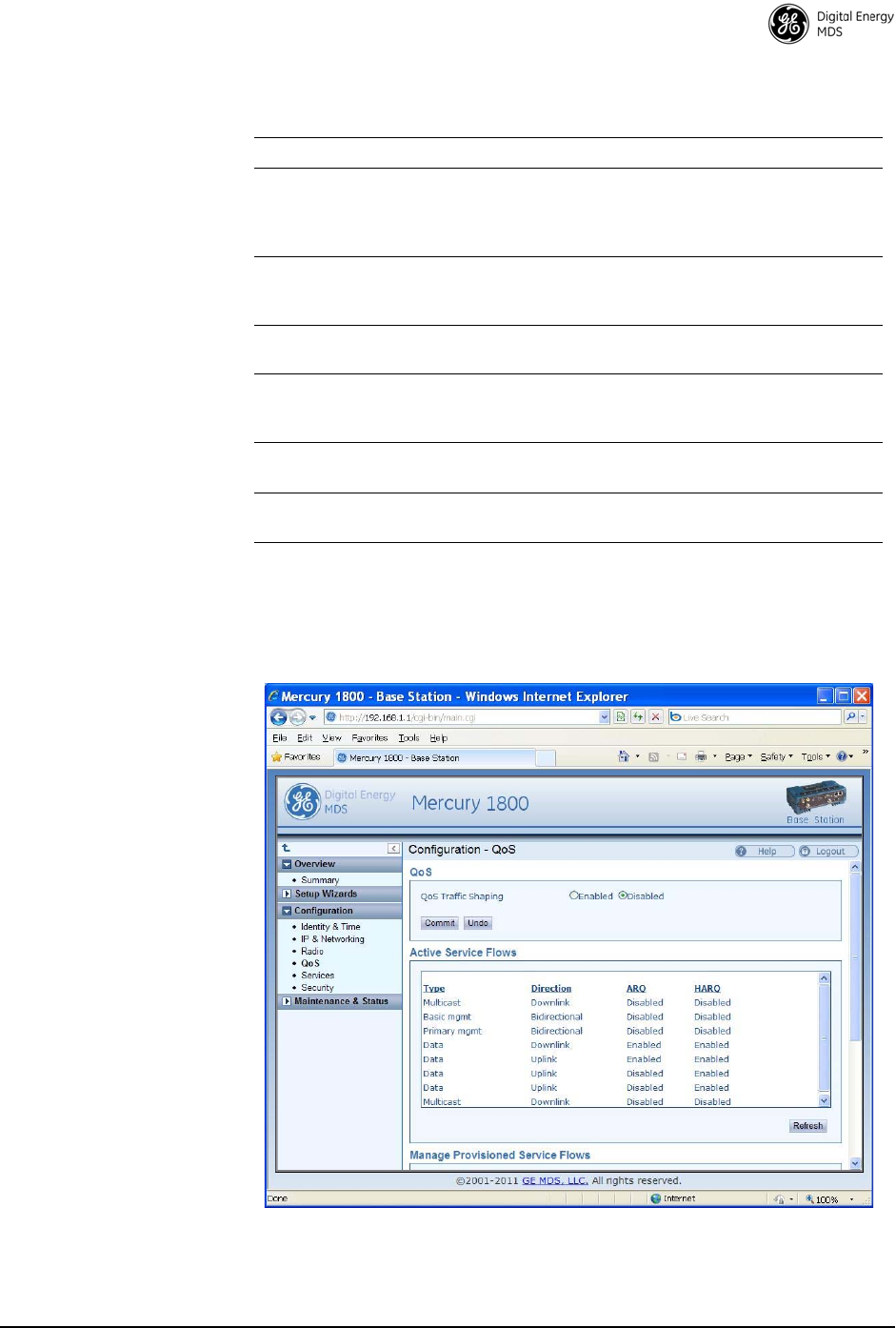
MDS 05-6302A01, Rev. B MDS Mercury 16E Technical Manual 27
Table 6 provides a description for each of the above parameters.
Quality of Service (QoS) Screen
The transceiver's Configuration - QoS page displays the active service
flows as well the user-configured flows.
Figure 17. Configuration-QoS Screen
(Active Service Flows)
Table 6. Parameter Descriptions
Parameter Description
Min Reserved Rate The minimum rate in bits per second that must be
reserved for the service flow. For UGS, the Min
Reserved Rate is set to the same value as the Max
Sustained Rate.
Max Sustained Rate The maximum rate in bits per second that the service
flow will increase to. It is used as an upper bound for
the flow.
Priority A value used to describe the priority between service
flows that have the same characteristics and settings.
Max Latency The maximum time between the reception of the
packet from the wire and its delivery to the other end
of the link.
Grant Interval The time period between successive grants by the
Base Station for a UGS or eRTPS service flow.
Polling Interval The time period between successive polls by the
Base Station for a RTPS or nRTPS service flow.
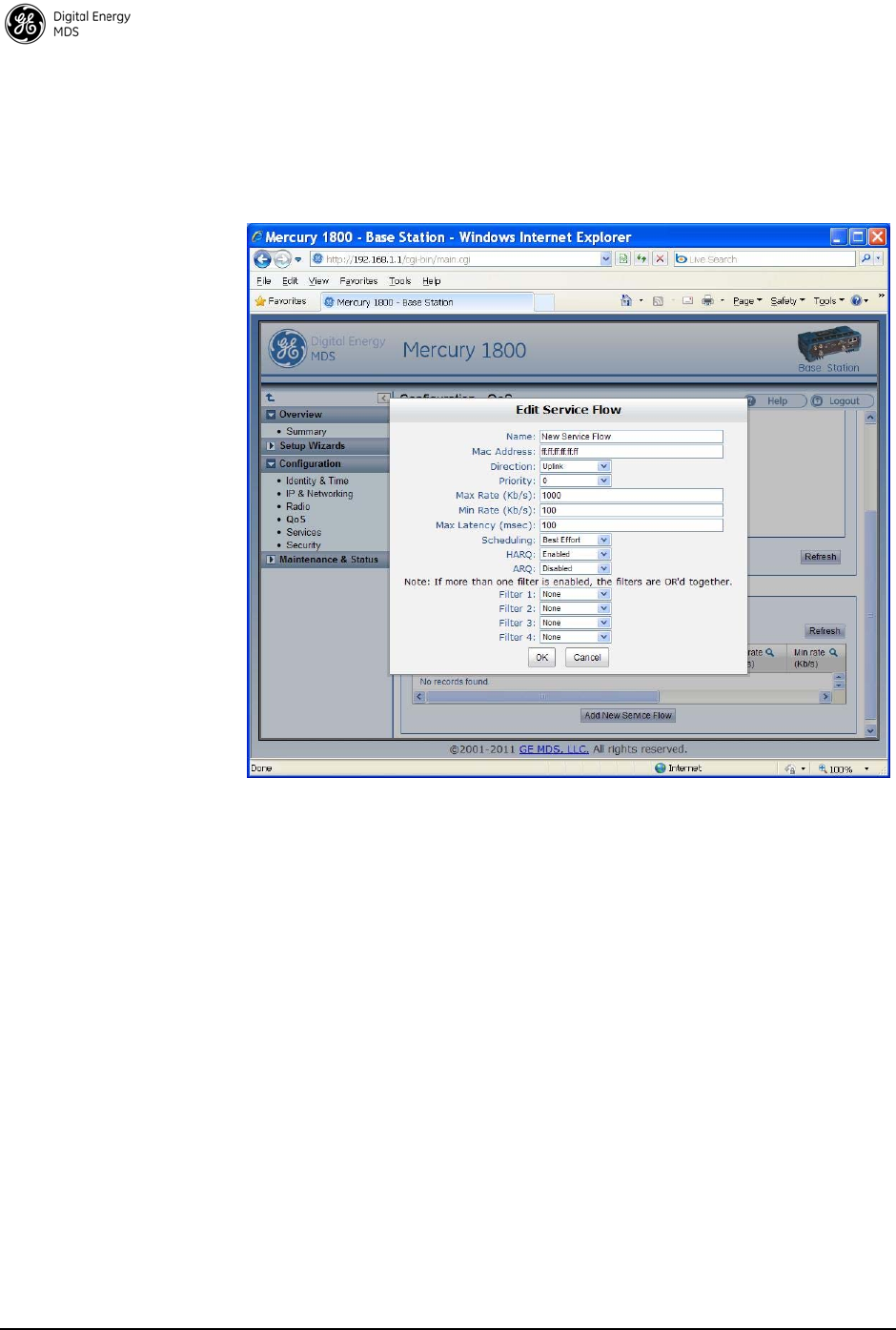
28 MDS Mercury 16E Technical Manual MDS 05-6302A01, Rev. B
Creating a Service Flow
The Add New Service Flow button allows for a new service flow to be
created and configured. Pressing this button displays the following
dialog box.
Invisible place holder
Figure 18. Configuration QoS Screen
(Edit Service Flow)
QOS Example: Low Latency
To create a service flow providing consistent low latency, the UGS
service type should be used. The grant interval should be set to match
the desired latency. For example, if the data source produces a packet
once every 20 milliseconds, then the grant interval should be 20
milliseconds (msec).
QOS Example: Controlling Bandwidth in Video Applications
To create a service flow that manages the bandwidth requirements of a
video stream, the Real-time Polling Service should be used. The
bandwidth-hungry nature of video needs to be balanced against the
limited bandwidth of the wireless channel. Often, a video stream does
not need to be of high quality in order to be useful. The Real-time
Polling Service allows for a minimum and maximum bandwidth to be
specified in order to bound the video stream.
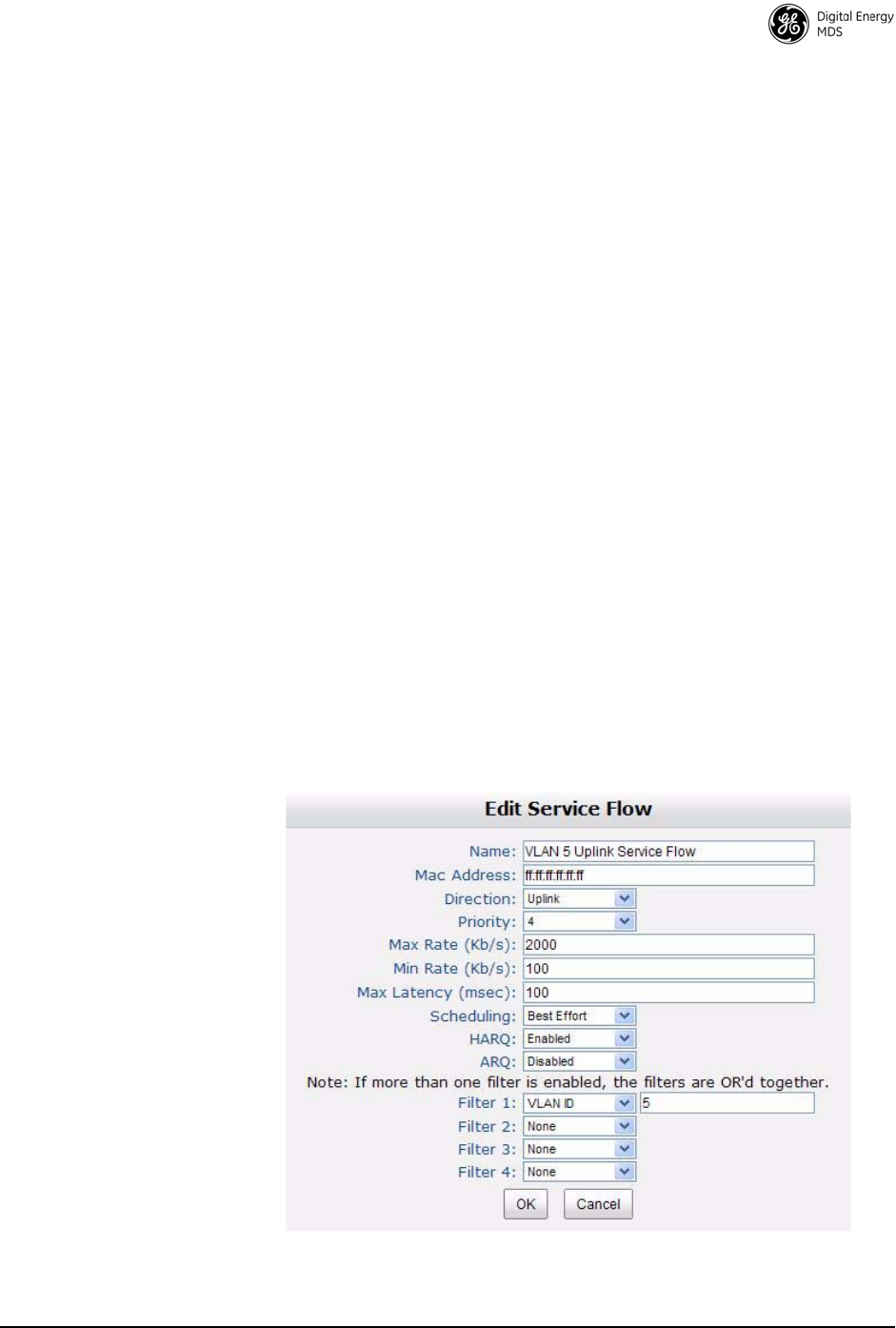
MDS 05-6302A01, Rev. B MDS Mercury 16E Technical Manual 29
QOS Example: Prioritizing a Data Flow
In order to prioritize one traffic flow over another, the service flow
priority should be used. In this example, there are two VLANs on the
trunk at the Base Station. Suppose the user wants to treat traffic on
VLAN 5 as higher priority than traffic on VLAN 6 in the event of heavy
network traffic or congestion. To accomplish this, uplink and downlink
service flows are created that classify on VLAN ID, assigning a higher
priority to VLAN 5's service flows. The following dialog box shows the
configuration for the VLAN 5 uplink service flow. A second service
flow should be created identical to this one for the downlink.
1. Use a MAC address of FF:FF:FF:FF:FF:FF to ensure that the service
flow can be used by any subscriber. (If using all F’s, a maximum of
13 entries is allowed.)
2. Set a low minimum rate to increase the chances that both service
flows will be allocated bandwidth in the event of network conges-
tion.
3. Set Filter 1 to the appropriate VLAN ID to restrict each service flow
to the desired VLAN.
4. Set the priority of VLAN 5's service flows to a higher priority than
VLAN 6's service flows.
5. A service flow is needed for uplink and downlink traffic for each
VLAN.
Invisible place holder
Figure 19. Edit Service Flow Screen (VLAN 5)
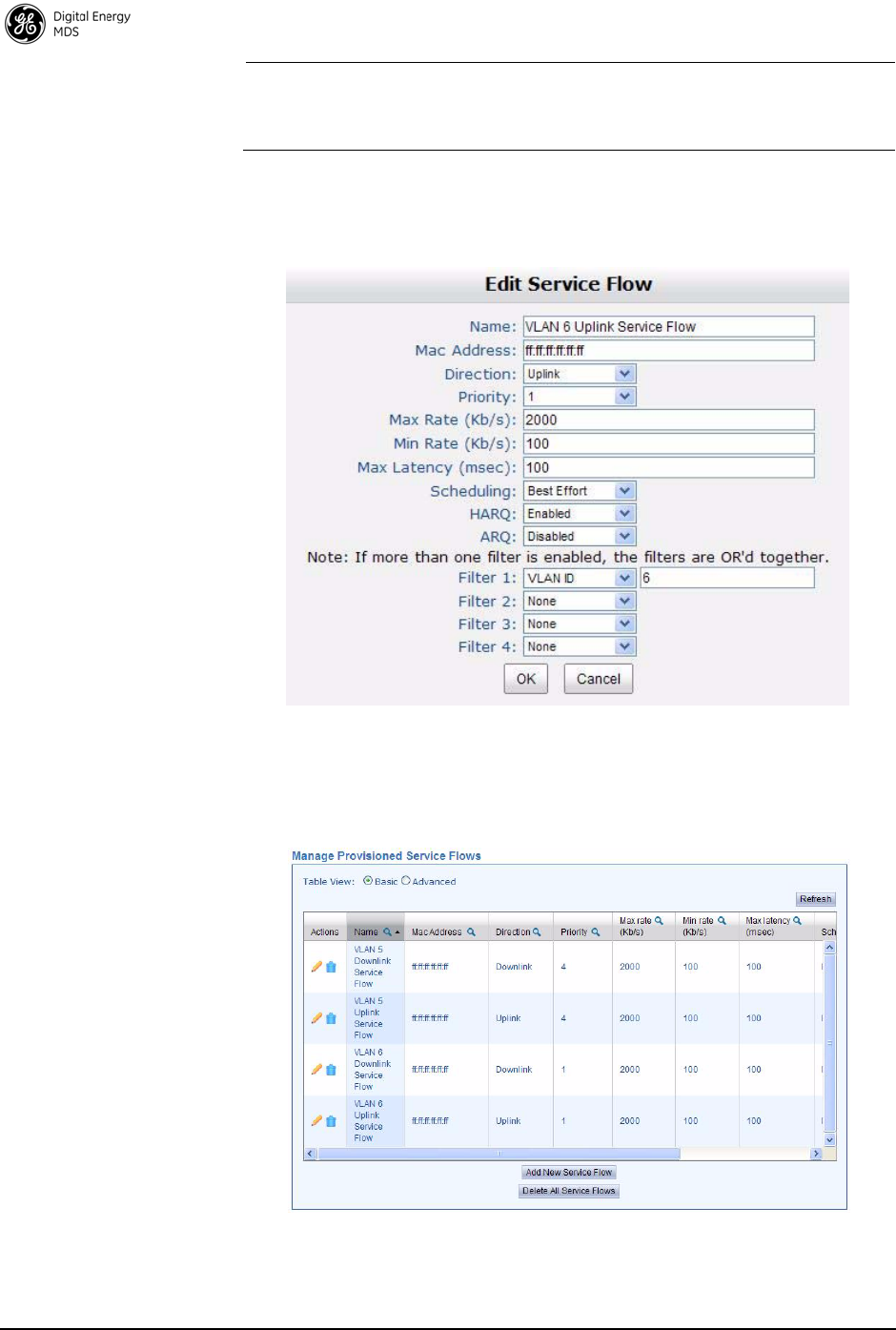
30 MDS Mercury 16E Technical Manual MDS 05-6302A01, Rev. B
NOTE: When using QoS with a subscriber-specific MAC address, an
uplink and downlink service flow must be created. Otherwise,
no data will pass over the air.
The dialog box shown in Figure 20 shows the uplink service flow for
VLAN 6.
Figure 20. Edit Service Flow Screen (VLAN 6)
Once configured, the list of provisioned service flows appears similar to
that shown in Figure 21 below.
Figure 21. Manage Provisioned Service Flows
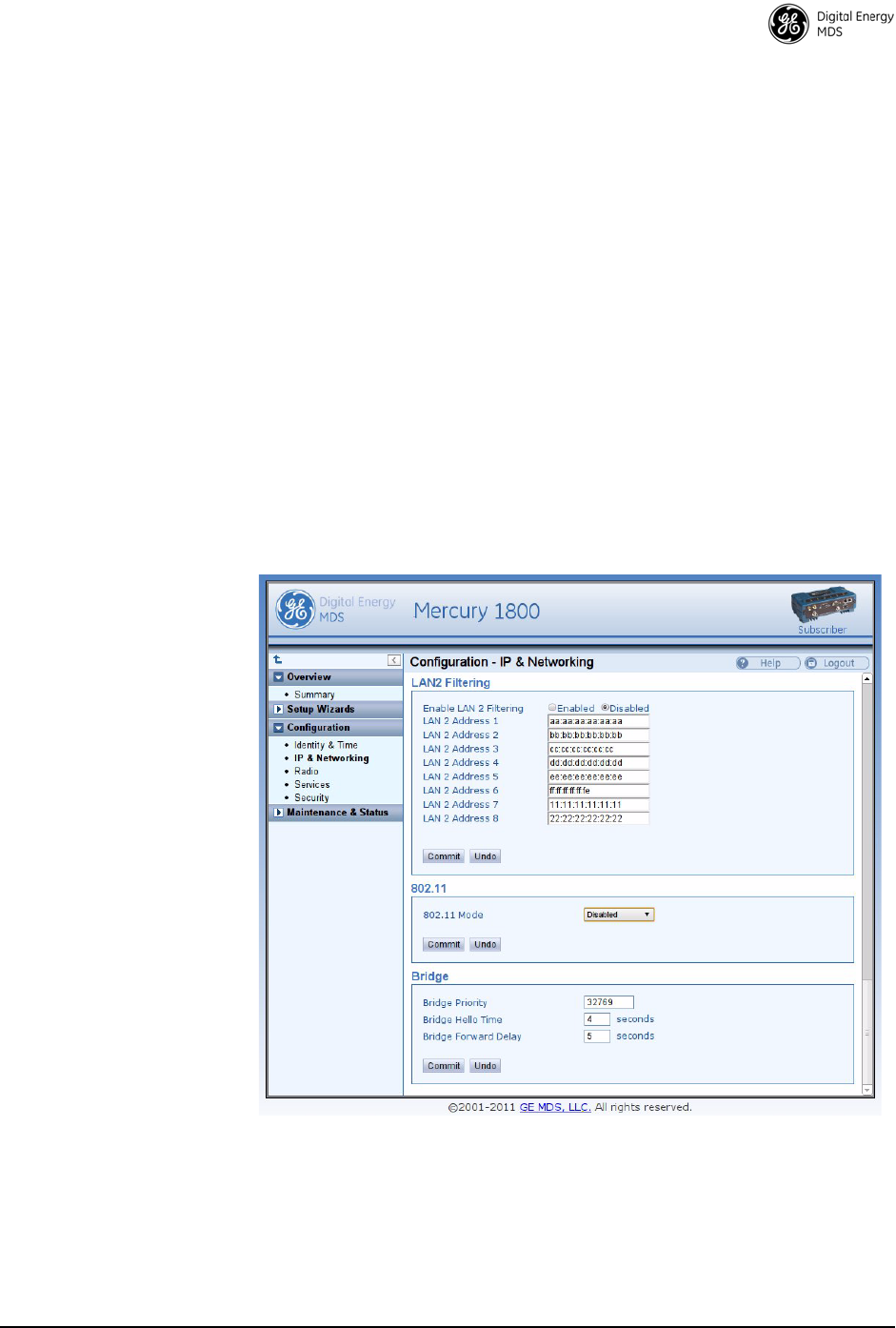
MDS 05-6302A01, Rev. B MDS Mercury 16E Technical Manual 31
QoS Traffic Shaping
Traffic shaping is selectable on the Configuration - QoS menu. It is a
rate-limiting mechanism by which the WiMAX scheduling engine
delays packets when necessary to limit the overall packet rate to a
certain maximum. Traffic shaping can be useful when the payload into
the WiMAX network is very “bursty” in nature and the high end of the
packet rate is greater than the capacity of the WiMAX link. By
selectively delaying packets, the bursts are smoothed out and the load is
held to a consistent maximum.
4.2 802.11 Wi-Fi Interface (Optional Feature)
802.11 Wi-Fi is an optional feature that can be purchased for ODUs and
Subscriber units. When available, the web interface presents an option
to configure Wi-Fi service, as shown below. The Wi-Fi interface can
operate in Station, Ad-Hoc, or Access Point mode. The Wi-Fi interface
can also be disabled by setting the mode to the Disabled mode, which
turns the module off to conserve power.
Invisible place holder
Figure 22. 802.11 Configuration (Default Screen)

32 MDS Mercury 16E Technical Manual MDS 05-6302A01, Rev. B
802.11 Configuration Options
Not all settings shown here are available at all times. Some can only be
configured when an appropriate mode has been set; for example WPA
security settings can only be configured if the security mode is set to
WPA.
A parameter in the following tables is configurable only when the
802.11 Mode has been set to one of the selections in the Mode column
of the table. The following abbreviations apply.
• AP - Access point mode
• STA - Station mode
• AH - Ad-Hoc mode
Table 7. 802.11 General Settings
Mode Parameter Description
802.11 Mode AP, STA, AH Station, Ad-Hoc, Access Point,
Disabled—What mode the 802.11 module
should operate in.
802.11 SSID AP, STA, AH 40 character string—The name of the network
to join or create.
Broadcast
802.11 SSID
AP Enabled/disabled—Whether or not to publicly
display the SSID to Wi-Fi clients.
802.11
Channel
AP, AH 1-11—Manual selection of 802.11 channel.
802.11 Station
Timeout
AP 1-240 minutes—How long before a station is
removed from the station list.
Tx Power AP, STA, AH 1-18 dBm—Transmit power of 802.11 RF
module.
Log 802.11
Events
AP, STA, AH Enabled/disabled—Whether or not to log
association and disassociation events to the
Mercury event log.
NIC in Bridge AP Enabled/disabled—Whether or not to bridge
network traffic between the 802.11 interface and
the LAN and WiMAX interfaces.

MDS 05-6302A01, Rev. B MDS Mercury 16E Technical Manual 33
Additional read-only fields are present that show the current IP settings
of the 802.11 interface, regardless of whether those settings were
statically or dynamically assigned.
If the NIC in Bridge option is enabled, then 802.11 IP settings become
unavailable.
Similarly, if VLANs are enabled and the 802.11 VLAN ID matches the
Serial VLAN ID, then the 802.11 IP settings are unavailable because
those interfaces are bridged together.
The IP settings in the LAN section or the Serial VLAN section can be
used to configure the transceiver’s IP settings when the LAN and
WLAN interfaces are bridged.
Table 8. 802.11 IP Address Settings
Parameter Mode Description
802.11 IP
Address Mode
AP, STA, AH Static/Dynamic—Whether or not to use the
statistically assigned IP Address specified below
or to obtain IP settings from a DHCP server.
802.11 IP
Address
AP, STA, AH xxx.xxx.xxx.xxx—The static IP address to use.
802.11 IP
Netmask
AP, STA, AH xxx.xxx.xxx.xxx—The static IP netmask to use.
IP Gateway AP, STA, AH xxx.xxx.xxx.xxx—The static IP gateway to use.
Table 9. Settings for WEP Security Mode
Parameter Mode Description
802.11 IP
Privacy Mode
AP, STA, AH* None, WEP—Type of privacy applied.
802.11 WEP
Encryption
AP, STA, AH 64,128 bit—The level of encryption to use.
WEP
Passphrase
AP, STA, AH 40 character string—Passphrase used to
generate a WEP key.
WEP Key AP, STA, AH Unique character string—Used for encryption
(hexidecimal only). A string of 5 characters is
allowed in 64 bit mode and 13 characters in 128
bit mode.
WEP Auth
Mode
AP, STA, AH Open—This option is fixed (non-configurable).
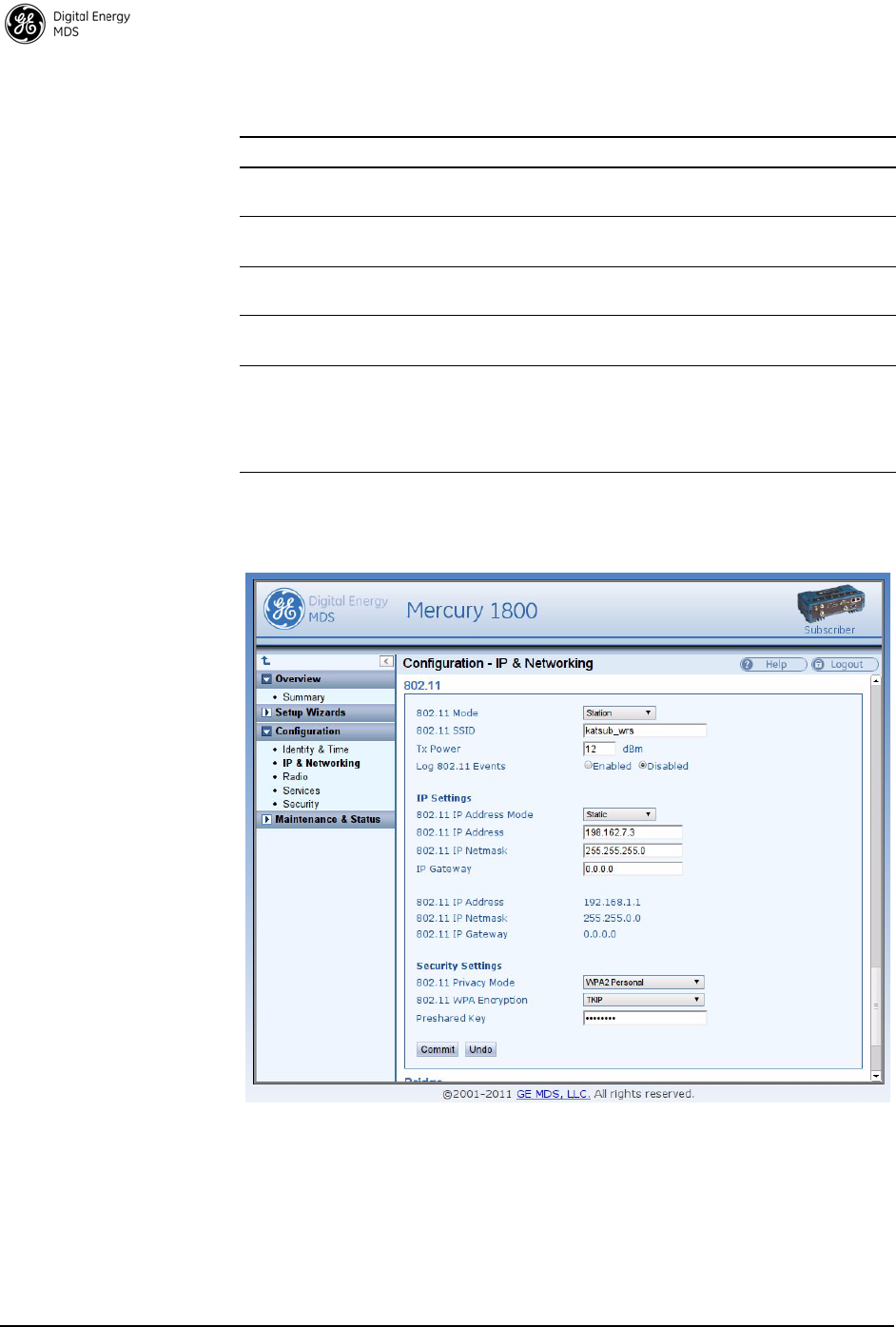
34 MDS Mercury 16E Technical Manual MDS 05-6302A01, Rev. B
* Note that Ad-Hoc may only use WEP, or None privacy settings. It may not be used
with any form of WPA privacy.
Invisible place holder
Figure 23. 802.11 Configuration for Station Mode
Table 10. Settings for WPA, WPA2 Security Modes
Parameter Mode Description
802.11 IP
Privacy Mode
AP, STA WPA-PSK, WPA Enterprise, WPA2 Personal,
WPA2 Enterprise—Type of privacy applied.
802.11 WPA
Encryption
AP, STA TKIP, CCMP—Method of encryption to use.
Preshared Key AP, STA WPA-PSK, WPA2 Personal—A string of up to 64
characters used for encryption.
EAP Method AP, STA EAP-TLS—Method of EAP to use for
authentication (Enterprise).
Certificates to
Use
STA Wi-Fi 802.11 Certificates, WiMAX 802.1x
Certificates—Specify which set of certificates
should be used to authenticate the Mercury
transceiver (only for WPA/WPA-2 Enterprise
modes).
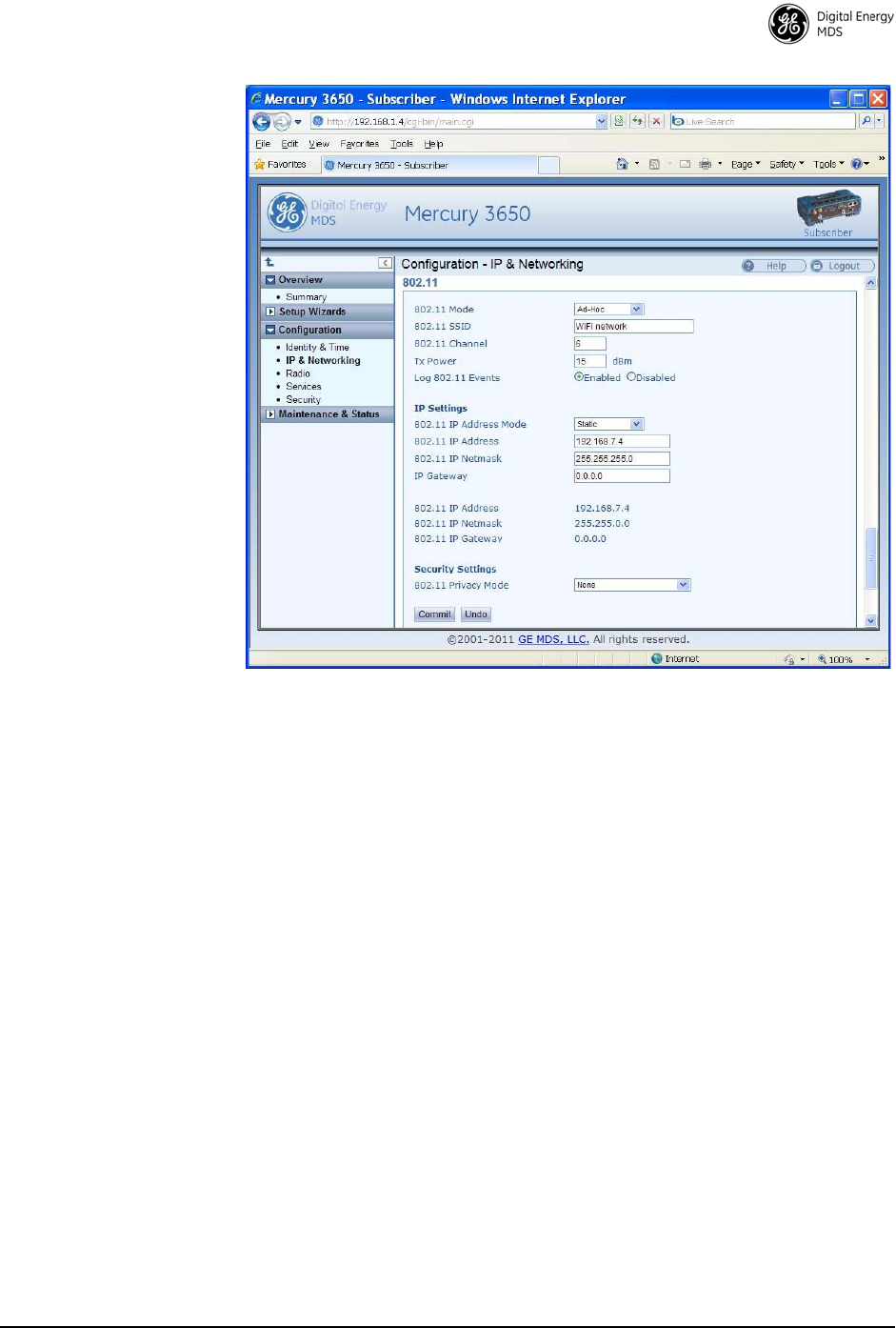
MDS 05-6302A01, Rev. B MDS Mercury 16E Technical Manual 35
Invisible place holder
Figure 24. 802.11 Configuration for Ad-Hoc Mode
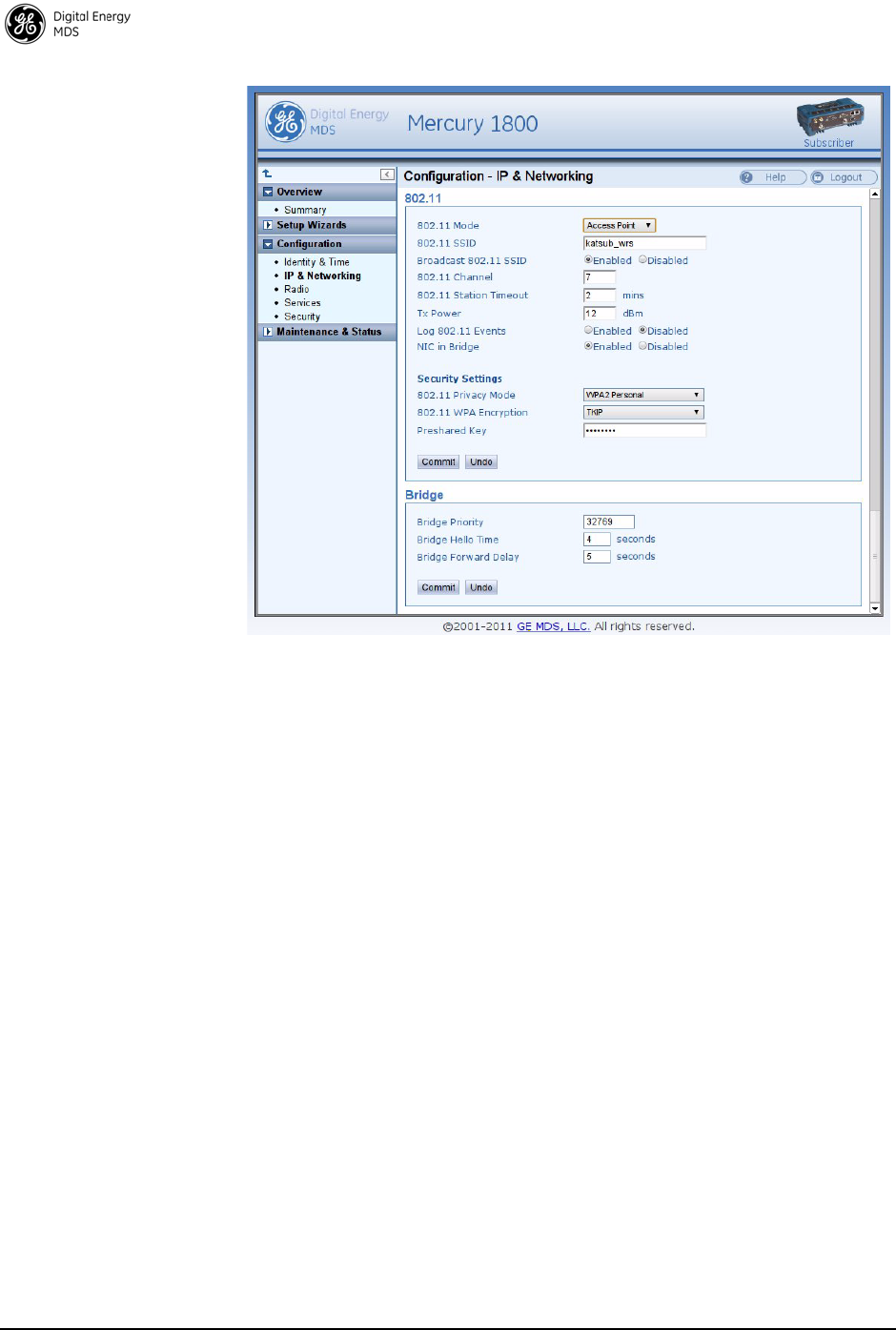
36 MDS Mercury 16E Technical Manual MDS 05-6302A01, Rev. B
Invisible place holder
Figure 25. Configuration for Access Point Mode
802.11 Status
The status of the 802.11 module and network is available in the
Maintenance & Status section. The information displayed differs
depending on the 802.11 mode selected. Figure 26 and Figure 27 show
two examples of this status information.
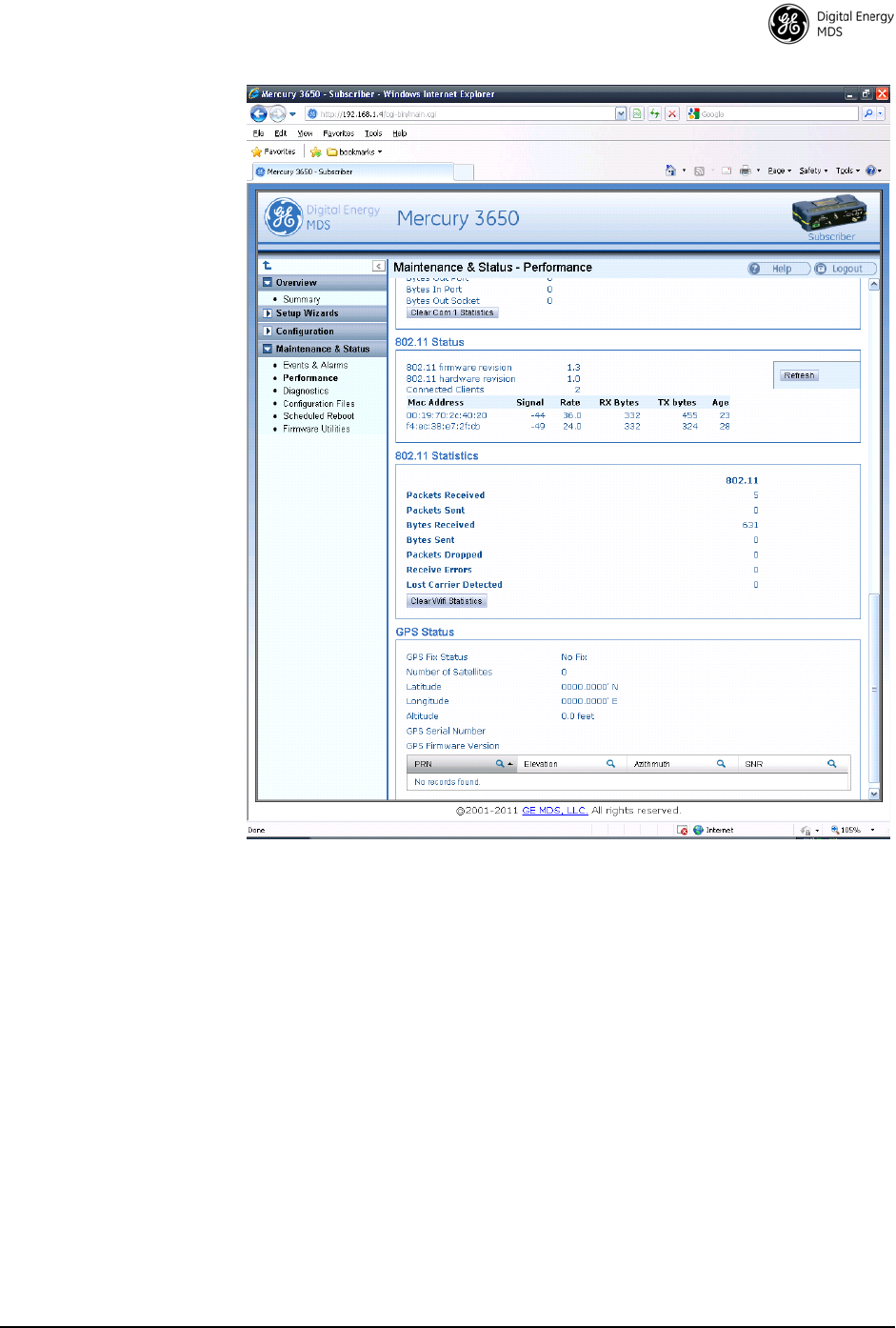
MDS 05-6302A01, Rev. B MDS Mercury 16E Technical Manual 37
Invisible place holder
Figure 26. 802.11 Status when in Access Point Mode
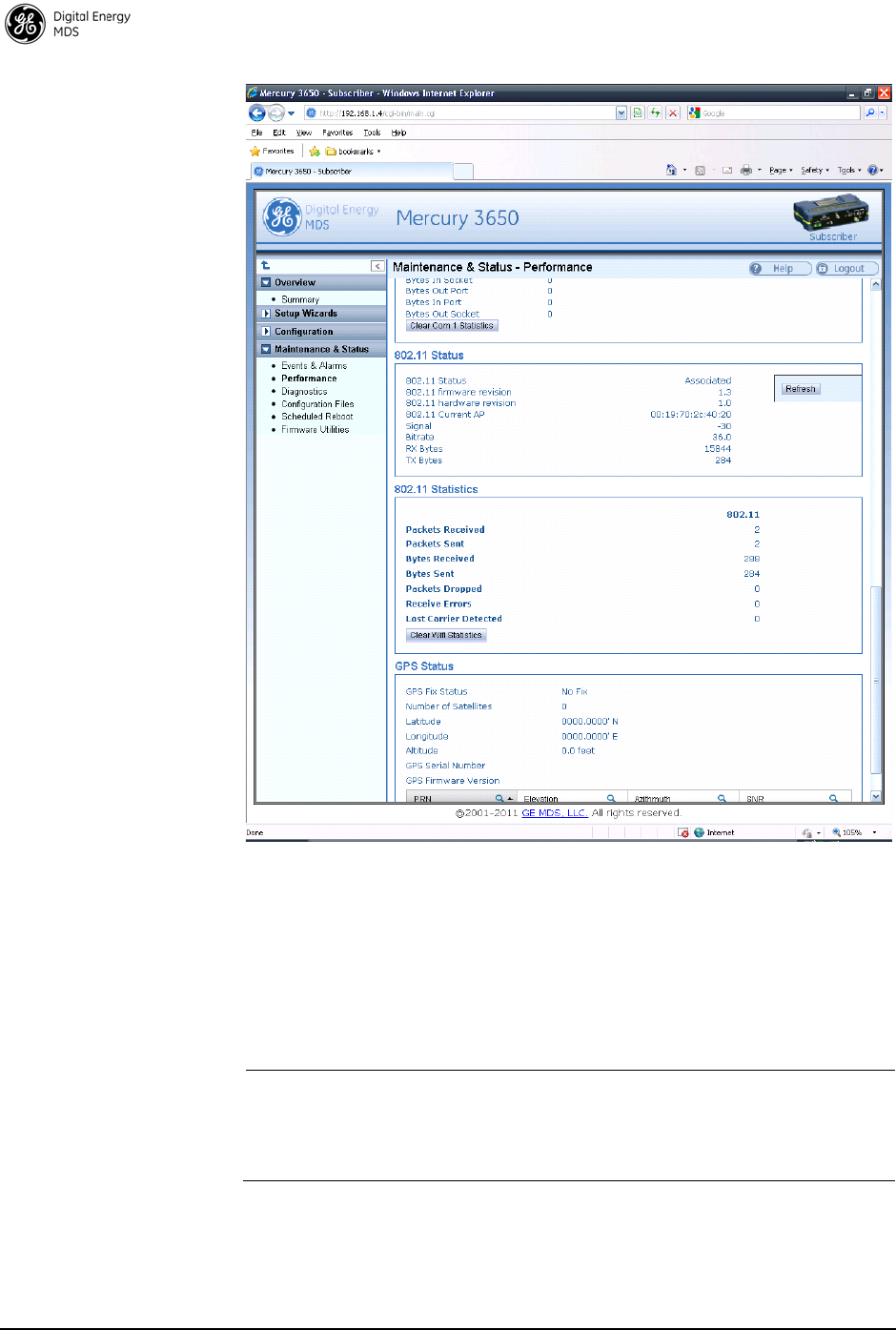
38 MDS Mercury 16E Technical Manual MDS 05-6302A01, Rev. B
Invisible place holder
Figure 27. 802.11 Status when in Station or Ad-Hoc Mode.
4.3 Radio Test Mode Menu
The Radio Test Mode screen (Figure 28) allows keying the transmitter
for performance checks and setting of several parameters used during
tests.
NOTE: Using Test Mode disrupts traffic through the radio. If the unit
is a Base Station, it will disrupt traffic through the entire
network. The Test Mode function is automatically limited to
10 minutes. Only use Test Mode for brief measurements.
•Radio Mode—Sets/displays the radio's operating mode.
•Test Status—This read-only parameter shows the current state of
the radio.
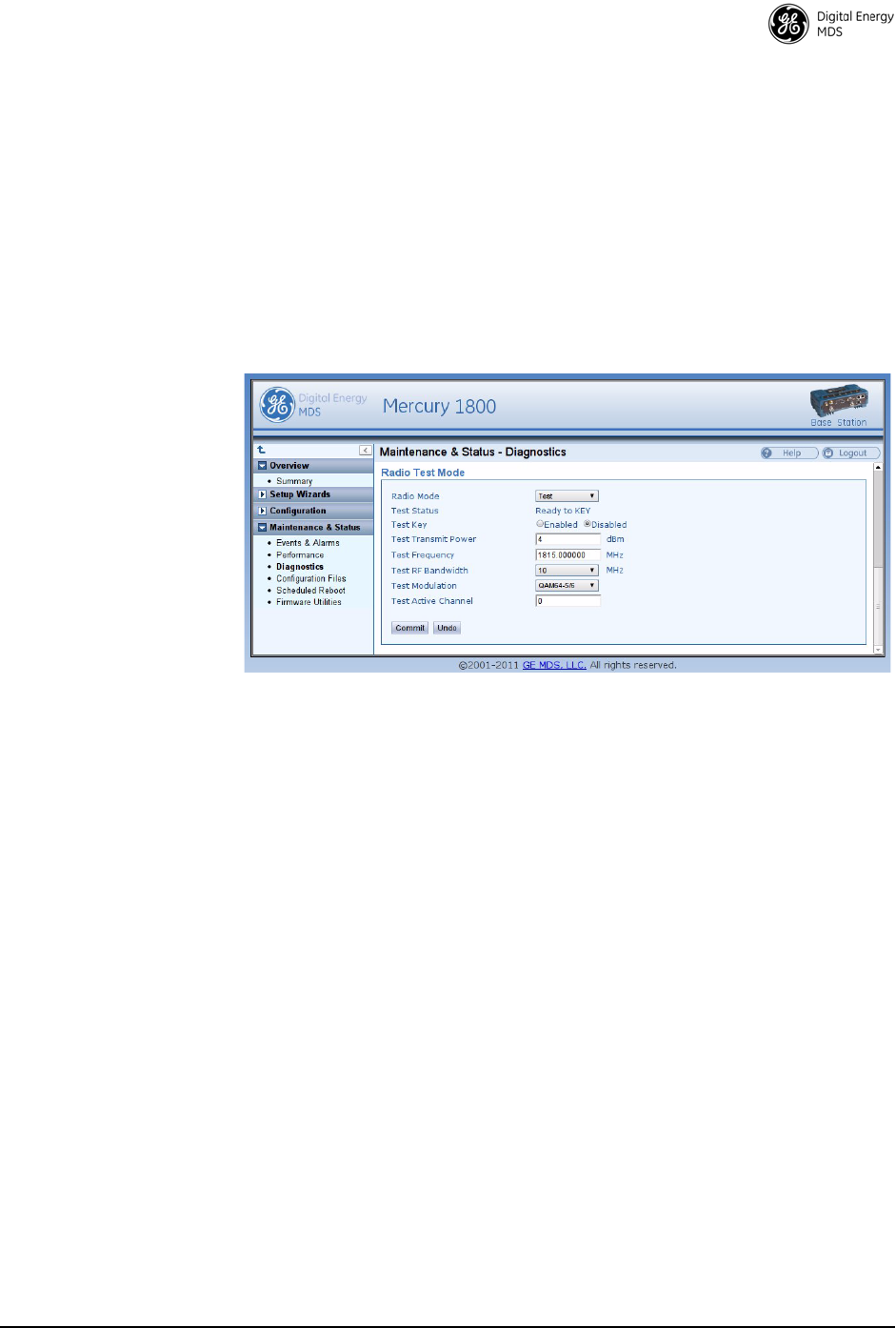
MDS 05-6302A01, Rev. B MDS Mercury 16E Technical Manual 39
The following parameters are read-only unless Radio Test Mode is first
selected and set to Test. In Test Mode, these items become selectable:
•Test Key—Sets/displays keying status of the transmitter.
•Test Transmit Power—Sets/displays the transmitter's power set-
ting.
•Test Frequency—Sets/displays the radio’s test frequency.
•Test RF Bandwidth—Sets/displays the transmitter's bandwidth for
testing.
•Test Modulation—Sets/displays the modulation to use for testing.
•Test Active Channel—Sets/displays the channel to use for testing.
Invisible place holder
Figure 28. Radio Test Mode Screen
4.4 Configure Security Features & Integration with
a RADIUS Server
Device Management Interface Configuration
Using the Configuration - Security page, each of the device management
interfaces (HTTP, SNMP, SSH, telnet) can be enabled or disabled. For
secure installations, it is recommended that 1) the Telnet interface be
disabled, 2) the SNMP agent run in SNMPv3 mode, 3) the web server
be configured for HTTPS with MD5 digest.
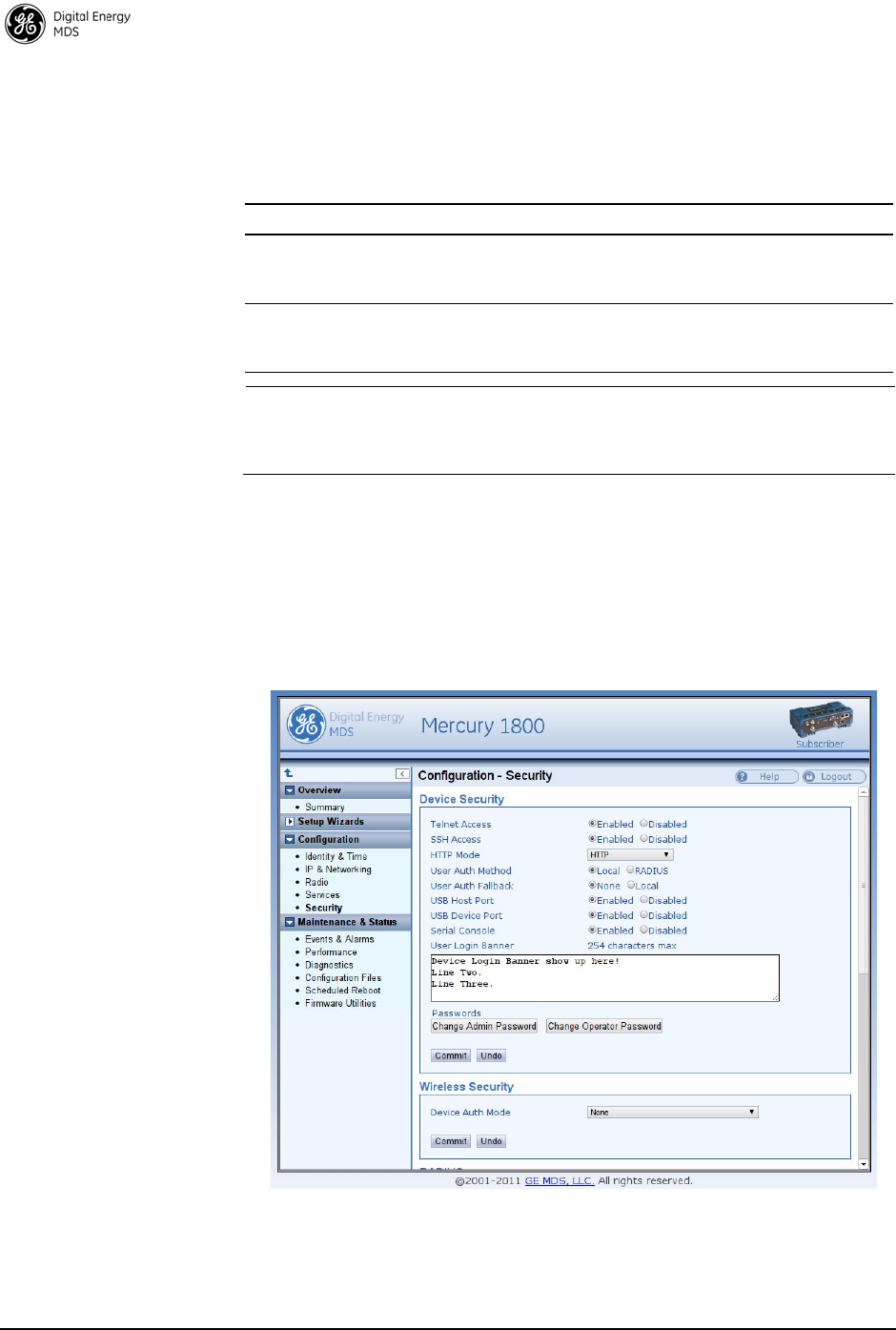
40 MDS Mercury 16E Technical Manual MDS 05-6302A01, Rev. B
User Accounts
Each Mercury transceiver has two local user accounts available via
console terminal management, as listed in the chart below:
Table 11. Local User Accounts
NOTE: In case of a lost password and an inability to login to the trans-
ceiver, see “TROUBLESHOOTING” on Page 46 for details
on resetting the password.
In addition to the local user accounts, the Mercury transceiver can be
configured to use a RADIUS server for centralized user account
management. The Configuration - Security page is used to configure the
User Auth Method to RADIUS. If the User Auth Fallback parameter is set to
Local, then the local user account information will be used if the
RADIUS server (and secondary server if configured) is unreachable.
Invisible place holder
Figure 29. Configuration - Security Screen (Upper Portion)
Username Default Password Access Level
operator operator Read-only access to configuration
parameters, status, performance metrics, and
statistics.
admin admin Read and write access to all configuration
parameters. Read access to status,
performance metrics, and statistics
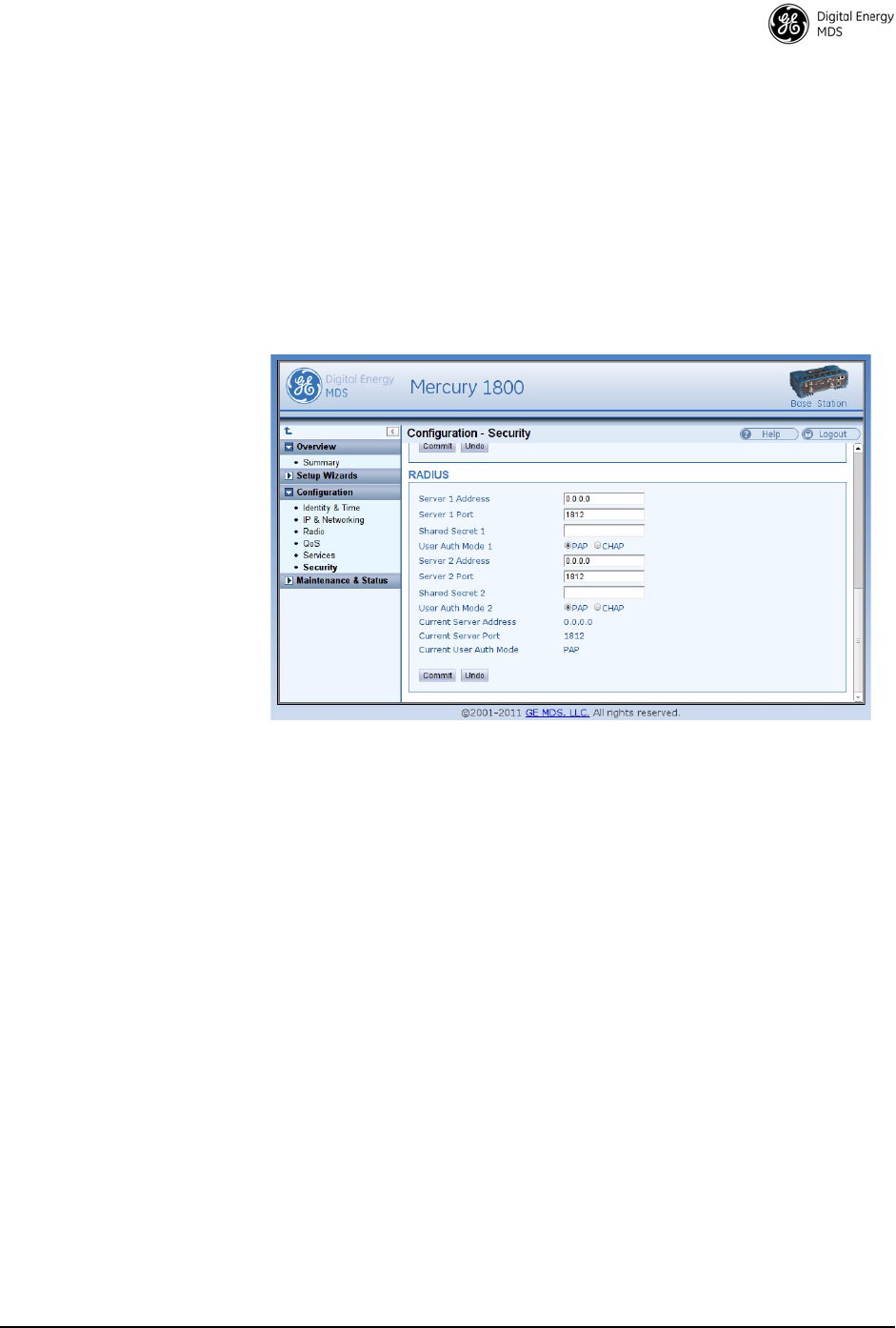
MDS 05-6302A01, Rev. B MDS Mercury 16E Technical Manual 41
4.5 RADIUS Server Configuration
Using the Configuration - Security page, each Mercury transceiver can be
configured with one or two IP addresses for RADIUS servers. The
RADIUS server is used for user authentication and device
authentication. The IP address, port, shared secret, and authentication
protocol can be configured for each RADIUS server. If two servers are
configured, the device will use the first server for authentication
processes. However, if ICMP communication fails to the first server, the
Mercury transceiver will change over to the second server.
Invisible place holder
Figure 30. Configuration - Security Screen (RADIUS Portion)
Creation of X.509 Certificates
Each transceiver can be loaded with a set of X.509 digital certificates in
DER format. These certificates are used in the authentication process
when joining a WiMAX network. The certificates can be loaded using
TFTP, FTP, or SFTP, or a USB flash drive as described below. Three
certificates are supported: Root CA (Certificate Authority), the Device's
public certificate, the Device's Private Key. The Common Name (CN)
for the certificate must be the serial number for the Mercury transceiver.
A domain name can be appended to the serial number for the Common
Name, for example, 2047711.mydomain.com.
Load X.509 Certificates
The X.509 certificates can be loaded on the unit using TFTP, FTP,
SFTP, or a USB flash drive using the Configuration - Security page. Select
the appropriate File Media as TFTP, FTP, SFTP, or USB. If using one
of the network protocols, specify the IP address of the server and the
other necessary protocol parameters.
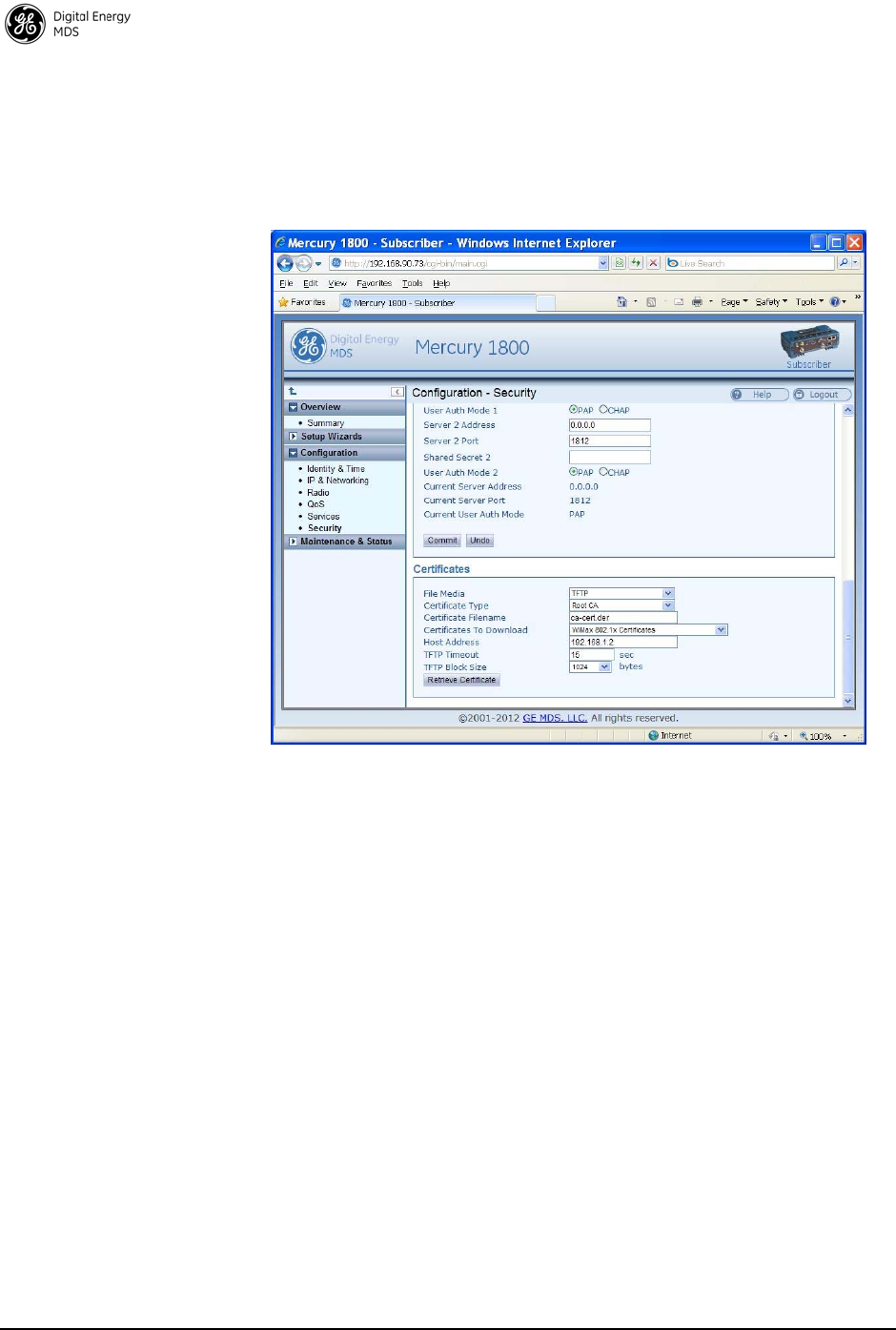
42 MDS Mercury 16E Technical Manual MDS 05-6302A01, Rev. B
Specify the filename of the certificate as it appears on the server or USB
flash drive used. Specify the certificate type: Root CA, Public
certificate, or Private Key. Once these parameters are set, begin the
transfer by pressing the Retrieve Certificate button. Repeat this process for
each of the three certificates.
Invisible place holder
Figure 31. Configuration - Security Screen (Certificate Portion)
Configure SNMPV3
Overview The Mercury transceiver supports SNMP protocol version 3. Version 3
brings a higher level of security to SNMP transactions by requiring user
account name and password authentication as well as encryption of
SNMP packets. The following section describes how SNMPv3 is
implemented on the transceiver and how to configure it for integration
with PulseNET and other network management system software.
SNMPV3 SUPPORT The updated SNMP Agent now supports SNMP version 3 (SNMPv3).
The SNMPv3 protocol introduces Authentication (MD5/SHA-1),
Encryption (DES), the USM User Table, and View-Based Access (refer
to RFC2574 for full details). The SNMP Agent has limited SNMPv3
support in the following areas:
• Only MD5 Authentication is supported (no SHA-1). SNMPv3
provides support for MD5 and SHA-1.

MDS 05-6302A01, Rev. B MDS Mercury 16E Technical Manual 43
• Limited USM User Table Manipulation. The SNMP Agent
starts with five default accounts. New accounts can be added
(SNMPv3 adds new accounts by cloning existing ones), but
they will be volatile (will not survive a power-cycle). New
views cannot be configured on the SNMP Agent. Views are
inherited for new accounts from the account that was cloned.
The SNMP Agent uses one password pair (Authentication/Pri-
vacy) for all accounts. This means that when the passwords
change for one user, they change for all users.
SNMPV3 Accounts The following default accounts are available for the SNMP Agent:
enc_mdsadmin-Read/write account using Authentication and Encryption.
auth_mdsadmin-Read/write account using Authentication.
enc_mdsviewer-Read only account using Authentication and Encryption.
auth_mdsviewer-Read only account using Authentication.
def_mdsviewer-Read only account with no Authentication or Encryption.
Context Names The following Context Names are used (refer to RFC2574 for full
details):
• Admin accounts is context_a
• Viewer accounts is context_v.
All accounts share the same default passwords:
• Authentication default password is MDSAuthPwd
• Privacy default password is MDSPrivPwd
Passwords can be changed either locally (via the console) or from an
SNMP Manager, depending on how the Agent is configured. If
passwords are configured and managed locally, they are non-volatile
and will survive a power-cycle. If passwords are configured from an
SNMP manager, they will be reset to whatever has been stored for local
management on power-cycle.
This behavior was chosen based on RFC specifications. The SNMP
Manager and Agent do not exchange passwords, but actually exchange
keys based on passwords. If the Manager changes the Agent's password,
the Agent does not know the new password. The Agent only knows the
new key. In this case, only the Manager knows the new password. This
could cause problems if the Manager loses the password. If that occurs,
the Agent becomes unmanageable. Resetting the Agent's passwords
(and therefore keys) to what is stored in flash memory upon power-cycle
prevents the serious problem of losing the Agent's passwords.

44 MDS Mercury 16E Technical Manual MDS 05-6302A01, Rev. B
If passwords are managed locally, they can be changed on the Agent (via
the console). Any attempts to change the passwords for the Agent via an
SNMP Manager will fail when the Agent is in this mode. Locally
defined passwords will survive a power-cycle. In either case, the SNMP
Manager needs to know the initial passwords being used in order to
communicate to the Agent. If the Agent's passwords are configured via
the Manager, they can be changed from the Manager. If the passwords
are managed locally, then the Manager must be re-configured with any
password changes in order to continue talking to the Agent.
Password Mode
Management
Changes
When the password management mode is changed, the active passwords
used by the Agent may also change. Some common scenarios are
discussed below:
• Passwords are currently being handled by the Manager. The
assigned passwords are Microwave (Auth), and Rochester (Priv).
Configuration is changed to manage the passwords locally. The
passwords stored on the radio were Fairport (Auth), and Church-
ville (Priv) (if local passwords have never been used, then MDS-
AuthPwd and MDSPrivPwd are used). These passwords will
now be used by the Agent to re-generate keys. The Manager
must know these passwords to communicate with the Agent.
• Passwords are currently managed locally. The local passwords
are Fairport (Auth) and Churchville (Priv). Configuration is
changed to handle the passwords from the Manager. The same
passwords will continue to be used, but now the Manager can
change them.
• Passwords are currently managed locally. The local passwords
are Fairport (Auth) and Churchville (Priv). Passwords are changed
to Brighton (Auth) and Perinton (Priv). The Agent will immedi-
ately generate new keys based on these passwords and start
using them. The Manager will have to be re-configured to use
these new passwords.
• Passwords are currently managed locally. The local passwords
are Fairport (Auth) and Churchville (Priv). Configuration is
changed to handle the passwords from the Manager. The Man-
ager changes the passwords to Brighton (Auth) and Perinton
(Priv). The radio is then rebooted. After a power-cycle, the radio
uses the passwords stored in flash memory, which are Fairport
(Auth) and Churchville (Priv). The Manager must be re-config-
ured to use these new passwords.

MDS 05-6302A01, Rev. B MDS Mercury 16E Technical Manual 45
4.6 Use of the Antenna Alignment Tool
The antenna alignment tool (expected availability late 2012) is intended
for use with the ODU Subscriber. The tool provides status and
performance indicators and is intended for use during ODU installation
and troubleshooting. The tool features indicators for Power, Device
status (Operational or Alarmed), Link status, RSSI, and SNR. It is
powered by the ODU over the USB connection.
To get started, mount the ODU in the desired location and tighten the
mounting bracket so that it is snug but can still be moved by hand. Plug
the alignment tool into the ODU using the USB cable provided. All of
the LED indicators on the tool will light briefly while the tool powers
up. Check the Power, Device status, and Link status indicators to verify
that they are lit.
If the Device status indicators show that the ODU is Initializing, then
wait up to 1.5 minutes for the ODU to become fully Operational. If the
Link status indicator does not light, then wait for 30 seconds to give the
unit time to scan for a Base Station. If the Link indicator still does not
light, then the ODU may be significantly misaligned, there may be a
problem with the Base Station, or there may be an incorrect
configuration on the Base Station or ODU Subscriber.

46 MDS Mercury 16E Technical Manual MDS 05-6302A01, Rev. B
5.0 TROUBLESHOOTING
5.1 LED INDICATORS
NOTE: When the Subscriber boots up, the PWR LED will be on solid
at first, then begin blinking slowly while the unit initializes.
Once initialized, the LINK LED will blink slowly while the unit
scans for a Base Station. Once the unit links, the LINK LED
stays on solid.
5.2 WiMAX Statistics
The Maintenance and Status - Performance screen on both the Base Station
and Subscriber provides WiMAX Statistics. This information can be
used for diagnostics and troubleshooting of the wireless link. The WiMAX
Statistics pane provides packet and byte statistics for both the uplink and
downlink direction.
Table 12. LED Indicators
Indicator Activity Meaning
PWR ON Primary power present
Blinking Fast Unit is alarmed
Blinking Slow Unit is intitializing
OFF No primary power
LAN ON LAN detected
Blinking Ethernet traffic
OFF No LAN connected
COM1 Blinking Data traffic
OFF No data traffic
GPS ON Internal GPS receiver is synchronized to satellite
network
OFF Internal GPS receiver is not synchronized
LINK (Base
Station)
ON The Base Station is operational and transmitting
OFF The Base Station is not transmitting/not ready yet
LINK
(Subscriber)
ON The Subscriber is linked to a Base Station
Blinking slow The Subscriber is scanning
OFF The Subscriber is not linked to a Base Station/not
ready yet
USB ON USB activity on Host port
OFF No USB activity

MDS 05-6302A01, Rev. B MDS Mercury 16E Technical Manual 47
Note that the term “Downlink” refers to the wireless path from the Base
Station to the Subscriber and the term “Uplink” refers to the Subscriber
to Base Station path. In addition to the packet and byte statistics, each
unit provides packets-per-second and kilobits-per-second metrics in real
time. The Clear WiMAX Statistics button can be clicked to reset the packet
and byte counters and the rate indicators.
5.3 Common Troubleshooting Scenarios
Table 13 lists common difficulties that may be encountered, and
suggests remedies to restore proper operation of the wireless system.
Table 13. Troubleshooting Checks
Symptom Possible Cause/Remedy
Unit does not boot 1. Primary power disconnected or power source has failed.
2. Primary power may be below 10 Vdc.
Subscriber does not
link
1. Modem at Base Station or Subscriber may be disabled.
2. Base Station and Subscriber radio configurations may not
match.
3. Base Station transmitter power may be turned down.
4. Base Station and Subscriber WiMAX security settings may
not match.
5. The antenna(s) may be misaligned.
Unable to pass data
end-to-end
1. The Subscriber may not be linked.
2. An Ethernet port at the Base Station or Subscriber may be
disconnected or disabled.
3. The Base Station or Subscriber may be misconfigured in
regard to VLAN and VLAN trunk port settings.
4. The IP addressing of the source and destination devices
may be mismatched.
Weak or poor
quality signal at
Subscriber
1. The Base Station transmit power may be set too low. Check
the gain and loss in the antenna system and cabling to
determine the maximum allowable transmit power.
2. The antenna(s) may be misaligned.
3. The signal path may be too obstructed. Attempt to find a
better location for the antenna.
4. There may be too much interference on the channel or an
adjacent channel. Use a spectrum analyzer to view the RF
activity in the band. Move operation to a different frequency if
available.
5. The radio hardware may be damaged. Test the unit on a
bench cabled directly (through an attenuator) to another
known working unit.

48 MDS Mercury 16E Technical Manual MDS 05-6302A01, Rev. B
6.0 SITE INSTALLATION GUIDE
This section provides tips for selecting an appropriate site, choosing an
antenna system, and reducing the chance of harmful interference.
NOTE: To prevent moisture from entering the radio, do not mount the
radio with the cable connectors pointing up. Also, dress all
cables to prevent moisture from running along the cables and
into the radio.
6.1 General Requirements
There are three main requirements for installing a transceiver—ade-
quate and stable primary power, a good antenna system, and the correct
interface between the transceiver and the data device. Figure 32 shows
a typical Subscriber Unit installation.
NOTE: To prevent Ethernet traffic from degrading transceiver
throughput performance, place the unit in a segment, or behind
routers.
Unable to log in due
to lost Password
The configuration, including the user account passwords for
the unit, can be reset by logging in with a special user account
and entering an authorization key. The authorization key is a
cryptographic key generated by GE MDS for the specific serial
number of the device. The key can be obtained by contacting
GE MDS Technical Services.
Once the key is obtained, it can be entered into the unit by
logging in with username authcode and password authcode.
When logged in, the unit will prompt for the authorization key.
This process resets the configuration of the device to the
defaults. This causes the username and password to be set to
admin and a reset of all operating parameters to defaults.
Table 13. Troubleshooting Checks (Continued)
Symptom Possible Cause/Remedy
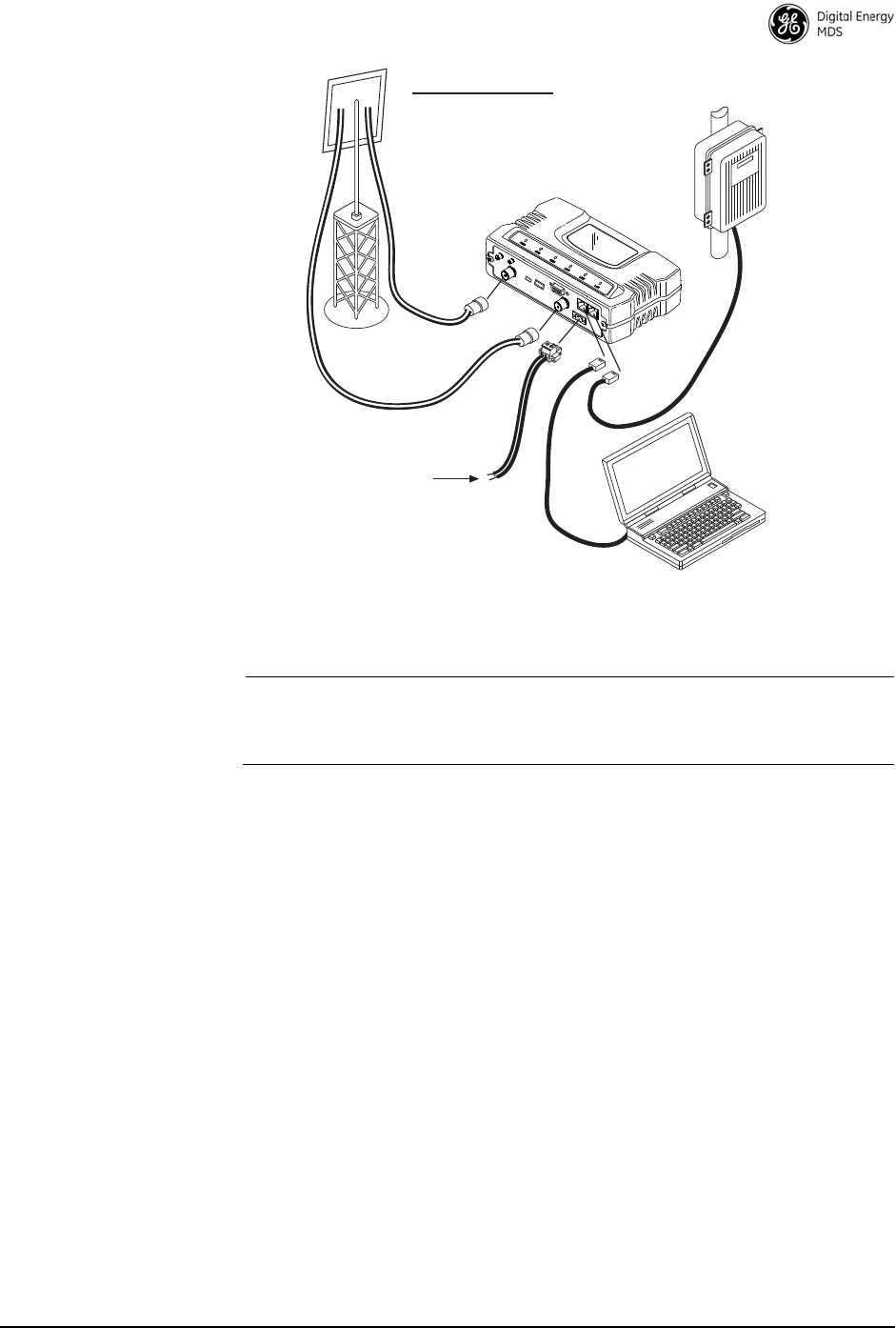
MDS 05-6302A01, Rev. B MDS Mercury 16E Technical Manual 49
Invisible place holder
Figure 32. Typical Installation with a Tower-Mounted Antenna
(SU shown; BS Similar)
NOTE: When using Power over Ethernet (PoE), do not use data lines
to carry power. Suitable power supply models are listed in the
GE MDS Accessories Guide.
Mounting Considerations
The unit is normally supplied with brackets for mounting to any flat sur-
face. If possible, choose a mounting location that provides easy access
to the connectors on the end of the radio and an unobstructed view of the
LED status indicators.
DIN Rail Mounting
Option The unit may also be mounted with an optional 35mm DIN Rail
Mounting Bracket (Part No. 03-4022A06). Equipment cabinets and
racks of recent design often employ this type of mounting. Once the DIN
bracket is mounted to the transceiver case, it allows for quick installa-
tion and removal of the radio without the need for tools of any kind.
Figure 33 shows how the DIN Rail bracket attaches to the back of the
unit’s case, and how the entire unit attaches to the mounting rail.
ANTENNA SYSTEM
Subscriber: Directional Ant.
Base Unit: Omni Ant.
TO DC POWER SUPPLY
(1060 Vdc)
RTU/PLC
LOW-LOSS COAX
PC FOR
RADIO MANAGEMENT
Ethernet Cable
to Radio
Ethernet Cable
to Radio

50 MDS Mercury 16E Technical Manual MDS 05-6302A01, Rev. B
Invisible place holder
Figure 33. DIN Rail Mounting of GE MDS Equipment
(Unit shown is for example only, and is not a Mercury Transceiver)
6.2 Site Selection
Suitable sites should provide:
• Protection from direct weather exposure
• A source of adequate and stable primary power
• Suitable entrances for antenna, interface or other required
cabling
• Antenna location that provides as unobstructed a transmission
path as possible in the direction of the associated station(s)
These requirements can be quickly determined in most cases. A possible
exception is the last item—verifying that an unobstructed transmission
path exists. Radio signals travel primarily by line-of-sight, and obstruc-
tions between the sending and receiving stations will affect system per-
formance. If you are not familiar with the effects of terrain and other
obstructions on radio transmission, the discussion below will provide
helpful background.
6.3 Equipment Grounding
To minimize the chance of damage to the transceiver and connected
equipment, a safety ground (NEC Class 2 compliant) is recommended
which bonds the antenna system, transceiver, power supply, and con-
nected data equipment to a single-point ground, keeping all ground leads
as short as possible.
Step 1: Attach the bracket using the Step 2: Snap the assembly onto the
DIN Rail. Removal is performed by
the two screws provided. (Attach to pulling down on the release tab.
the end opposite the connectors.)
Release Tab

MDS 05-6302A01, Rev. B MDS Mercury 16E Technical Manual 51
Normally, the transceiver is adequately grounded if the supplied flat
mounting brackets are used to mount the radio to a well-grounded metal
surface. If the transceiver is not mounted to a grounded surface, it is rec-
ommended that a safety ground wire be attached to one of the mounting
brackets or a screw on the transceiver’s case.
The use of a lightning protector is recommended where the antenna
cable enters the building; Bond the protector to the tower ground, if pos-
sible.
6.4 LAN Port
The transceiver’s LAN Port is used to connect the radio to an Ethernet
network. The transceiver provides a data link to an Internet Pro-
tocol-based (IP) network via the Base Station. Each radio in the network
must have a unique IP address for the network to function properly.
NOTE: Mercury transceivers are auto-sensing (auto-mdix) and can
connect to a hub or a PC using either a crossover or
straight-thru LAN cable.
The radio’s LAN port uses standard Ethernet RJ-45 cables and wiring.
For custom-made cables, use the pinout information in Figure 34 and
Table 14.
Figure 34. LAN Port (RJ-45) Pinout
(Viewed from the outside of the unit)
6.5 COM1 Port
To connect a PC to the transceiver’s COM1 port use a DB-9M to DB-9F
“straight-through” cable. These cables are available commercially, or
Table 14. LAN Port (IP/Ethernet)
Pin Functions Ref.
1 Transmit Data (TX) High
2 Transmit Data (TX) Low
3 Receive Data (RX) High
4 Unused
5 Unused
6 Receive Data (RX) Low
7 Unused
8 Unused
1 2 3 4 5 6 7 8

52 MDS Mercury 16E Technical Manual MDS 05-6302A01, Rev. B
may be constructed using the pinout information in Figure 35 and
Table 15.
Figure 35. COM1 Port (DCE)
(Viewed from the outside of the unit.)
6.6 Antenna & Feedline Selection
NOTE: The transceiver is a Professional Installation radio system and
must be installed by trained professional installers, or factory
trained technicians.
The text that follows is designed to aid the professional
installer in the proper methods of maintaining compliance with
FCC limits. Part 15 limits the power to +36 dBm or 4 watts
peak E.I.R.P limit. For WiMAX DTS radios, the maximum
allowed ERP is 1 Watt per MHz.
Antennas
The equipment can be used with a number of antennas. The exact style
used depends on the physical size and layout of a system. Contact your
factory representative for specific recommendations on antenna types
and hardware sources.
In general, a sector type antenna is used at the Base Station site. This
provides equal coverage to all of the Subscriber sites.
At Remote Gateway sites and units in point-to-point LANs, a directional
Yagi (Figure 36) antenna is generally recommended to minimize
interference to and from other users. Antennas are available from a
number of manufacturers.
Table 15. COM1 Port Pinout, DB-9F/RS-232 Interface
Pin Functions DCE
1 Unused
2 Receive Data (RXD) <—[Out
3 Transmit Data (TXD) —>[In
4 Unused
5 Signal Ground (GND)
6–9 Unused
1
5
96

MDS 05-6302A01, Rev. B MDS Mercury 16E Technical Manual 53
Invisible place holder
Figure 36. Typical Yagi Antenna (mounted to mast)
Feedlines
The choice of feedline used with the antenna should be carefully consid-
ered. Poor-quality coaxial cables should be avoided, as they will
degrade system performance for both transmission and reception. The
cable should be kept as short as possible to minimize signal loss. We
recommend using a low-loss cable type suited for the frequency of oper-
ation, such as Heliax®.
Table 16 lists several types of popular feedlines and indicates the
approximate signal losses (in dB) that result when using various lengths
of cable at 1800 MHz. Note that losses will be approximately doubled
for 3650 MHz and tripled for 5800 MHz. The choice of cable will
depend on the required length, cost considerations, and the amount of
signal loss that can be tolerated.
NOTE: The authority to operate the transceiver may be void if
antennas other than those approved by the applicable regula-
tory authority are used. Contact your factory representative for
additional antenna information.
Table 16. Length vs. Loss in Coaxial Cables at 1800 MHz
Cable Type 10 Feet
(3.05 m) 50 Feet
(15.24 m) 100 Feet
(30.48 m) 500 Feet
(152.4 m)
RG-214 1.52 dB 7.6 dB Unacceptable
Loss
Unacceptable
Loss
LMR-400 0.78 dB 3.9 dB 7.8 dB Unacceptable
Loss
1/2 inch HELIAX 0.46 dB 2.3 dB 4.58 dB Unacceptable
Loss
7/8 inch HELIAX 0.26 dB 1.28 dB 2.56 dB Unacceptable
Loss
1-1/4 inch HELIAX 0.20 dB 0.96 dB 1.9 dB 9.5 dB
1-5/8 inch HELIAX 0.16 dB 0.8 dB 1.6 dB 8.00 dB

54 MDS Mercury 16E Technical Manual MDS 05-6302A01, Rev. B
GPS Cabling & Antenna
The antenna to be used with the transceiver’s built-in GPS receiver
should be a 16 or 26 dBi active antenna designed for the GPS satellite
band. The GPS antenna connector delivers a 3 Vdc supply to power the
electronics in the active antenna.
6.7 Conducting a Site Survey
If you are in doubt about the suitability of the radio sites in your system,
it is best to evaluate them before a permanent installation is underway.
This can be done with an on-the-air test (preferred method); or indi-
rectly, using path-study software.
An on-the-air test is preferred because it allows you to see firsthand the
factors involved at an installation site and to directly observe the quality
of system operation. Even if a computer path study was conducted ear-
lier, this test should be done to verify the predicted results.
The test can be performed by first installing a radio and antenna at the
proposed Base Station (BS) site (one-per-system). Then visit the Sub-
scriber site(s) with another transceiver and a hand-held antenna. (A PC
with a network adapter can be connected to each radio in the network to
simulate data during this test using the PING command.)
With the hand-held antenna positioned near the proposed mounting
spot, a technician can check for synchronization with the Base Station
(shown by a lit LINK LED on the front panel) and measure the reported
RSSI value. (See “Antenna Heading Optimization” on Page 56 for
details.) If adequate signal strength cannot be obtained, it may be neces-
sary to mount the station antennas higher, use higher gain antennas,
select a different site or consider installing a repeater station.
6.8 A Word About Radio Interference
The transceiver shares the RF spectrum with other services and devices.
As such, near 100% error-free communications may not be achieved in
a given location, and some level of interference should be expected.
However, the radio’s flexible design should allow adequate perfor-
mance as long as care is taken in choosing station location, configura-
tion of radio parameters and software/protocol techniques.
In general, keep the following points in mind when setting up your com-
munications network.
• Systems installed in rural areas are least likely to encounter interfer-
ence; those in suburban and urban environments are more likely to
be affected by other devices operating in the same spectrum.
• Use a directional antenna at remote sites whenever possible.

MDS 05-6302A01, Rev. B MDS Mercury 16E Technical Manual 55
Although these antennas may be more costly than omnidirectional
types, they confine the transmission and reception pattern to a com-
paratively narrow lobe, that minimizes interference to (and from)
stations located outside the pattern.
• If interference problems persist, try reducing the length of data
streams. Groups of short data streams have a better chance of getting
through in the presence of interference than do long streams.
• The power output of all radios in a system should be set for the low-
est level necessary for reliable communications. This lessens the
chance of causing unnecessary interference to nearby systems.
If you are not familiar with these interference-control techniques, con-
tact your factory representative for more information.
6.9 Radio (RF) Measurements
There are several measurements that should be performed during the ini-
tial installation. These will confirm proper operation of the unit and if
recorded, can serve as a benchmark for troubleshooting should difficul-
ties appear in the future. These measurements are:
• Transmitter Power Output
• Antenna System SWR (Standing Wave Ratio)
• Antenna Heading Optimization (RSSI)
These procedures may interrupt traffic through an established network
and should only be performed by a skilled radio-technician in coopera-
tion with the network manager.
Transmitter Power Output and Antenna System SWR
Introduction A proper impedance match between the transceiver and the antenna
system is important. It ensures the maximum signal transfer between the
radio and antenna. The impedance match can be checked indirectly by
measuring the SWR (Standing Wave Ratio) of the antenna system. If the
results are normal, record them for comparison for use during future
routine preventative maintenance. Abnormal readings indicate a pos-
sible trouble with the antenna or the transmission line that will need to
be corrected.
The SWR of the antenna system should be checked before the radio is
put into regular service. For accurate readings, a wattmeter suited to the
frequency of operation is required. One example of such a unit is the
Bird Model 43™ directional wattmeter with an appropriate element
installed.
The reflected power should be less than 10% of the forward power
(2:1 SWR). Higher readings usually indicate problems with the
antenna, feedline or coaxial connectors. If the reflected power is more
than 10%, check these areas for damage.

56 MDS Mercury 16E Technical Manual MDS 05-6302A01, Rev. B
Procedure 1. Place a directional wattmeter between the radio (TX/RX connector)
and the antenna system.
2. With the transmitter keyed, measure the forward and reflected
power on the wattmeter. Reflected power should be no more than
10% of the forward power. Record these readings for future refer-
ence.
NOTE: The transmitter has a 10-minute timer. When in test mode, it
will dekey after 10 minutes of continuous operation. The
Radio can also be dekeyed by temporarily disconnecting the
radio’s DC power.
3. Dekey the transmitter and disconnect the wattmeter. Reconnect the
antenna feedline to the radio.
End of procedure
Antenna Heading Optimization
Introduction The radio network integrity depends, in a large part, on stable radio
signal levels being received at each end of a data link. In general, signals
stronger than –80 dBm provide reliable communication that includes a
fade margin for signal variances. As the distance between the Base Sta-
tion and Subscriber Unit increases, the influence of terrain, foliage and
man-made obstructions become more influential and the use of direc-
tional antennas at Remote locations becomes necessary. Directional
antennas usually require some fine-tuning of their bearing to optimize
the received signal strength. The transceiver has a built-in received
signal strength indicator (RSSI) that can be used to tell you when the
antenna is in a position that provides the optimum received signal.
RSSI measurements and Wireless Packet Statistics are based on mul-
tiple samples over a period of several seconds. The average of these
measurements will be displayed by the Management System.
The path to the Management System menu item is shown in bold text
below each step of the procedure.
Procedure 1. Verify that the Subscriber is associated with the Base Unit unit by
observing that the LINK LED is on or blinking).
2. View and record the Packets Dropped and Receive Errors on the
LAN1/LAN2 Statistics window. This information will be used later.
3. Clear the LAN1/LAN2 Statistics.
4. Read the RSSI level at the Subscriber Unit.
(Maintenance & Status>>Performance>>RSSI)

MDS 05-6302A01, Rev. B MDS Mercury 16E Technical Manual 57
5. Optimize RSSI (less negative indicates a stronger signal) by slowly
adjusting the direction of the antenna. Watch the RSSI for several
seconds after making each adjustment so that it accurately reflects
any change in the link signal strength.
6. Once RSSI is optimized, view the Packets Dropped and Receive Error
rates. They should be the same or lower than the previous (recorded)
readings.
If the RSSI peak results in an increase in the Wireless Packets Dropped
and Received Error, the antenna may be aimed at an undesired signal
source. Try a different antenna orientation.
End of procedure.
7.0 PERFORMANCE NOTES
The following is a list of points that are useful for understanding the per-
formance of the radio in your installation.
7.1 Wireless Bridge
The transceiver acts as a Layer 2 network bridge. If any radio in your
network is connected to a large LAN, such as may be found in a large
office complex, there may be undesired multicast/broadcast traffic over
the air. As a bridge, the radios transmit this type of frame.
The radio goes through a listening and learning period at start-up before
it will send any packets over either of its ports. This is about 10 seconds
after the CPU’s operating system has finished its boot cycle.
The bridge in the transceiver operates and makes decisions about packet
forwarding just like any other bridge. The bridge builds a list of source
MAC addresses that it has seen on each of its ports.
There are a few general rules that are followed when a packet is received
on any port:
• If the destination address is a multicast or broadcast address,
forward the packet to all ports.
• If the destination address is not known, forward the packet to
all ports.
• If the destination address is known, forward the packet to the
port that the destination is known to be on.
• Spanning Tree Protocol (STP) is used by the bridge to pre-
vent loops from being created when connecting bridges in
parallel. For example, connecting two remotes to the same
wired LAN could create a loop if STP was not used. Every

58 MDS Mercury 16E Technical Manual MDS 05-6302A01, Rev. B
bridge running STP sends out Bridge Protocol Data Units
(BPDUs) at regular intervals so that the spanning tree can be
built and maintained. BPDUs are 60-byte multicast Ethernet
frames.
NOTE: STP expected availability is mid-2012.
7.2 Distance-Throughput Relationship
Distance affects throughput. Because of timers and other components of
the protocol, there is a practical distance limit of 30 miles (48 km) for
reliable operation. After this, although data still flows, the throughput
will begin to drop and latency will increase, due to additional retries
between the radios. Packets may start to be dropped. Some applications
may tolerate this; others may not. Repeater stations may be used to
extend the range.
7.3 Data Latency—TCP versus UDP Mode
The latency of data passing through a network will depend on user data
message length, the overall level of traffic on the network, and the
quality of the radio path.
Under ideal conditions—and without the use of QoS—with low traffic
and good RF signal path, the latency for units operating in the TCP
mode will typically be around 50 ms in each direction.
7.4 Packets-per-Second (PPS)
The radio has a data speed limit of approximately 1000 PPS. Consider
this restriction when planning your network, especially when smaller
packets are expected to make up the majority of the traffic as is the case
with VoIP (Voice over IP). Actual speed can vary depending on network
conditions. Consult your system designer for more detail.
7.5 Subscriber-to-Subscriber Traffic
When sending frames from an endpoint connected to one Subscriber to
another endpoint with a different Subscriber, the throughput will be
halved at best. This is because all frames must go through the Base Sta-
tion and thus are transmitted twice over the same radio system. There-
fore, in the previous 100-byte UDP example, the number of over-the-air
bytes will be 380 bytes (190 bytes x 2) if the frame has to go sub-
scriber-to-subscriber.

MDS 05-6302A01, Rev. B MDS Mercury 16E Technical Manual 59
7.6 Interference has a Direct Correlation to
Throughput
Interference could be caused by other radios at the same site, in nearby
locations, or by high power transmitters such as paging systems. Such
interference will have a negative effect on data throughput of the radio
system.
7.7 Placing the Radio Behind a Firewall
Mercury radios use the port numbers listed below. If you place the radio
behind a firewall, make sure these port numbers are included in the
allowed list:
• FTP 21 <- Reprogramming
• SSH: 22 <- Management
• TELNET: 23 <- Management
• TFTP: 69 <- Reprogramming
• HTTP: 80 <- Management
• NTP: 123 <- Time server
• SNMP: 161 <- Management
• SNMP-TRAP: 162 <- Event management via traps
• HTTPS: 443 <- Management
• SYSLOG: 514 <- Event management via remote syslog
server
These well-known port numbers follow the recommendation of IANA.
For details, visit the following link:
www.iana.org/assignments/port-numbers

60 MDS Mercury 16E Technical Manual MDS 05-6302A01, Rev. B
8.0 INDEX OF CONFIGURATION
PARAMETERS
Table 17 contains brief explanations of the parameters and selections
available through the Mercury user interface. The list is intended to be a
reference, and not an exhaustive discussion of every possible menu
function. Users should consult the built-in Help option available from the
top of each menu screen for additional assistance, as required.
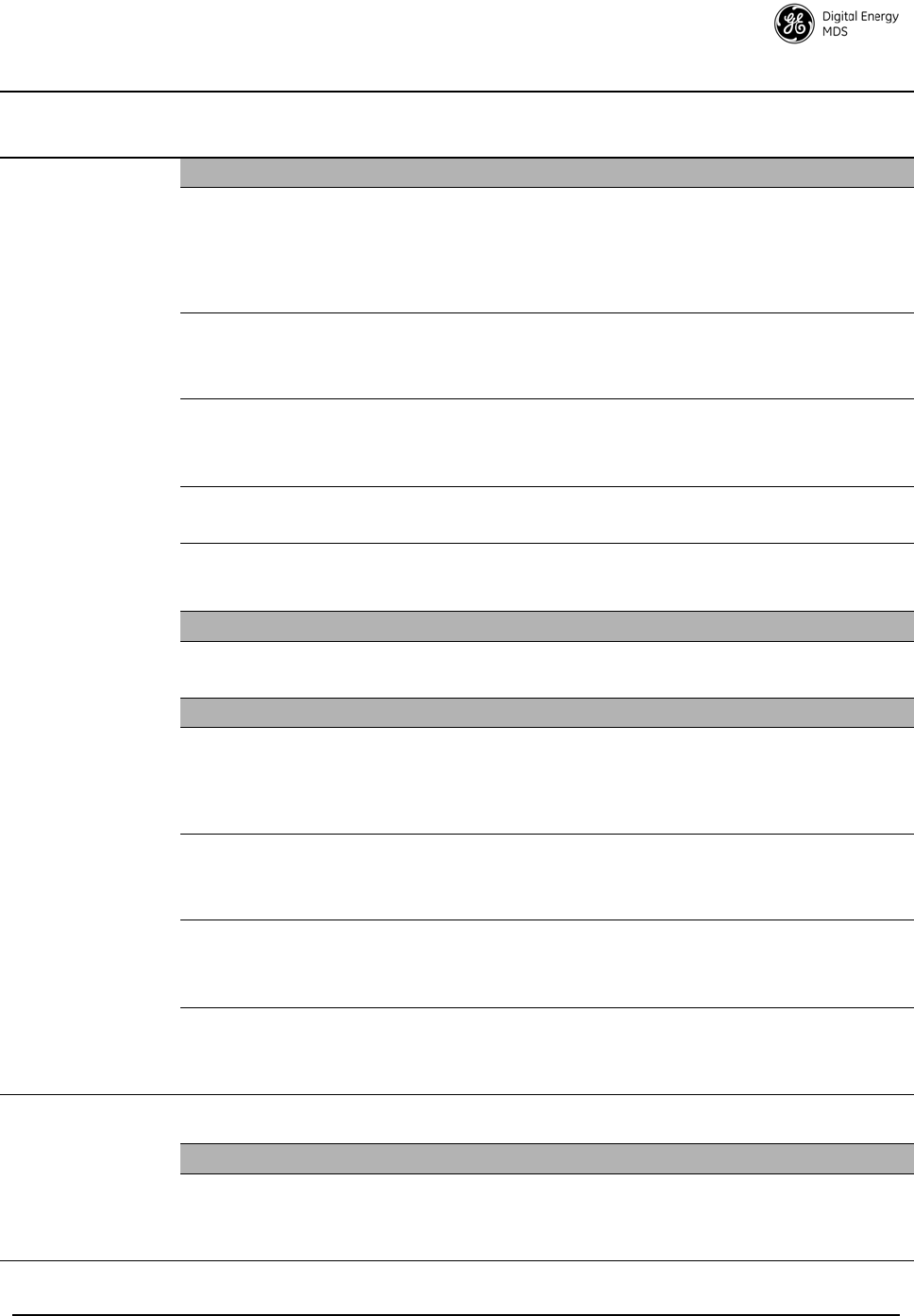
MDS 05-6302A01, Rev. B MDS Mercury 16E Technical Manual 61
Table 17. Configuration Parameters
Menu Location Parameter Name Description Default Value
Possible Values
Configuration –
Identity & Time Device Information
Device Name The Device Name is a
user-configurable parameter that is
used to ease configuration and
monitoring. Typically this parameter is
set to a label that makes it easy to
identify the specific unit.
<blank>
Up to 40 characters
Contact The Contact parameter is used to
indicate a contact in case of inquiry or
problem with the unit. This parameter
is used for the SNMP MIB-II object.
<blank>
Up to 40 characters
Location The Location parameter is used to
indicate the physical location of the
device. This parameter is used for the
SNMP MIB-II object.
<blank>
Up to 40 characters
Description This parameter is used for the SNMP
MIB-II object.
<blank>
Up to 40 characters
Console Baud Rate This parameter controls the baud rate
of the DB-9 RS-232 serial port in
console mode.
115200 bps
1200 to 115200 bps
Date Format
Date Format The date format adjusts how the
current date is displayed.
Generic
US, EUR, Generic
Date/Time
SNTP Server This parameter is used to set the
address of an SNTP (Simple Network
Time Protocol) server on the network.
The device will get its time of day from
the server.
0.0.0.0
Date Current date. This can be set manually
or through the use of GPS (if optional
hardware is present) or an SNTP
server.
n/a
Time Current time. This can be set manually
or through the use of GPS (if optional
hardware is present) or an SNTP
server.
n/a
UTC Time Offset The UTC Time Offset is used to adjust
the time of day to local time. For
example Eastern Standard Time has a
-5 UTC offset.
0
-12 to 12
Configuration – IP
& Networking Network Interface (no configurable items)
IP Address
IP Address Mode The Mercury transceiver can be
configured with a static IP address or it
can used DHCP to obtain an IP
address from a server on the network.
Static
Static or Dynamic

62 MDS Mercury 16E Technical Manual MDS 05-6302A01, Rev. B
Static IP Address This is the IP address that the Mercury
transceiver uses for its management
interfaces (web, SNMP, SSH, and
telnet).
192.168.1.1
Static IP Netmask This is the Netmask used in
conjunction with the Static IP Address
255.255.255.0
Static IP Gateway This is the IP address of a Gateway
device on the network used for
inter-subnet routing.
0.0.0.0
Serial VLAN IP Address
Serial IP Address
Mode
Use static IP address or obtain one
from the network server.
Static
Static, Dynamic
Serial IP Address IPv4 serial VLAN address of this unit.
Needed if DHCP is off on serial VLAN.
192.168.2.1
Serial IP Netmask IPv4 serial VLAN subnet mask. of this
unit. Needed if DHCP is off on serial
VLAN.
255.255.255.0
Serial IP Gateway IPv4 serial VLAN. of this unit. Needed
if DHCP is off on serial VLAN.
0.0.0.0
VLAN Settings
VLAN Status The VLAN Status parameter controls
whether the VLAN capability of the
device is enabled or not. Enabling the
VLAN Status allows the configuration
of trunk and access ports along with
VLAN IDs and VLAN IP Addresses.
Disabled
VLAN Ethport Mode Defines if the Ethernet port acts as a
trunk port or as an access port. Auto
mode defines the port as a trunk port in
an AP, or an access port in a Remote
radio.
Auto
Auto, Trunk, Access
Management VLAN ID Defines the VLAN ID for traffic directed
to the radio itself, other than the
terminal server process. This VLAN ID
is used for filtering and for tagging
purposes.
2
1-4094
Serial VLAN ID Defines the serial VLAN ID assigned to
traffic directed to and from the Ethernet
port and the terminal server process in
the radio. This VLAN ID is used for
filtering and tagging purposes.
3
1-4094
LAN1 VLAN ID VLAN ID for Ethernet port 1. 4
1-4094
LAN2 VLAN ID Only for IDU BS/SU. VLAN ID for
Ethernet port 2.
4
1-4094
Default Route IF Defines the VLAN that contains the
default gateway in the radio.
MGMT
MGMT, SERIAL
Management VLAN
Mode
Applies the VLAN tag to management
frames.
Tagged
Tagged, Native
Table 17. Configuration Parameters (Continued)
Menu Location Parameter Name Description Default Value
Possible Values
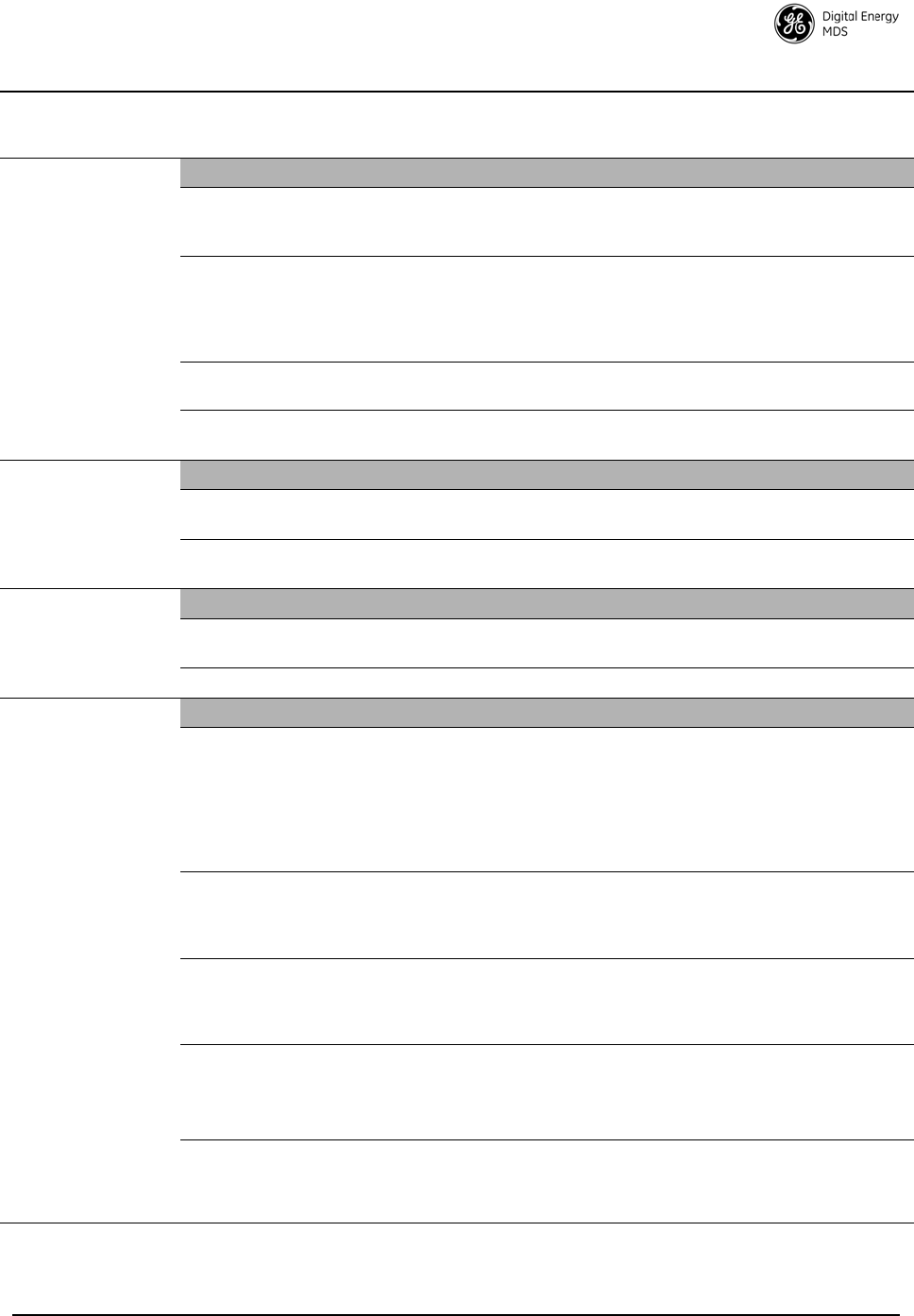
MDS 05-6302A01, Rev. B MDS Mercury 16E Technical Manual 63
Port Status (LAN)
LAN1/2 Port Enable LAN is enabled/disabled. Note that
LAN2 only applies to BS/SU indoor
units (IDUs).
Enabled
Enabled, Disabled
LAN1/2 Port Phy Rate Speed/Duplex of LAN port.
Over-the-air link status depends on
Base Station’s LAN connection. Note
that LAN2 only applies to BS/SU indoor
units (IDUs).
Auto
10 MB, Half Duplex
10 MB, Full Duplex
100 MB, Half Duplex
100 MB, Full Duplex
LAN 1/2 Port Follows
Association (SU only)
If enabled, SU’s LAN port functions
depending on its associated status.
Disabled
Enabled, Disabled
LAN1/2 Port Phy
Status
Read-only indication of whether port is
connected or not connected.
--
LAN1 Filtering
Enable LAN1 Filtering Turns on LAN filtering. Disabled
Enabled, Disabled
LAN1 Address 1-8 Turns on LAN filtering. 0.0.0.0
Valid IP address
LAN2 Filtering (IDU BS/SU only)
Enable LAN2 Filtering Turns on LAN filtering. Disabled
Enabled, Disabled
LAN2 Address 1-8 Turns on LAN filtering. Valid LAN 2 address
802.11 (units with Wi-Fi only)
802.11 Mode Configures the Wi-Fi radio to be an
Access Point for other Wi-Fi devices
(Access Point), to connect to a Wi-Fi
Access Point at another location
(Station), to connect directly to another
Wi-Fi device (Ad-Hoc), or to be
disabled (disabled).
Disabled
Access Point, Station,
Ad-Hoc, Disabled
802.11 SSID Service Set Identifier, the name of the
wireless LAN to which to connect. This
is equivalent to Network Name in GE
MDS terminology.
40-character string
Broadcast 802.11
SSID
When enabled, the SSID of the Wi-Fi
Access Point is broadcast over the air
so that stations will detect the APs
presence.
Enabled
Enabled, Disabled
802.11 Channel (Applies only when 802.11 Mode is set
to Access Point or Ad-Hoc). Sets the
802.11 channel the device will use.
Channel 6
Ch. 1-11 (N. America)
Ch. 1-14 (Japan)
Ch. 1-13 (other regions)
802.11 Station
Timeout (AP only)
Determines how quickly inactive
stations are “aged out” of the Wi-Fi
Access Point’s database.
2 minutes
1 to 240 minutes
Table 17. Configuration Parameters (Continued)
Menu Location Parameter Name Description Default Value
Possible Values

64 MDS Mercury 16E Technical Manual MDS 05-6302A01, Rev. B
TX Power Transmit power of the Wi-Fi radio in
dBm.
15 dBm
1-18 dBm
Log 802.11 Events Enable/Disable logging of Wi-Fi events
in the Event Log.
Disabled
Enabled, Disabled
NIC in Bridge
(AP only)
When enabled, the Wi-Fi interface is
bridged to the Network Interface Card,
allowing traffic to pass between the
Wi-Fi and the other interfaces (LAN
and wireless).
Enabled
Enabled, Disabled
IP Settings
(Only applies when NIC in Bridge is disabled)
802.11 IP Address
Mode
Defines the source of the IP address of
the Wi-Fi device.
Static
Static, Dynamic
802.11 IP Address The IPv4 local IP address. 192.168.1.1
Valid IP address
802.11 IP Netmask The IPv4 local subnet mask. 255.255.0.0
Valid subnet mask
IP Gateway The IPv4 address of the network
gateway device, typically a router. This
field is unnecessary if DHCP is
enabled.
0.0.0.0
Valid IP address
Security Settings
802.11 Privacy Mode Determines which privacy mode is
used. The 802.11 Security Menu
appears differently depending on
which privacy mode is selected.
None
None, WEP, WPA-PSK,
WPA Enterprise, WPA2
Personal, WPA2 Enterprise
802.11 WEP
Encryption
Determines the strength of the WEP
encryption.
128 Bit
64 Bit, 128 Bit
WEP Passphrase A user-entered combination of
characters that is used to generate a
WEP Key.
Valid WEP passphrase
WEP Key A security code that is generated using
the Wireless Equivalency Protocol. It is
generated by the entry of a WEP
Passphrase (see above) This key
should be entered in hexadecimal
format preceded by 0x. The key should
be 13 or 26 hexadecimal characters.
For example:
1a2b3c4d5e6f709a8b7c6d5e4f.
Valid hexidecimal key
Table 17. Configuration Parameters (Continued)
Menu Location Parameter Name Description Default Value
Possible Values
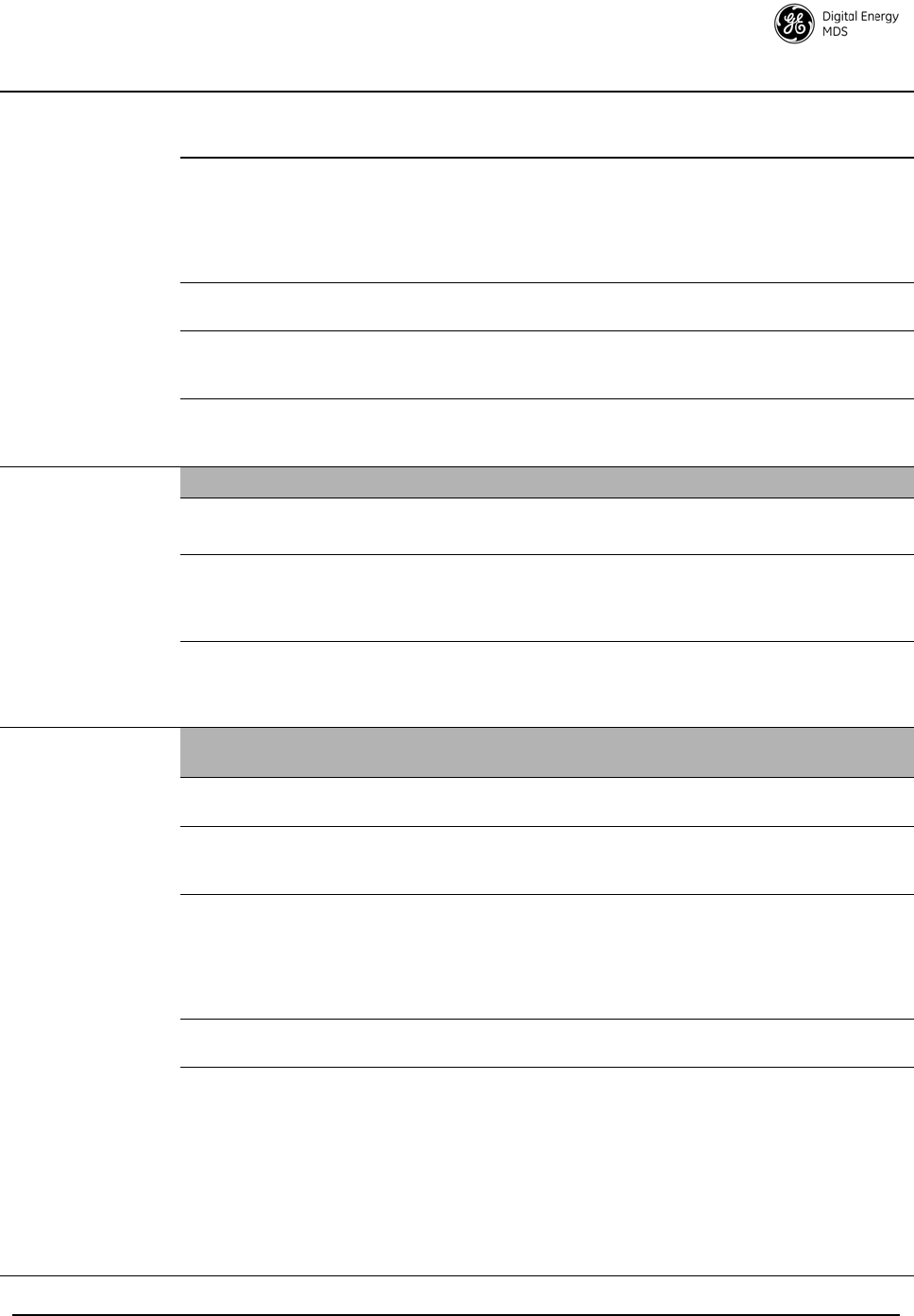
MDS 05-6302A01, Rev. B MDS Mercury 16E Technical Manual 65
WEP Auth Mode Determines the authentication mode
used by the radio. This parameter is
not configurable, as the radio only
supports Open System. The entry is
provided as a reminder of the mode,
but it cannot be changed.
Open
802.11 WPA
Encryption
Type of encryption security used in
WPA security modes.
TKIP
TKIP, CCMP
Preshared Key Preshared key exchanged between
units while in WPA-PSK and
WPA-Personal security modes.
0 to 40 characters
EAP Method Certificate based security used while in
WPA+WPA2 Enterprise security
modes.
EAP-TLS
Bridge
Bridge Priority View/set the priority of the bridge in the
spanning tree.
32769
0-65535
Bridge Hello Time View/set spanning tree hello time. This
parameter affects how often the bridge
sends a spanning tree Bridge Protocol
Data Unit (BPDU).
2 seconds
1-10 seconds
Bridge Forward Delay View/set spanning tree forwarding
delay. Affects how long the bridge
spends listening and learning after
initialization.
5 seconds
4-30 seconds
Configuration -
Radio Radio Configuration
Modem Operation Enable/Disable the modem Enabled
Enabled, Disabled
Transmit Power BS only. Transmit Power (AP
Only)—Sets/displays RF power output
level in dBm.
--
0-30 dBm (1800, 3650)
0-17 dBm (5800)
Max. Transmit Power SU only. Max Transmit Power—
Sets/displays maximum RF power
output level in dBm of the Remote.
Power level is still controlled by the AP,
but it is limited to the maximum level
set here.
--
0-30 dBm (3650 IDU)
0-23 dBm (3650 ODU)
0-17 dBm (5800 IDU)
0-18 dBm (5800 ODU)
0-30 dBm (1800 ODU/IDU)
Max. Initial RX
Ranging
BS only. The maximum allowable initial
ranging power from the SU.
-60 dBm
-10 to -90 dBm
WiMAX Range
Extension
BS only. Modifies ranging parameters
to accommodate subscribers located
at distances more than 13.7 km (8.51
miles). Specifically, the number of
CDMA codes available for ranging is
increased. This allows greater
coverage radius while slightly
increasing the average initial link time
(less than one second longer).
Disabled
Disabled, Enabled
Table 17. Configuration Parameters (Continued)
Menu Location Parameter Name Description Default Value
Possible Values

66 MDS Mercury 16E Technical Manual MDS 05-6302A01, Rev. B
Frequency
Frequency This is the operating frequency of the
WiMAX radio interface. Frequency
range limits can be affected by
bandwidth selection.
1815, 3662.5, or 5800 MHz
1800 to 1830
(1800 models)
3651.75 to 3670
(3650 models)
5725 to 5825
(5800 models)
RF Bandwidth This is the operating bandwidth of the
WiMAX radio interface.
3.5 MHz
3.5, 5, 7, 8.75, 10
Frame Profile The Frame Profile controls the amount
of time allocated to the downlink and
uplink portions of the WiMAX frame. To
operate in a WiMAX compatible mode,
choose one of the specific profiles for
the chosen RF bandwidth. The Frame
Profile can also be set to None. When
set to None, the user can set a specific
percentage for the downlink sub-frame.
None
None,
3.5 MHz-21-12,
5 MHZ-29-18,
5 MHz-30-17,
5 MHz-32-15,
7 MHz-21-12,
8.75 MHZ-27-15,
10 MHz-26-21,
10 MHz-29-18,
10 MHz-32-15,
10 MHz-35-12
Downlink
Percentage
The percentage of the frame to be
used for the Downlink subframe. This
parameter only applies when the
Frame Profile is set to None
50
30-75
TDD SyncMode Specifies if GPS timing
synchronization is required to downlink
transmission.
Free Run
Free Run, GPS Required
Advanced Settings
Uplink Modulation BS only. The uplink modulation type to
use, or auto-adaptive UL modulation.
Automatic
QPSK-1/2
QPSK-3/4
QAM16-1/2
QAM16-3/4
QAM64-1/2
QAM64-2/3
QAM64-3/4
QAM64-5/16
Downlink Modulation Same as above, but for downlink.
(Applies to BS only.)
See above selections
Adaptive Modulation
Estimation Margin
BS only. Estimation margin for
adaptive modulation.
3 dB
0 to 100 dB
Adaptive Modulation
Threshold
BS only. Threshold for adaptive
modulation.
3 dB
0-100 dB
Table 17. Configuration Parameters (Continued)
Menu Location Parameter Name Description Default Value
Possible Values

MDS 05-6302A01, Rev. B MDS Mercury 16E Technical Manual 67
MIMO Type The MIMO Type parameter controls
the use of the second RF antenna port.
In Matrix A/B mode, the Mercury
transceiver automatically chooses the
appropriate operating mode according
to the packet error rate (PER)
performance of the wireless channel.
None
None, Matrix A, Matrix A/B
HARQ BS only. This is the Base Station
parameter that enables the use of
Hybrid Automatic Repeat Request.
Enabled
Enabled, Disabled
Protection Margin SU only. Protection margin for adaptive
modulation.
3 dB
0 to 10
Hysteresis Margin SU only. A number of decibels of SNR
added to the maximum SNR required
before shifting to the next higher
modulation and FEC rate.
3 dB
0 to 10 dB
ARQ/HARQ Settings
ARQ BS only. This is the Base Station
parameter that enables the use of
Automatic Repeat Request.
Disabled
Enabled, Disabled
ARQ Block Size BS only. The Block Size specifies the
number of bytes that are placed into an
ARQ block. The ARQ block is the basic
unit of exchange in the ARQ protocol.
64 bytes
16 to 1024 bytes
ARQ Window Size BS only. The Window Size specifies
the number of ARQ blocks in the ARQ
Window. The ARQ Window is the
number of blocks that can be
outstanding at one time.
512 blocks
1 to 1024 blocks
ARQ Block
Lifetime
BS only. The Block Lifetime specifies
how long an ARQ block is considered
valid after the block’s initial
transmission. If the receiver does not
acknowledge the block within the
lifetime, the block is discarded.
250 msec
0 to 655 msec
ARQ Transmitter
Delay
BS only. Length of time ARQ
transmitter waits before repeating an
unacknowledged packet.
35 msec
1 to 655 msec
ARQ Receiver
Delay (BS only)
ARQ delay at the receiver in
milliseconds
35 msec
1 to 655 msec
HARQ Category SU only. This is the Subscriber
parameter that selects the type of
Hybrid Automatic Repeat Request that
is used.
3
1 to 4
Table 17. Configuration Parameters (Continued)
Menu Location Parameter Name Description Default Value
Possible Values

68 MDS Mercury 16E Technical Manual MDS 05-6302A01, Rev. B
Configuration-QoS
(Applies to BS only) QoS
QoS Traffic Shaping Traffic shaping affects all QoS-enabled
PSFs, including the default SFs. When
shaping is enabled, the BS delays
packet transmission if the maximum
rate is reached. When shaping is
disabled, packets are dropped.
Enabling shaping improves throughput
at the cost of delayed packets.
Disabled
Enabled, Disabled
Active Service Flows
Manage Provisioned Service Flows
Table View View the table of compiled QoS data. Basic
Basic, Advanced
Configuration-
Services DHCP Server
DHCP Server Status This parameter enables the on-board
DHCP server.
Disabled
Enabled, Disabled
DHCP Netmask This is the netmask that the on-board
server specifies to its clients.
0.0.0.0
Valid IP Address
DHCP starting
address
This is the first IP address in the
server’s pool.
0.0.0.0
Valid IP Address
DHCP ending address This is the last IP address in the
server’s pool.
0.0.0.0
Valid IP Address
DHCP DNS address This is the DNS server IP address that
the server specifies to its clients.
0.0.0.0
Valid IP Address
DHCP WINS address This is the WINS server IP address that
the server specifies to its clients.
0.0.0.0
Valid IP Address
Serial VLAN DHCP Server
Serial VLAN DHCP
Server Status
Status of DHCP Server on serial VLAN
interface.
Disabled
Enabled, Disabled
Serial VLAN DHCP
Netmask
The netmask sent to DHCP clients on
the serial VLAN interface.
0.0.0.0
Valid IP Address
Serial VLAN DHCP
starting address
The start address to administer to
DHCP clients on the serial VLAN
interface.
0.0.0.0
Valid IP Address
Serial VLAN DHCP
ending address
The end address to administer to
DHCP clients on the serial VLAN
interface.
0.0.0.0
Valid IP Address
Serial VLAN DHCP
DNS address
The DNS Server address sent to
DHCP clients on the serial VLAN
interface.
0.0.0.0
Valid IP Address
Serial VLAN DHCP
WINS address
The WINS Server address sent to
DHCP clients on the serial VLAN
interface.
0.0.0.0
Valid IP Address
SNMP
Table 17. Configuration Parameters (Continued)
Menu Location Parameter Name Description Default Value
Possible Values

MDS 05-6302A01, Rev. B MDS Mercury 16E Technical Manual 69
SNMP Mode This parameter specifies the
protocol(s) that the SNMP agent
should support.
Disabled
Disabled, V1-only, V2-only,
V3-only, V1-V2, V1-V2-V3
Read Community SNMP community name with
SNMPv1/SNMPv2c read access. This
string.
<blank>
Can contain up to 30
alpha-numeric characters
Write Community SNMP community name with
SNMPv1/SNMPv2c write access. This
string.
<blank>
Can contain up to 30
alpha-numeric characters
V3 Password Mode Determines whether V3 passwords will
be managed locally
Manager
Manager, Local
V3 Auth Password Authentication password stored in
flash memory. This is used when the
Agent is managing passwords locally
(or initially for all cases on reboot). This
is the SNMPv3 password used for
Authentication (currently, only MD5 is
supported). This string can contain up
to 30 alpha-numeric characters.
<blank>
Up to 30 alpha-numeric
characters
V3 Priv Password Privacy password stored in flash
memory. Used when the SNMP Agent
is managing passwords locally (or
initially for all cases on reboot). This is
the SNMPv3 password used for
privacy (DES encryption). This string
can contain between 8 and 30
alpha-numeric characters.
<blank>
Between 8 and 30
alpha-numeric characters
Traps Version This specifies which version of SNMP
is used to encode the outgoing traps.
v1_traps, v2_traps, or
v3_traps.
(When v3_traps is selected,
v2-style traps are sent, but
with a v3 header.
Trap Community SNMP community name with
SNMPv1/SNMPv2c trap access. This
string can contain up to 30
alpha-numeric characters.
<Blank>
Trap Manager #1-4 IP location on the network to which
traps are sent.
<blank>
Any standard IP address
Auth Trap Status Indicates whether or not traps are
generated for failed authentication of
an SNMP PDU.
Disabled
Enabled, Disabled
Iperf Status
Iperf Status Enable Iperf Server that can be used
for throughput testing.
Disabled
Disabled, Enabled
Configuration –
Security
Device Security
Table 17. Configuration Parameters (Continued)
Menu Location Parameter Name Description Default Value
Possible Values
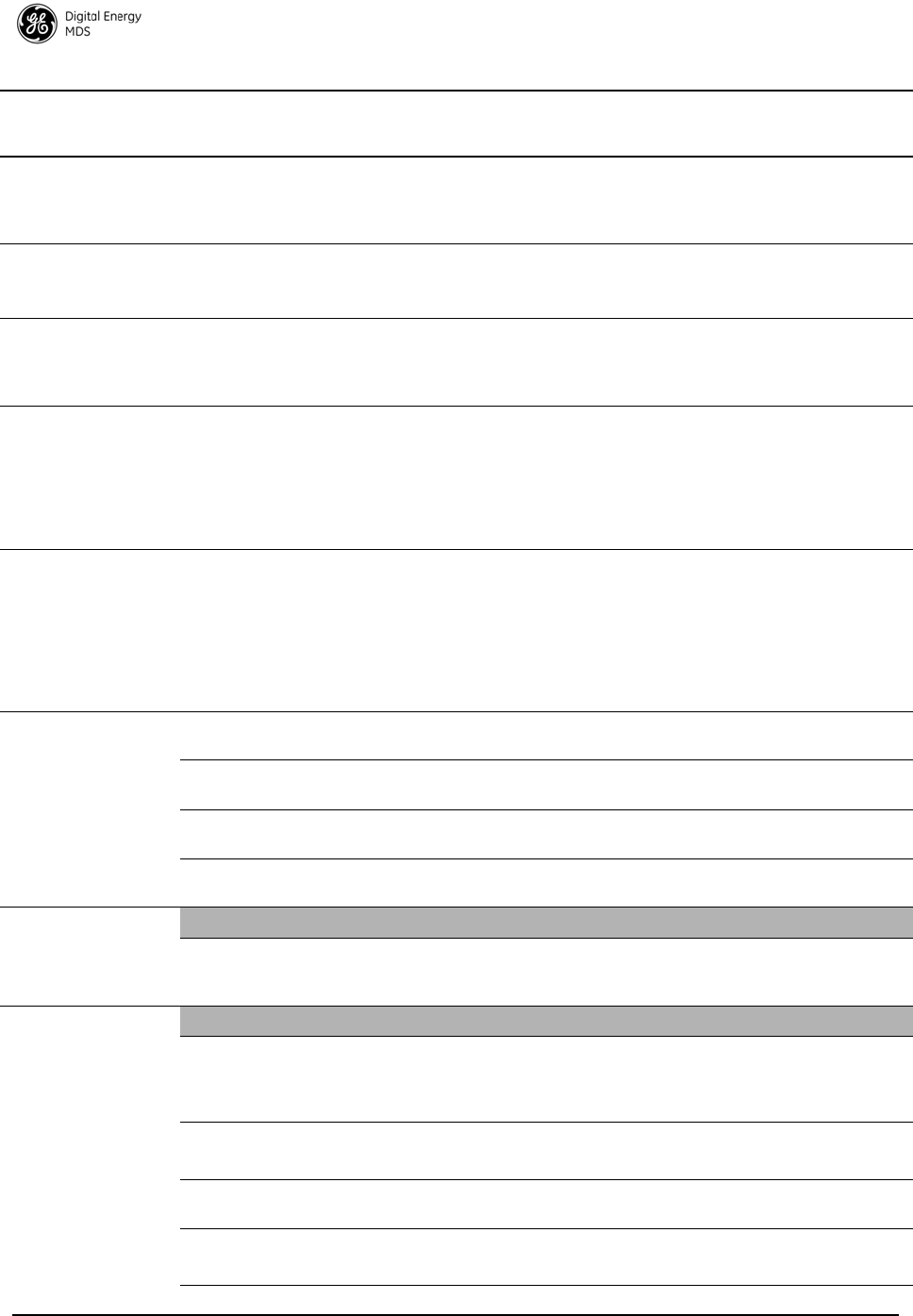
70 MDS Mercury 16E Technical Manual MDS 05-6302A01, Rev. B
Telnet Access This parameter allows or disallows the
TELNET interface to operate. For
secure installations, it is recommended
that TELNET be disabled.
Enabled
Enabled, Disabled
SSH access This parameter allows or disallows the
SSH interface to operate.
Enabled
Enabled, Disabled
HTTP Mode The operation of the web server can be
disabled or set to HTTP or HTTPS
mode. The HTTPS mode provides a
level of security.
HTTP
Disabled, HTTP, HTTPS
User Auth Method The username and password of a user
can be validated locally against the
information that the device has or it can
be validated using RADIUS. The use of
RADIUS requires configuration of
parameters on the RADIUS
configuration screen.
Local
Local, RADIUS
User Auth Fallback If the User Auth Method is RADIUS but
the RADIUS Server cannot be
reached, this parameter determines if
the local password information is used
to validate the user’s credentials. If this
parameter is set to None, then only the
RADIUS server can validate the
credentials.
None
None, Local
USB Host Port Enables/disables USB host port. Enabled
Enabled, Disabled
USB Device Port Enables/disables USB device port. Enabled
Enabled, Disabled
Serial Console Enables/Disables the serial console
interface.
Enabled
Enabled, Disabled
User Login Banner Blank
Up to 254 characters
Wireless Security
Device Auth Mode Determines if WiMAX PKMv2 security
is enabled. A Test Auth selection is
also available.
None
None, PKMv2, Test Auth
RADIUS
Server 1 Address This is the IP address of the RADIUS
server. The device can also be
configured with a secondary, backup
RADIUS server.
0.0.0.0
Server 1 Port The UDP port that the RADIUS server
is listening on.
1812
0-65535
Shared Secret 1 The secret phrase shared between the
RADIUS server and client.
<blank>
User Auth Mode 1 The authentication protocol used
between the RADIUS server and client.
PAP
PAP, CHAP
Table 17. Configuration Parameters (Continued)
Menu Location Parameter Name Description Default Value
Possible Values

MDS 05-6302A01, Rev. B MDS Mercury 16E Technical Manual 71
Server 2 Address This is the IP address of a second
RADIUS server that will be used if the
first RADIUS server is not reachable.
0.0.0.0
Server 2 Port The UDP port that the RADIUS server
is listening on.
1812
0-65535
Shared Secret 2 The secret phrase shared between the
RADIUS server and client.
<blank>
User Auth Mode 2 The authentication protocol used
between the RADIUS server and client.
PAP
PAP, CHAP
Certificates (SU Only)
File Media
Certificate Type The Certificate Type parameter
indicates the specific certificate that is
being transferred. This can be the Root
CA (Certificate Authority), Device
Public certificate, or Private Key.
RootCA
Private Key, Client, Root
CA
Certificate Filename This is the filename of the certificate
that the is to be transferred.
ca-cert.der
Valid certificate name
Certificates to
Download
Type of certificate to download. WiMAX 802.1x Certificate
Wi-Fi 802.11 Certificates
Host Address IP address of the file server. 0.0.0.0
Valid IP address
TFTP Timeout The time the client radio will wait for a
response from the server before
ending the transfer.
15 sec.
10-120 sec.
TFTP Block Size The amount of data sent in each TFTP
packet.
512 bytes
512, 1020, 2048, 4096,
8192 bytes
File Transfer
Username
Login username for FTP/SFTP server. Blank
0-40 characters
File Transfer
Password
Login password for FTP/SFTP server. Blank
0-40 characters
FTP Server Port Settable value for server port used in
FTP.
21
Valid ports
SFTP Server Port Settable value for server port used in
SFTP.
22
Valid ports
Maint & Status -
Events & Alarms Active Alarms (no configurable items)
Event Log (no configurable items)
Export Event Log
File Media A selection of methods for transferring
files to and from the radio.
TFTP
TFTP, USB, SFTP, FTP
Event Log Filename Set/display the name of the event log
file on the TFTP server.
eventlog.txt
any valid filename
Table 17. Configuration Parameters (Continued)
Menu Location Parameter Name Description Default Value
Possible Values

72 MDS Mercury 16E Technical Manual MDS 05-6302A01, Rev. B
Event Log Host
Address
Set/display the IP address of the TFTP
server.
0.0.0.0
any valid IP address
TFTP Timeout The time the client radio will wait for a
response from the server before
ending the transfer.
15 sec.
10-120 sec.
TFTP Block Size The amount of data sent in each TFTP
packet.
512 bytes
512, 1020, 2048, 4096,
8192 bytes
File Transfer
Username
Login username for FTP/SFTP server. Blank
0-40 characters
File Transfer
Password
Login password for FTP/SFTP server. Blank
0-40 characters
FTP Server Port Settable value for server port used in
FTP.
21
Valid ports
SFTP Server Port Settable value for server port used in
SFTP.
22
Valid ports
Remote Syslog Server
Syslog Server
Address
The Syslog server address is an IP
address of a syslog server on the
network. When configured, all events
will be forwarded to the server for
logging.
0.0.0.0
Maint & Status -
Performance WiMAX Network Status (no configurable items)
WiMAX Statistics (no configurable items)
LAN Port Statistics (no configurable items)
Management Statistics (no configurable items)
Serial Statistics (no configurable items)
802.11 Statistics (no configurable items—Wi-Fi units only)
GPS Status (no configurable items)
Maint & Status -
Diagnostics Ping Test
Address to Ping Address to send a Ping. Any valid IP address
Count Number of Ping packets to be sent. 4
0-4294967295
Packet Size Size of each Ping data packet (bytes). 32
0-65507
Support Bundle
File Media A selection of methods for transferring
files to and from the radio.
TFTP
TFTP, USB, FTP, SFTP
Support Bundle
Filename
The filename of the support bundle. support.log
Any valid filename
Host Address The IP address of the file server. Any valid IP address
Table 17. Configuration Parameters (Continued)
Menu Location Parameter Name Description Default Value
Possible Values
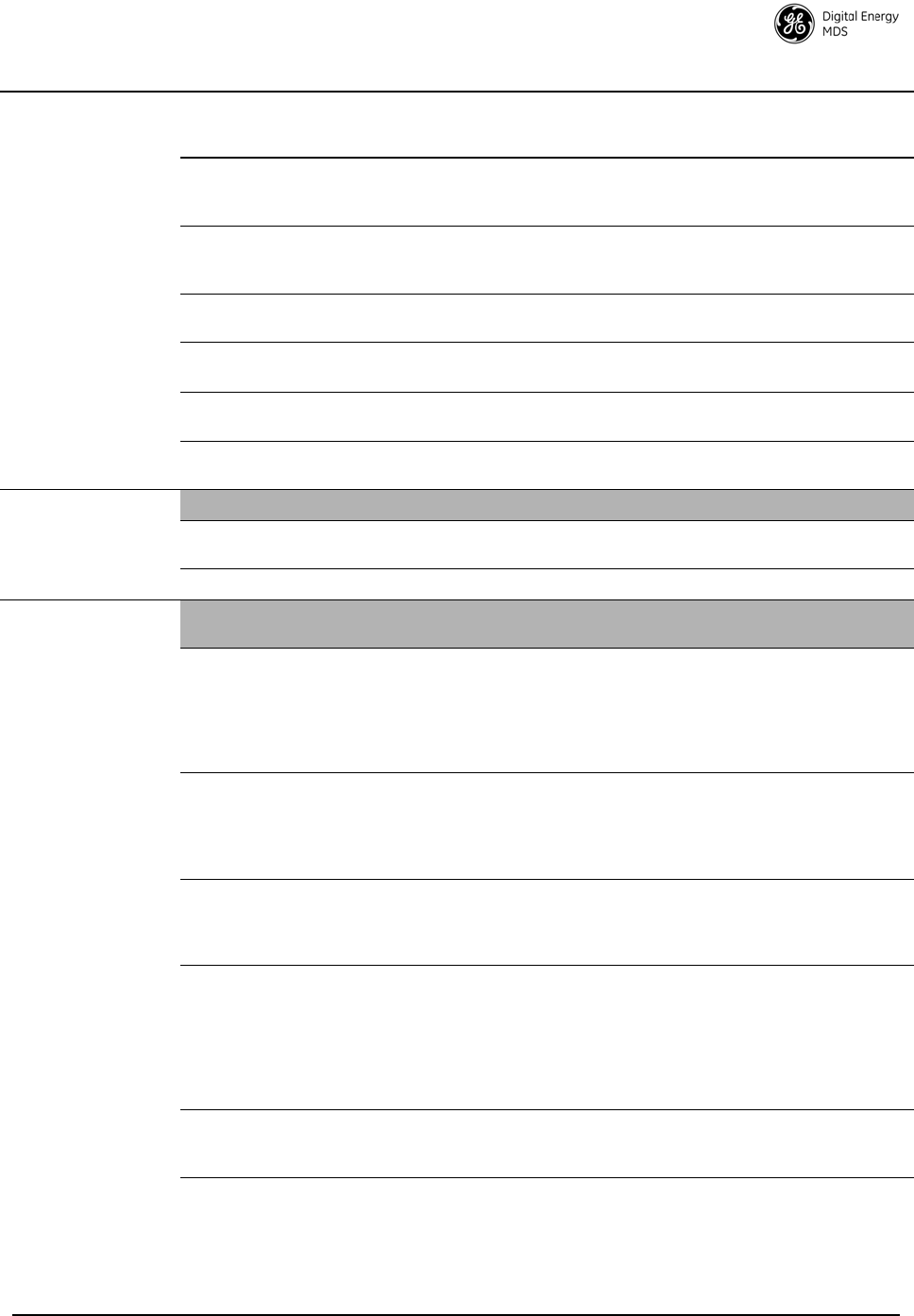
MDS 05-6302A01, Rev. B MDS Mercury 16E Technical Manual 73
TFTP Block Size The amount of data sent in each TFTP
packet.
512 byte
512, 1020, 2048, 4096,
8192 bytes
TFTP Timeout The time the client radio will wait for a
response from the server before
ending the transfer.
15 seconds
10-120 seconds
File Transfer
Username
Login username for FTP/SFTP server. Blank
0-40 characters
File Transfer
Password
Login password for FTP/SFTP server. Blank
0-40 characters
FTP Server Port Settable value for server port used in
FTP.
21
Valid ports
SFTP Server Port Settable value for server port used in
SFTP.
22
Valid ports
Radio Test Mode
Radio Mode Operation of the Radio Test Mode. Normal
Normal, Test
Test Status (no configurable items)
Maint & Status -
Configuration Files Import Configuration
File Media The File Media parameter is present on
several pages in which files are
transferred to and/or from the
transceiver. The File Media indicates
the source or the destination of the file
to be transferred.
TFTP
FTP, SFTP, TFTP, or USB
Category Sections of the configuration file to
export.
All Parameters
Modem Parameters, Radio
Parameters, Network
Parameters, QoS Service
Flows
Config Filename This is the name of the text file
containing the configuration. This
filename will be used for the file
transfer.
cfgscript.txt
Any valid filename
Host Address The Host Address parameter is
present on several pages in which files
are transferred to and/or from the
Mercury transceiver. The Host Address
is the IP address of the FTP, SFTP, or
TFTP server to be used for the file
transfer.
0.0.0.0
Any valid IP address
TFTP Timeout If TFTP is used for file transfers, the
TFTP Timeout is used to control the
protocol timeout.
15 sec
10-120 sec
Table 17. Configuration Parameters (Continued)
Menu Location Parameter Name Description Default Value
Possible Values
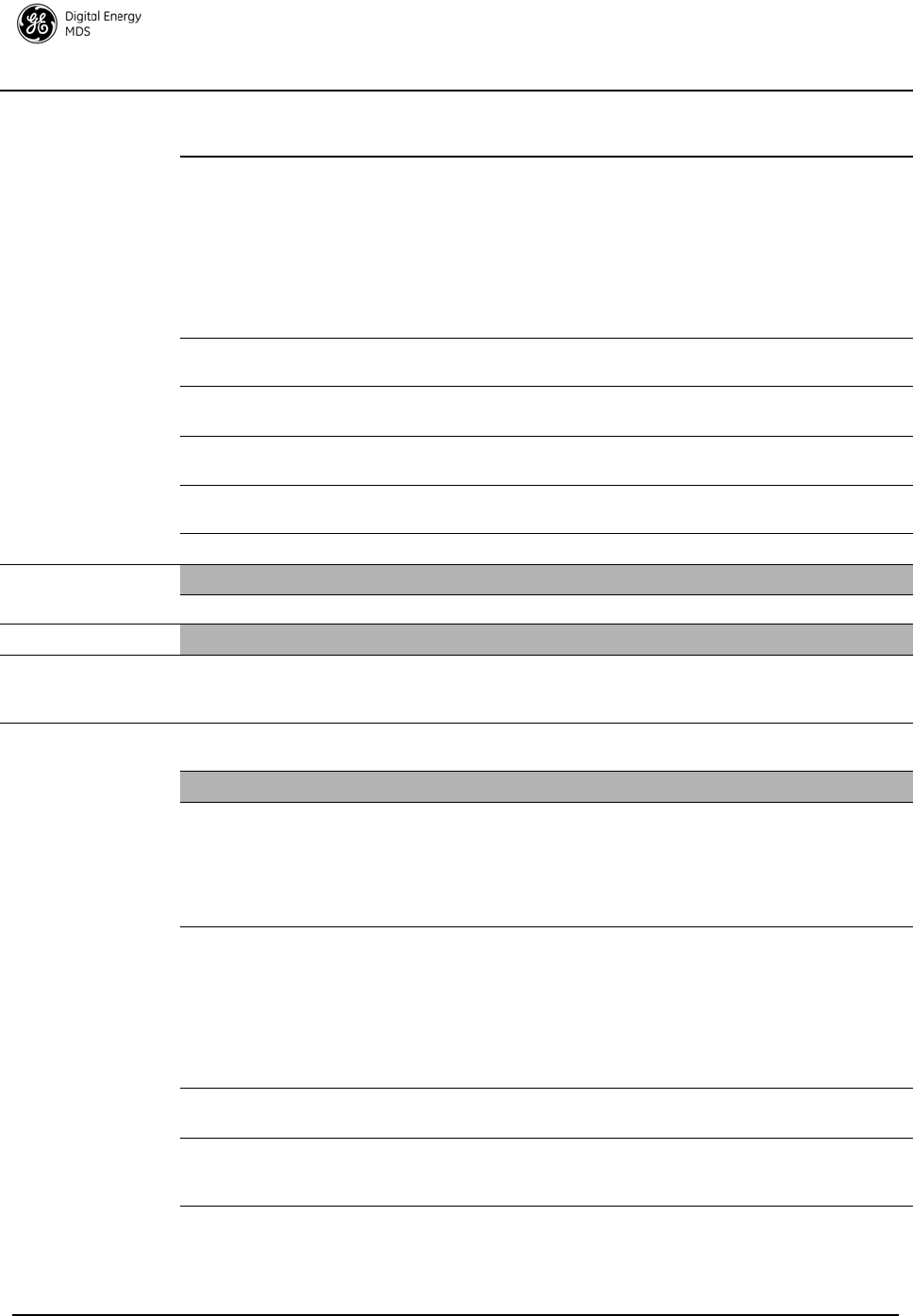
74 MDS Mercury 16E Technical Manual MDS 05-6302A01, Rev. B
TFTP Block Size If TFTP is used for file transfers, the
TFTP Block Size is used to control the
protocol transfer size. When
transferring file over wired LAN
interfaces, a block size of 4096 or 8192
will make the transfer go faster. When
transferring over a lossy wireless link,
the block size should be kept to 512 or
1024 to minimize packet retries.
512 bytes
512, 1020, 2048, 4096,
8192 bytes
File Transfer
Username
Login username for FTP/SFTP server. Blank
0-40 characters
File Transfer
Password
Login password for FTP/SFTP server. Blank
0-40 characters
FTP Server Port Settable value for server port used in
FTP.
21
Valid ports
SFTP Server Port Settable value for server port used in
SFTP.
22
Valid ports
Export Configuration
See above descriptions for Import Configuration
Scheduled Reboot
Maint & Status -
Scheduled Reboot Scheduled Mode Used to determine how scheduled
reboots will be handled.
Disabled
Single, Daily, Weekly,
Monthly
Maint & Status -
Firmware Utilities Version Information (no configurable items)
Firmware Reprogramming
File Media The File Media parameter is present on
several pages in which files are
transferred to and/or from the
transceiver. The File Media indicates
the source or the destination of the file
to be transferred.
TFTP
TFTP, USB, FTP, SFTP
Firmware Filename The filename of the firmware image to
load on the Mercury transceiver. This
file will be transferred to the device
according to the File Media parameter
on the Firmware Utilities page. The
filename will have a .mpk extension
indicating that it is a GE MDS
proprietary packed format file.
mer-bkrc-x_y_z.mpk
Valid filename
Host Address IP address of the file server. 0.0.0.0
Valid IP address
TFTP Timeout If TFTP is used for file transfers, the
TFTP Timeout is used to control the
protocol timeout.
15 sec
10-120 sec
Table 17. Configuration Parameters (Continued)
Menu Location Parameter Name Description Default Value
Possible Values

MDS 05-6302A01, Rev. B MDS Mercury 16E Technical Manual 75
TFTP Block Size If TFTP is used for file transfers, the
TFTP Block Size is used to control the
protocol transfer size. When
transferring file over wired LAN
interfaces, a block size of 4096 or 8192
will make the transfer go faster. When
transferring over a lossy wireless link,
the block size should be kept to 512 or
1024 to minimize packet retries.
512 bytes
512, 1020, 2048, 4096,
8192 bytes
File Transfer
Username
Login username for FTP/SFTP server. Blank
0-40 characters
File Transfer
Password
Login password for FTP/SFTP server. Blank
0-40 characters
FTP Server Port Settable value for server port used in
FTP.
21
Valid ports
SFTP Server Port Settable value for server port used in
SFTP.
22
Valid ports
Copy Image (no configurable items)
Verify Image (no configurable items)
Device Reboot (no configurable items)
Table 17. Configuration Parameters (Continued)
Menu Location Parameter Name Description Default Value
Possible Values

76 MDS Mercury 16E Technical Manual MDS 05-6302A01, Rev. B
9.0 dBm-WATTS-VOLTS CONVERSION
CHART
Table 18 is provided as a convenience for determining the equivalent
voltage or wattage of an RF power expressed in dBm.
Table 18. dBm-Watts-Volts conversion—for 50 ohm systems
dBm V Po
+53 100.0 200W
+50 70.7 100W
+49 64.0 80W
+48 58.0 64W
+47 50.0 50W
+46 44.5 40W
+45 40.0 32W
+44 32.5 25W
+43 32.0 20W
+42 28.0 16W
+41 26.2 12.5W
+40 22.5 10W
+39 20.0 8W
+38 18.0 6.4W
+37 16.0 5W
+36 14.1 4W
+35 12.5 3.2W
+34 11.5 2.5W
+33 10.0 2W
+32 9.0 1.6W
+31 8.0 1.25W
+30 7.10 1.0W
+29 6.40 800mW
+28 5.80 640mW
+27 5.00 500mW
+26 4.45 400mW
+25 4.00 320mW
+24 3.55 250mW
+23 3.20 200mW
+22 2.80 160mW
+21 2.52 125mW
+20 2.25 100mW
+19 2.00 80mW
+18 1.80 64mW
+17 1.60 50mW
+16 1.41 40mW
+15 1.25 32mW
+14 1.15 25mW
+13 1.00 20mW
+12 .90 16mW
+11 .80 12.5mW
+10 .71 10mW
+9 .64 8mW
+8 .58 6.4mW
+7 .500 5mW
+6 .445 4mW
+5 .400 3.2mW
+4 .355 2.5mW
+3 .320 2.0mW
+2 .280 1.6mW
+1 .252 1.25mW
dBm V Po
0.2251.0mW
-1 .200 .80mW
-2 .180 .64mW
-3 .160 .50mW
-4 .141 .40mW
-5 .125 .32mW
-6 .115 .25mW
-7 .100 .20mW
-8 .090 .16mW
-9 .080 .125mW
-10 .071 .10mW
-11 .064
-12 .058
-13 .050
-14 .045
-15 .040
-16 .0355
dBm mV Po
-17 31.5
-18 28.5
-19 25.1
-20 22.5 .01mW
-21 20.0
-22 17.9
-23 15.9
-24 14.1
-25 12.8
-26 11.5
-27 10.0
-28 8.9
-29 8.0
-30 7.1 .001mW
-31 6.25
-32 5.8
-33 5.0
-34 4.5
-35 4.0
-36 3.5
-37 3.2
-38 2.85
-39 2.5
-40 2.25 .1µW
-41 2.0
-42 1.8
-43 1.6
-44 1.4
-45 1.25
-46 1.18
-47 1.00
-48 0.90
dBm mV Po
-49 0.80
-50 0.71 .01µW
-51 0.64
-52 0.57
-53 0.50
-54 0.45
-55 0.40
-56 0.351
-57 0.32
-58 0.286
-59 0.251
-60 0.225 .001µW
-61 0.200
-62 0.180
-63 0.160
-64 0.141
dBm µV Po
-65 128
-66 115
-67 100
-68 90
-69 80
-70 71 .1nW
-71 65
-72 58
-73 50
-74 45
-75 40
-76 35
-77 32
-78 29
-79 25
-80 22.5 .01nW
-81 20.0
-82 18.0
-83 16.0
-84 11.1
-85 12.9
-86 11.5
-87 10.0
-88 9.0
-89 8.0
-90 7.1 .001nW
-91 6.1
-92 5.75
-93 5.0
-94 4.5
-95 4.0
-96 3.51
-97 3.2
dBm µV Po
-98 2.9
-99 2.51
-100 2.25 .1pW
-101 2.0
-102 1.8
-103 1.6
-104 1.41
-105 1.27
-106 1.18
dBm nV Po
-107 1000
-108 900
-109 800
-110 710 .01pW
-111 640
-112 580
-113 500
-114 450
-115 400
-116 355
-117 325
-118 285
-119 251
-120 225 .001pW
-121 200
-122 180
-123 160
-124 141
-125 128
-126 117
-127 100
-128 90
-129 80 .1ƒW
-130 71
-131 61
-132 58
-133 50
-134 45
-135 40
-136 35
-137 33
-138 29
-139 25
-140 23 .01ƒW

MDS 05-6302A01, Rev. B MDS Mercury 16E Technical Manual 77
APPENDIX-A
3650 MHz Band Information
Band History
• Historically part of the Fixed Service Satellite (FSS) allocation
• FSS operators are considered “grandfathered” operations and
are provided protection in the form of “exclusion zones”
• About 85 users remain, mostly on East and West Coasts of U.S.
• Over 20 states with no grandfathered operations in effect
• Recently, the FCC allocated 50 MHz of this spectrum (3.65 –
3.70 GHz) for private infrastructure and rural ISP use—not con-
sumer mass deployment
• 3650 MHz is considered a “registered” band. It is neither
licensed nor unlicensed
• Industry Canada rules patterned after FCC rules
Technical Details
• 50 MHz spectrum divided in two bands of 25MHz each
• Lower 25 MHz allows “Restricted protocols,” upper 25MHz
allows “Unrestricted”
• Operation requires registration with FCC database – operators,
all fixed point installations
• EIRP: One watt per-MHz for fixed deployments. 40 mW
per-MHz for mobile operation.
• Industry Canada rules allow “Restricted protocols” across the
entire 50 MHz span.
Exclusion Zones
Maps showing exclusion zones in the U.S. are available online.
Exclusion zones contain grandfathered operations which must be
protected from 3650 MHz interference. At the time of publication, one
such map is available at the following URL:
www.spectrumgenie.com/esmap.asp

78 MDS Mercury 16E Technical Manual MDS 05-6302A01, Rev. B

MDS 05-6302A01, Rev. B MDS Mercury 16E Technical Manual 79
APPENDIX-B
Glossary of Terms & Abbreviations
If you are new to wireless IP/Ethernet systems, some of the terms used
in this guide may be unfamiliar. The following glossary explains many
of these terms and will prove helpful in understanding the operation of
your radio network. While not all of these terms apply to every use of
the transceiver, they are provided to give a more complete
understanding of common wireless concepts.
Antenna System Gain—A figure, normally expressed in dB, repre-
senting the power increase resulting from the use of a gain-type antenna.
System losses (from the feedline and coaxial connectors, for example)
are subtracted from this figure to calculate the total antenna system gain.
BS—See Base Station.
Association—Condition in which the Subscriber is synchronized with
the Base Station and is ready to pass traffic.
Authorization Key—Alphanumeric string (code) that is used to enable
additional capabilities in the transceiver.
Base Station (BS)—The radio in a point-to-multipoint network that acts
as the center or “hub” station. It communicates with Subscriber Unit
(SU) stations.
Bit—The smallest unit of digital data, often represented by a one or a
zero. Eight bits (plus start, stop, and parity bits) usually comprise a byte.
Bits-per-second—See BPS.
BPDU—Bridge Protocol Data Units.
BPS—Bits-per-second (bps). A measure of the information transfer rate
of digital data across a communication channel.
Byte—A string of digital data usually made up of eight data bits and
start, stop and parity bits.
CSMA/CA—Carrier Sense Multiple Access/Collision Avoidance.
CSMA/CD—Carrier Sense Multiple Access/Collision Detection.

80 MDS Mercury 16E Technical Manual MDS 05-6302A01, Rev. B
Cyclic Redundancy Check (CRC)—A technique used to verify data
integrity. It is based on an algorithm which generates a value derived
from the number and order of bits in a data string. This value is com-
pared with a locally-generated value and a match indicates that the mes-
sage is unchanged, and therefore valid.
Datagram—A data string consisting of an IP header and the IP message
within.
dBi—Decibels referenced to an “ideal” isotropic radiator in free space.
Frequently used to express antenna gain.
dBm—Decibels referenced to one milliwatt. An absolute unit used to
measure signal power, as in transmitter power output, or received signal
strength.
DCE—Data Circuit-terminating Equipment (or Data Communications
Equipment). In data communications terminology, this is the “modem”
side of a computer-to-modem connection. COM1 Port of the transceiver
is set as DCE.
Decibel (dB)—A measure of the ratio between two signal levels. Fre-
quently used to express the gain (or loss) of a system.
Delimiter—A flag that marks the beginning and end of a data packet.
DHCP (Dynamic Host Configuration Protocol)—An Internet stan-
dard that allows a client (i.e. any computer or network device) to obtain
an IP address from a server on the network. This allows network admin-
istrators to avoid the tedious process of manually configuring and man-
aging IP addresses for a large number of users and devices. When a
network device powers on, if it is configured to use DHCP, it will con-
tact a DHCP server on the network and request an IP address.
The DHCP server will provide an address from a pool of addresses allo-
cated by the network administrator. The network device may use this
address on a “time lease” basis or indefinitely depending on the policy
set by the network administrator. The DHCP server can restrict alloca-
tion of IP addresses based on security policies. An Access Point may be
configured by the system administrator to act as a DHCP server if one is
not available on the wired network.
DTE—Data Terminal Equipment. A device that provides data in the
form of digital signals at its output. Connects to the DCE device.
Encapsulation—Process in by which, a complete data packet, such as
Modbus frame or any other polled asynchronous protocol frame, is
placed in the data portion of another protocol frame (in this case IP) to
be transported over a network. Typically this action is done at the receiv-
ing end, before being sent as an IP packet to a network. A similar re-

MDS 05-6302A01, Rev. B MDS Mercury 16E Technical Manual 81
versed process is applied at the other end of the network extracting the
data from the IP envelope, resulting in the original packet in the original
protocol.
Endpoint—IP address of data equipment connected to the ports of the
radio.
Equalization—The process of reducing the effects of amplitude, fre-
quency or phase distortion with compensating networks.
Fade Margin—The greatest tolerable reduction in average received
signal strength that will be anticipated under most conditions. Provides
an allowance for reduced signal strength due to multipath, slight antenna
movement or changing atmospheric losses. A fade margin of 15 to 20
dB is usually sufficient in most systems.
Fragmentation—A technique used for breaking a large message down
into smaller parts so it can be accommodated by a less capable media.
Frame—A segment of data that adheres to a specific data protocol and
contains definite start and end points. It provides a method of synchro-
nizing transmissions.
Hardware Flow Control—A transceiver feature used to prevent data
buffer overruns when handling high-speed data from the connected data
communications device. When the buffer approaches overflow, the
radio drops the clear-to-send (CTS) line, that instructs the connected
device to delay further transmission until CTS again returns to the high
state.
Host Computer—The computer installed at the master station site, that
controls the collection of data from one or more remote sites.
HTTP—Hypertext Transfer Protocol.
ICMP—Internet Control Message Protocol.
IGMP (Internet Gateway Management Protocol)—Ethernet level
protocol used by routers and similar devices to manage the distribution
of multicast traffic in a network.
IEEE—Institute of Electrical and Electronic Engineers.
Image (File)—Data file that contains the operating system and other
essential resources for the basic operation of the radio’s CPU.
LAN—Local Area Network.
Latency—The delay (usually expressed in milliseconds) between when
data is applied at the transmit port at one radio, until it appears at the
receive port at the other radio.

82 MDS Mercury 16E Technical Manual MDS 05-6302A01, Rev. B
MAC—Media Access Control.
MD5—A highly secure data encoding scheme. MD5 is a one-way hash
algorithm that takes any length of data and produces a 128 bit “finger-
print.” This fingerprint is “non-reversible,” it is computationally infea-
sible to determine the file based on the fingerprint. For more details
review RFC 1321 using an Internet search.
MCU—Microcontroller Unit.
MIB—Management Information Base.
MIMO—Multiple In / Multiple Out.
Mobile Station—Refers to a station that moves about while main-
taining active connections with the network. Mobility generally implies
physical motion. The movement of the station is not limited to a specific
network and IP subnet. In order for a station to be mobile it must estab-
lish and tear down connections with various access points as it moves
through the access points' territory.
MTBF—Mean-Time Between Failures.
Multiple Address System (MAS)—See Point-Multipoint System.
Network-Wide Diagnostics—An advanced method of controlling and
interrogating GE MDS radios in a radio network.
NTP—Network Time Protocol.
OFDM—Orthogonal Frequency Division Multiplex.
Packet—The basic unit of data carried on a link layer. On an IP net-
work, this refers to an entire IP datagram or a fragment thereof.
Scanning—Scanning is a process used by Subscribers to detect Base
Stations on the network to which it may connect.
PING—Packet INternet Groper. Diagnostic message generally used to
test reachability of a network device, either over a wired or wireless net-
work.
Point-Multipoint System—A radio communications network or
system designed with a central control station that exchanges data with
a number of remote locations equipped with terminal equipment.
Poll—A request for data issued from the host computer (or master PLC)
to a remote radio.
Portability—A station is considered connected when it has successfully
authenticated and associated with an access point. A station is consid-

MDS 05-6302A01, Rev. B MDS Mercury 16E Technical Manual 83
ered authenticated when it has agreed with the access point on the type
of encryption that will be used for data packets traveling between them.
The process of association causes a station to be bound to an access
point and allows it to receive and transmit packets to and from the access
point. In order for a station to be associated it must first authenticate
with the access point. The authentication and association processes
occur automatically without user intervention.
Portability refers to the ability of a station to connect to an access point
from multiple locations without the need to reconfigure the network set-
tings. For example, a remote transceiver that is connected to an access
point may be turned off, moved to new site, turned back on, and,
assuming the right information is entered, can immediately reconnect to
the access point without user intervention.
PLC—Programmable Logic Controller. A dedicated microprocessor
configured for a specific application with discrete inputs and outputs. It
can serve as a host or as an RTU.
PuTTY—A free implementation of Telnet and SSH for Win32 and
Unix platforms. It is written and maintained primarily by Simon Tatham
Refer to http://www.pobox.com/~anakin/ for more information.
Remote—A transceiver in a network that communicates with an asso-
ciated Access Point.
RFI—Radio Frequency Interference.
Roaming—A station's ability to automatically switch its wireless con-
nection between various access points (APs) as the need arises. A station
may roam from one AP to another because the signal strength or quality
of the current AP has degraded below what another AP can provide.
When two access points are co-located for redundancy, roaming allows
the stations to switch between them to provide a robust network.
Roaming may also be employed in conjunction with Portability where
the station has been moved beyond the range of the original AP to which
it was connected. As the station comes in range of a new AP, it will
switch its connection to the stronger signal. Roaming refers to a station's
logical, not necessarily physical, move between access points within a
specific network and IP subnet.
RSSI—Received Signal Strength Indicator.
RTU—Remote Terminal Unit. A data collection device installed at a
remote radio site.
SCADA—Supervisory Control And Data Acquisition. An overall term
for the functions commonly provided through an MAS radio system.

84 MDS Mercury 16E Technical Manual MDS 05-6302A01, Rev. B
SCEP—Simple Certificate Enrollment Protocol. A protocol that auto-
mates the provisioning process of creating and loading x.509 digital cer-
tificates on a device.
SFTP—Secure File Transfer Protocol. A networking protocol used to
securely transfer files between a server and a client device.
SNMP—Simple Network Management Protocol.
SNR—Signal-to-Noise Ratio. A measurement of the desired signal to
ambient noise levels.This measurement provides a relative indication of
signal quality. Because this is a relative number, higher signal-to-noise
ratios indicate improved performance.
SNTP—Simple Network Time Protocol.
SSL—Secure Socket Layer.
SSH—Secure Shell.
STP—Spanning Tree Protocol.
Subscriber Unit (SU)—A radio in a point-to-multipoint network that
acts as a remote, and communicates with the Base Station (BS).
SWR—Standing-Wave Ratio. A parameter related to the ratio between
forward transmitter power and the reflected power from the antenna
system. As a general guideline, reflected power should not exceed 10%
of the forward power ( 2:1 SWR).
TCP—Transmission Control Protocol.
TFTP—Trivial File Transfer Protocol.
Trap Manager—Software that collects SNMP traps for display or log-
ging of events.
UDP—User Datagram Protocol.
UTP—Unshielded Twisted Pair.
VLAN—Virtual Local Area Network.
WINS—Windows Internet Naming Service. Part of Microsoft Win-
dows NT and 2000 servers that manages the association of workstation
names and locations with Internet Protocol addresses. It works without
the user or an administrator having to be involved in each configuration
change. Similar to DNS.
X.509 Certificates—A standardized format for digital certificates used
in security protocols and algorithms.

IN CASE OF DIFFICULTY...
GE MDS products are designed for long life and trouble-free operation. However, this equipment,
as with all electronic equipment, may have an occasional component failure. The following infor-
mation will assist you in the event that servicing becomes necessary.
TECHNICAL ASSISTANCE
Technical assistance for GE MDS products is available from our Technical Support Department
during normal business hours (U.S. Eastern Time). When calling, please give the complete model
number of the radio, along with a description of the trouble/symptom(s) that you are experiencing.
In many cases, problems can be resolved over the telephone, without the need for returning the
unit to the factory. Please use one of the following means for product assistance:
Phone: 585 241-5510 E-Mail: gemds.techsupport@ge.com
FAX: 585 242-8369 Web: www.gemds.com
FACTORY SERVICE
Component level repair of equipment is not recommended in the field. Many components are
installed using surface mount technology, which requires specialized training and equipment for
proper servicing. For this reason, the equipment should be returned to the factory for any PC board
repairs. The factory is best equipped to diagnose, repair and align your unit to its proper operating
specifications.
If return of the equipment is necessary, you will be issued a Service Request Order (SRO) number.
The SRO number will help expedite the repair so that the equipment can be repaired and returned
to you as quickly as possible. Please be sure to include the SRO number on the outside of the ship-
ping box, and on any correspondence relating to the repair. No equipment will be accepted for
repair without an SRO number.
A statement should accompany the unit describing, in detail, the trouble symptom(s), and a
description of any associated equipment normally connected to it. It is also important to include
the name and telephone number of a person in your organization who can be contacted if addi-
tional information is required. Note: A backup copy of the product’s programming code should be
retained (if applicable), as units are normally returned from the factory in a default state.
The unit must be properly packed for return to the factory. The original shipping container and
packaging materials should be used whenever possible. All factory returns should be addressed to:
GE MDS
Product Services Department
(SRO No. XXXX)
175 Science Parkway
Rochester, NY 14620 USA
When repairs have been completed, the equipment will be returned to you by the same shipping
method used to send it to the factory. Please specify if you wish to make different shipping
arrangements. To inquire about an in-process repair, you may contact our Product Services Group
at 585-241-5540 (FAX: 585-242-8400), or via e-mail at gemds.productservices@ge.com.

GE MDS, LLC
Rochester, NY 14620
Telephone: +1 585 242-9600
FAX: +1 585 242-9620
www.gemds.com
175 Science Parkway